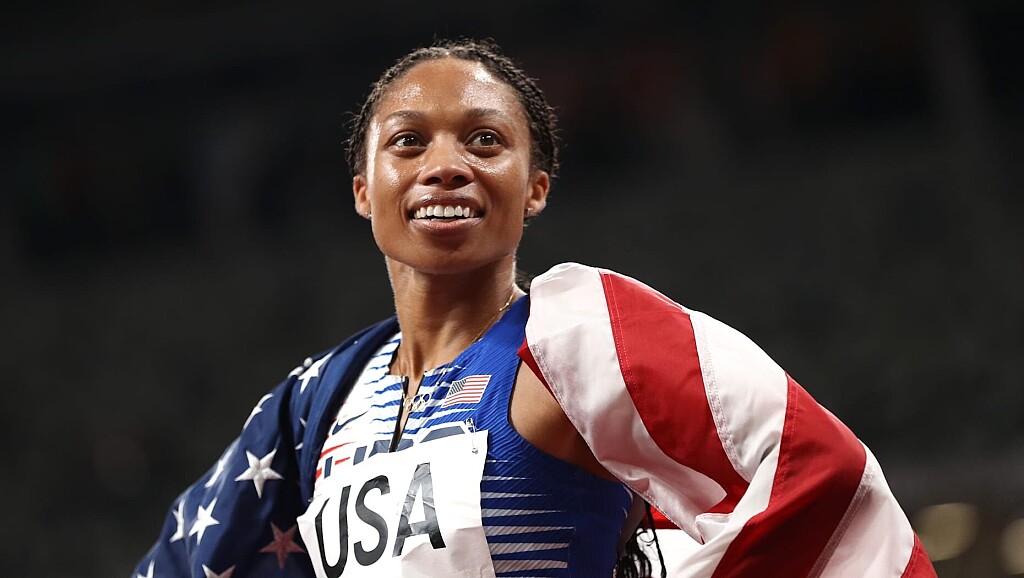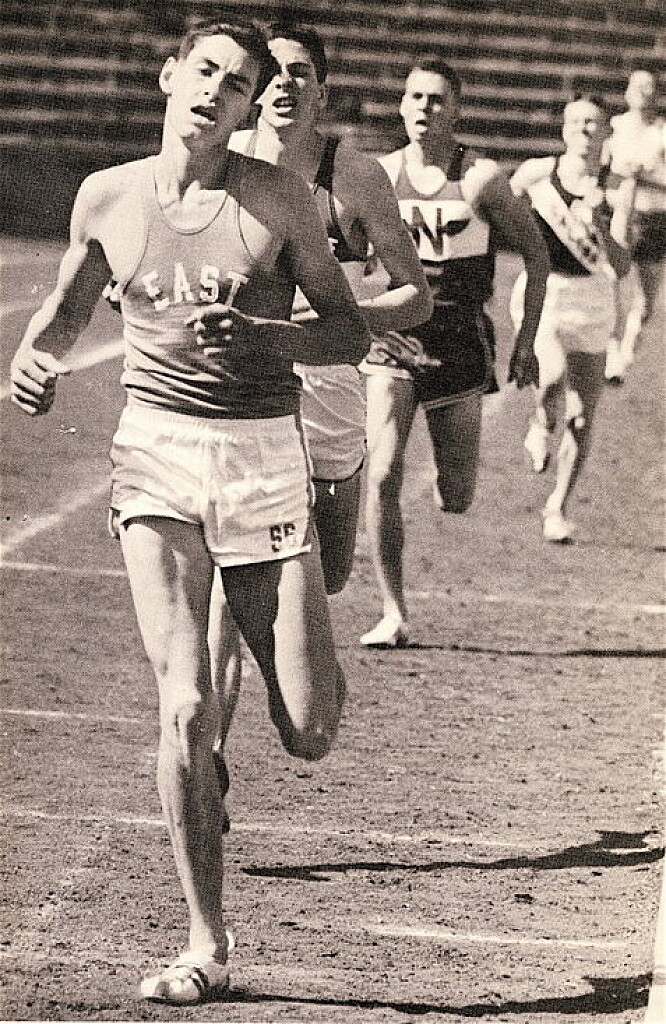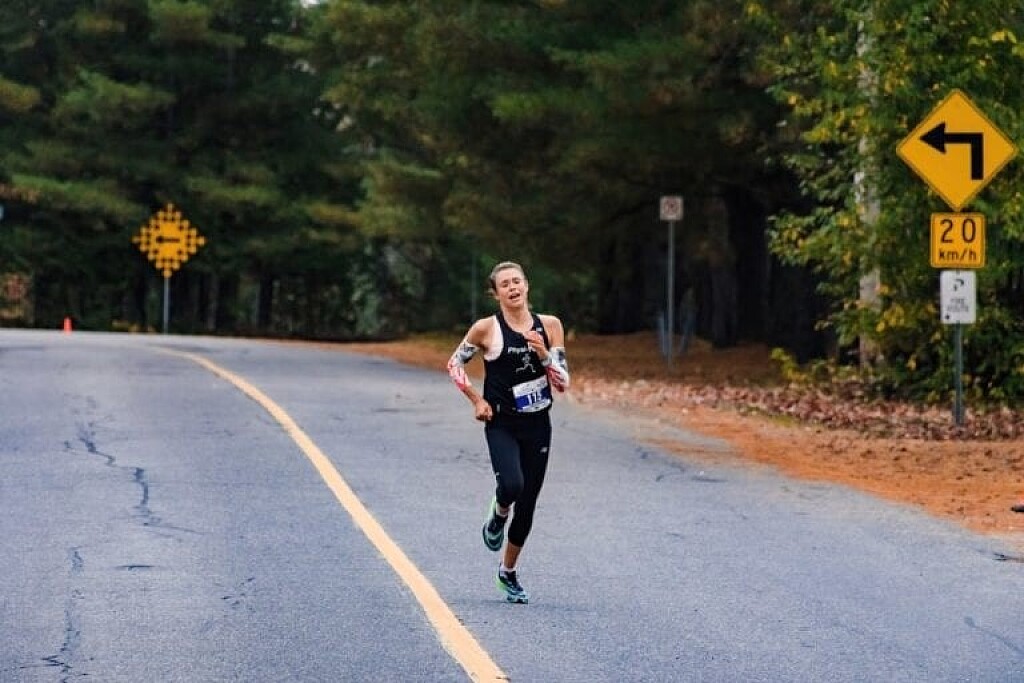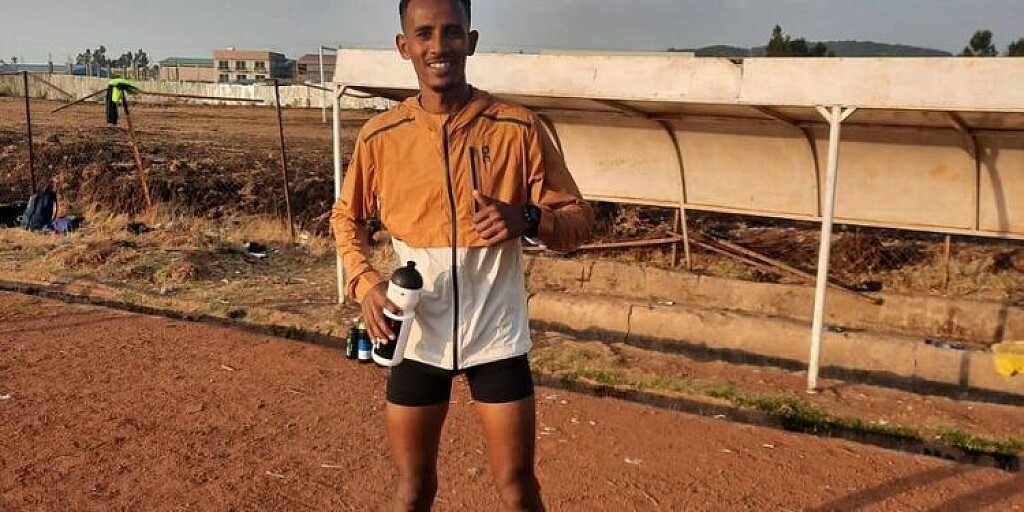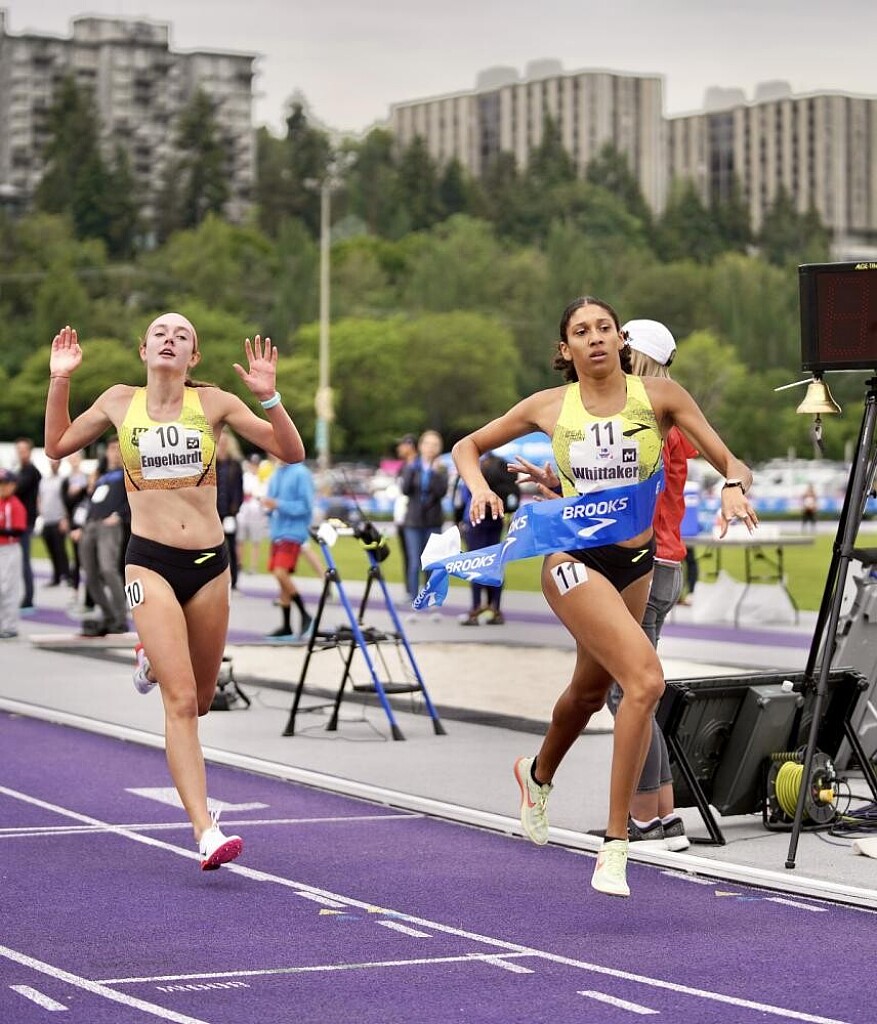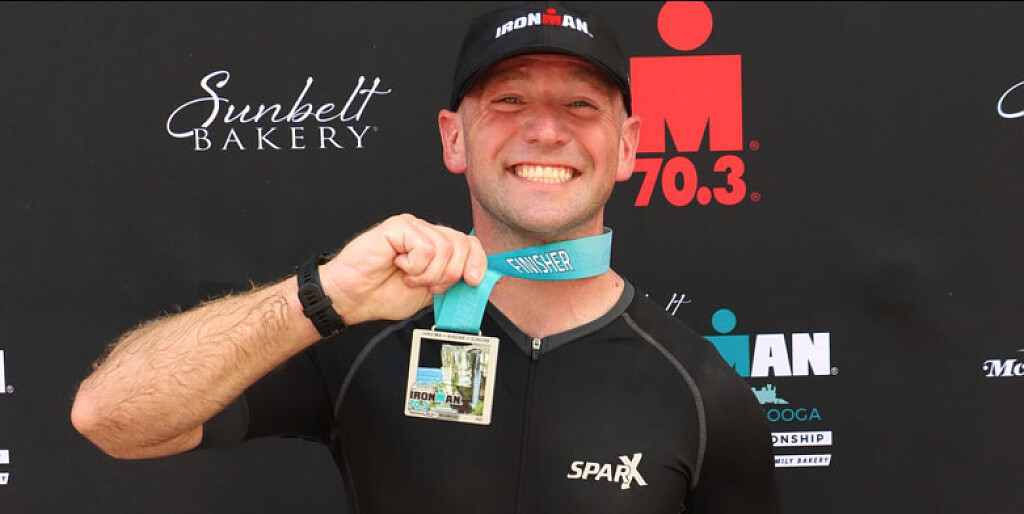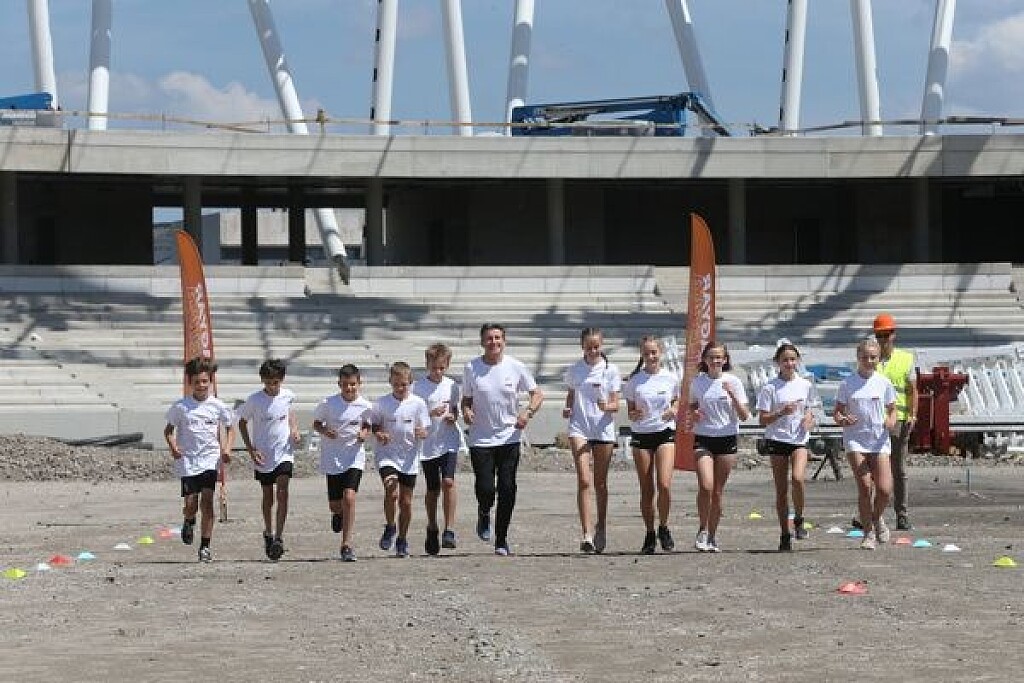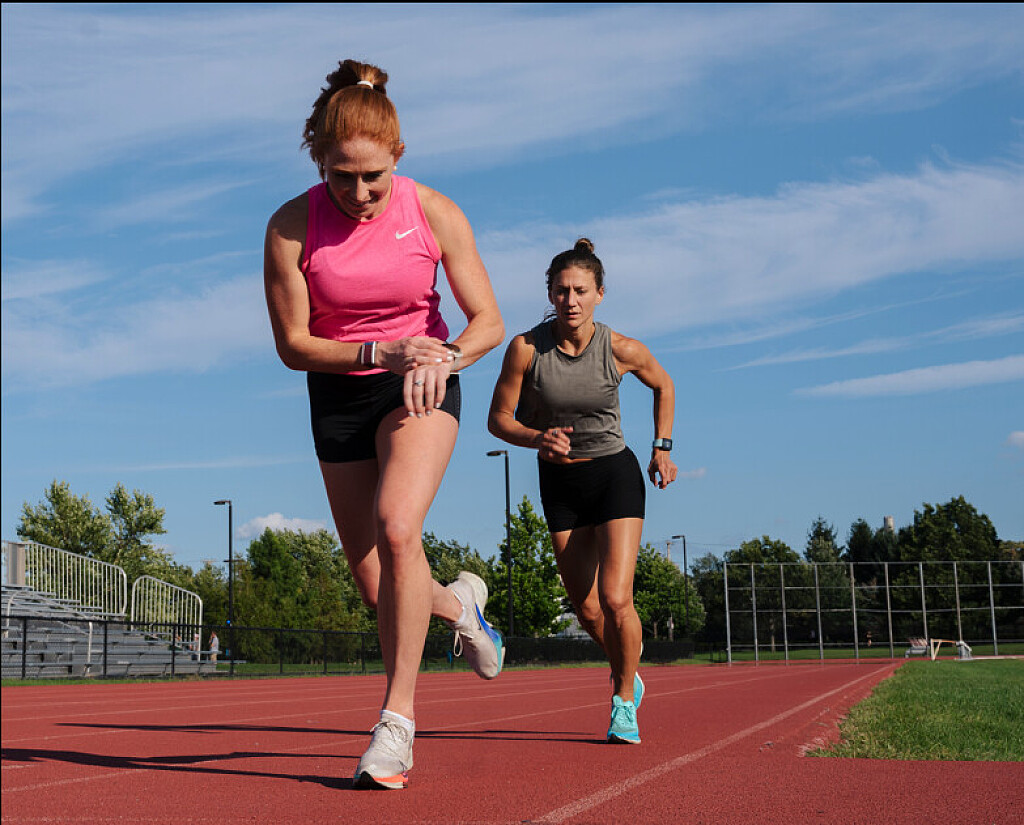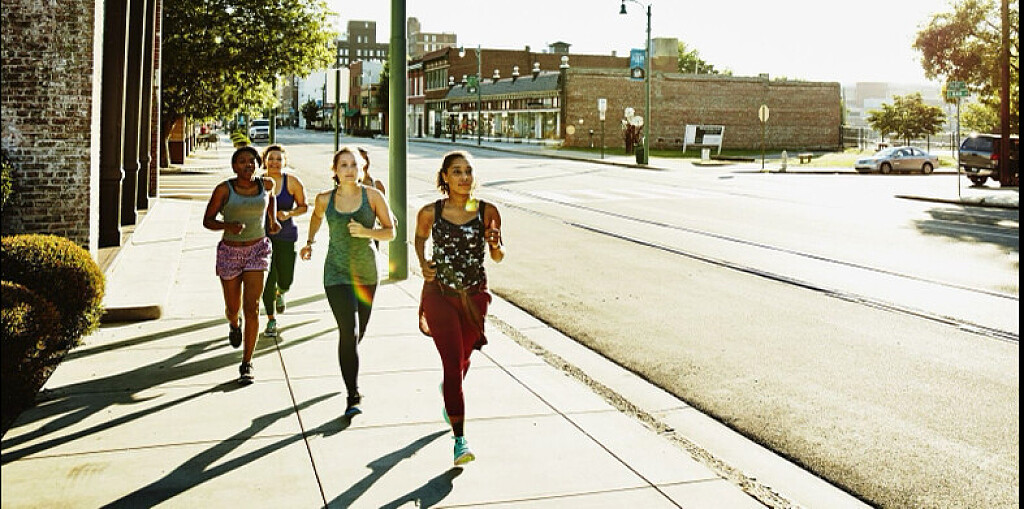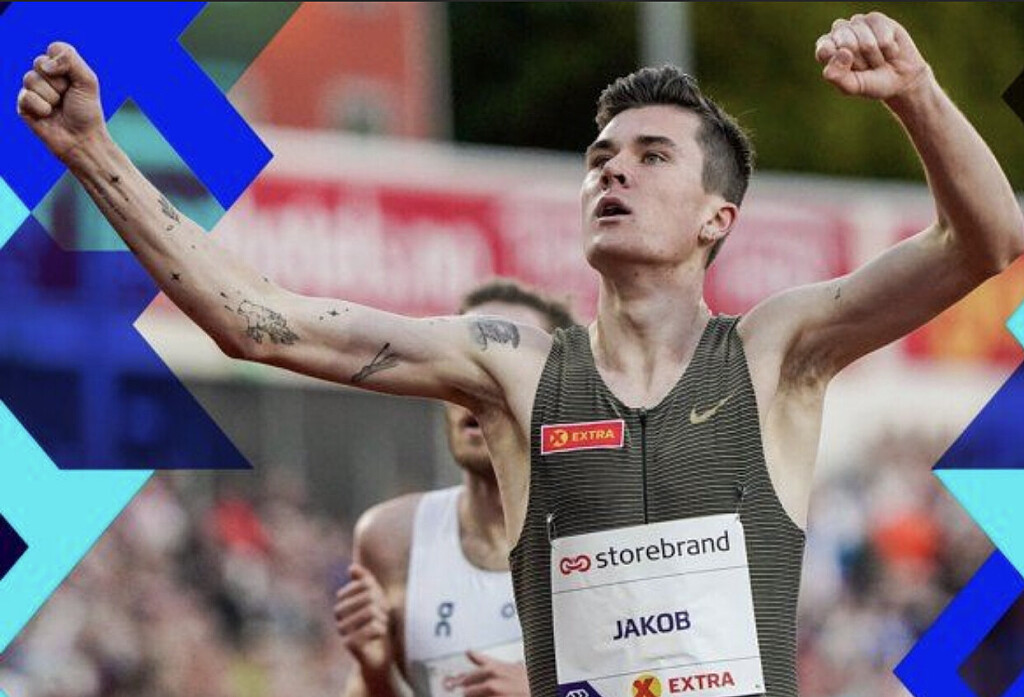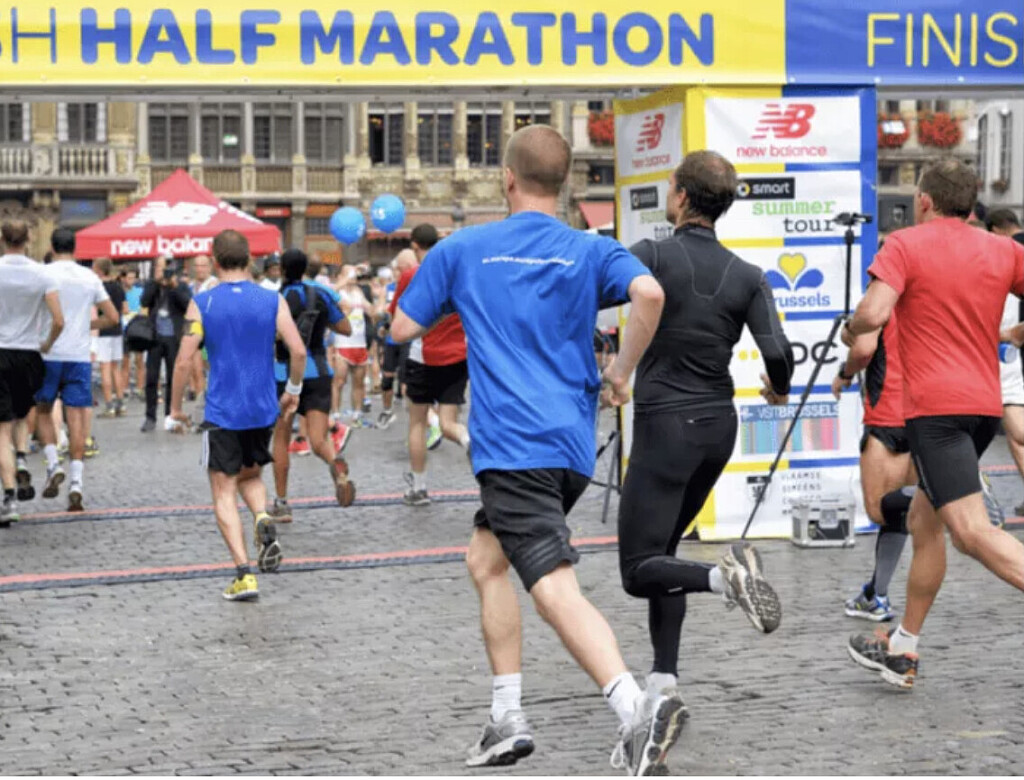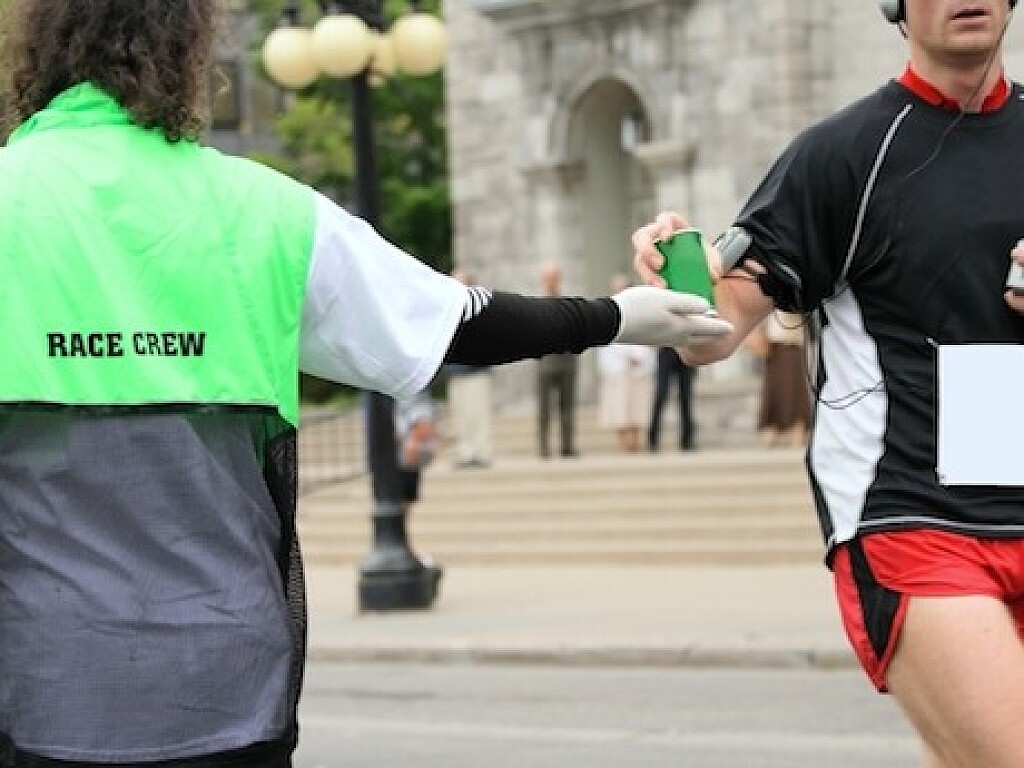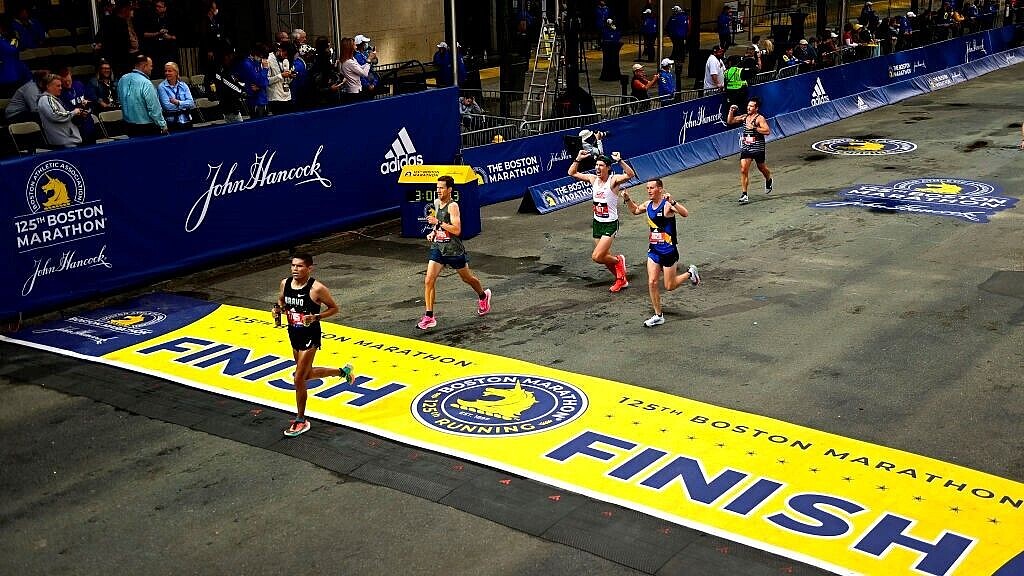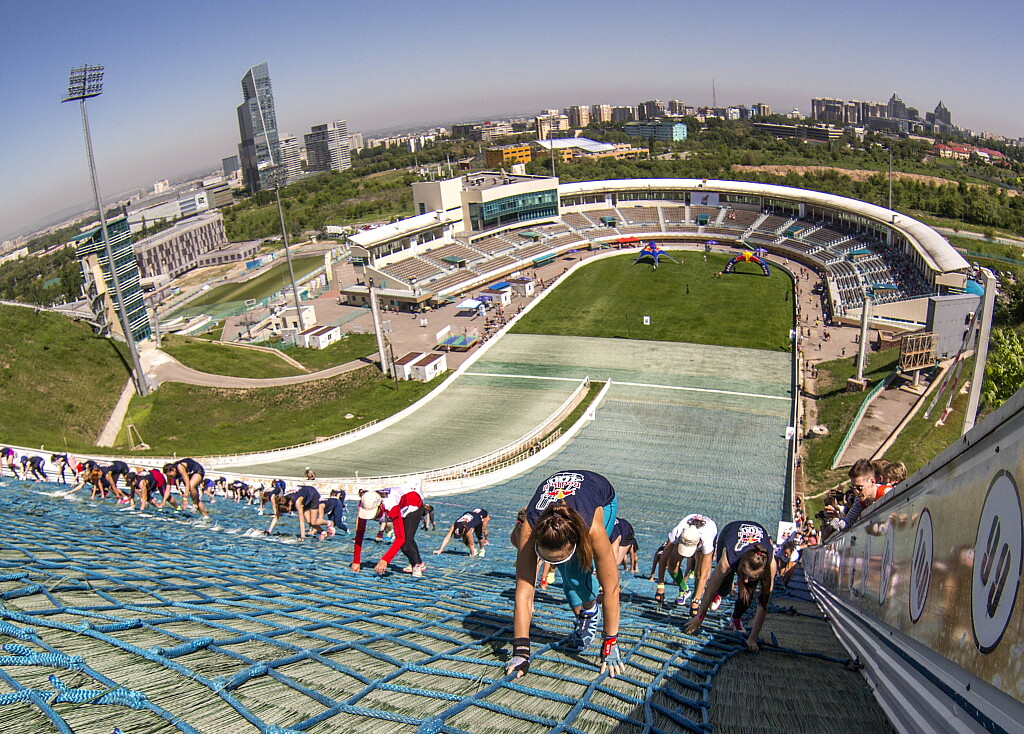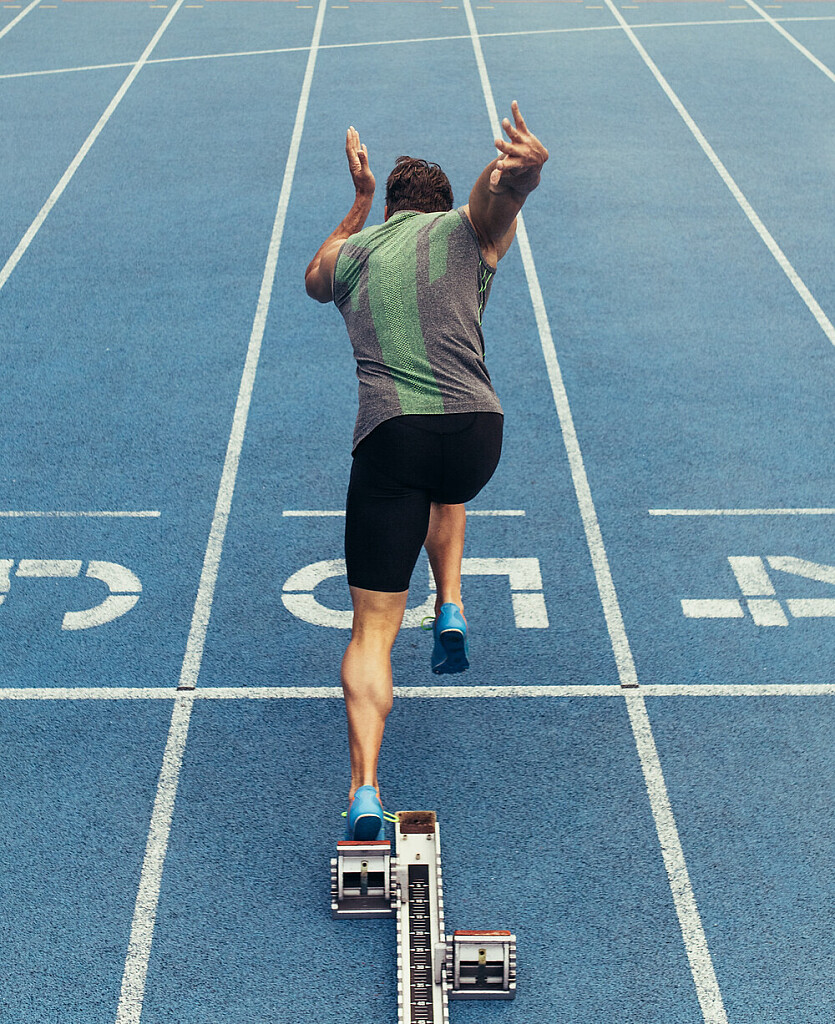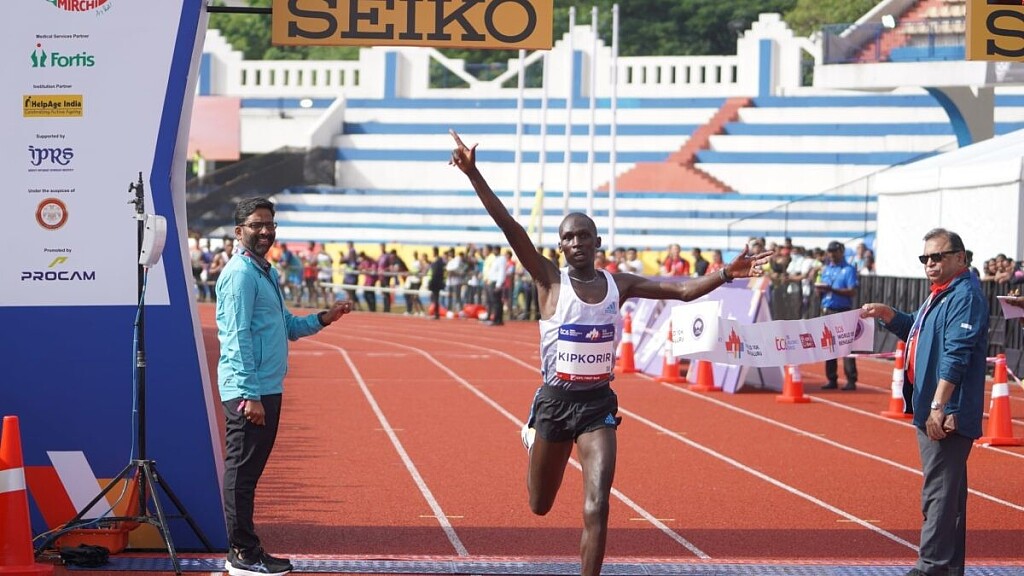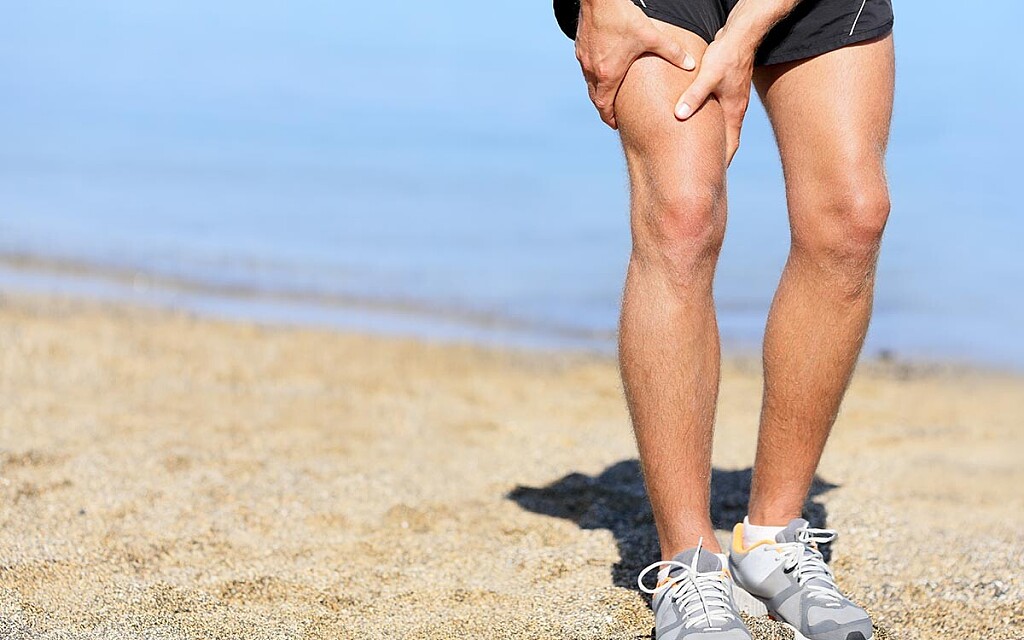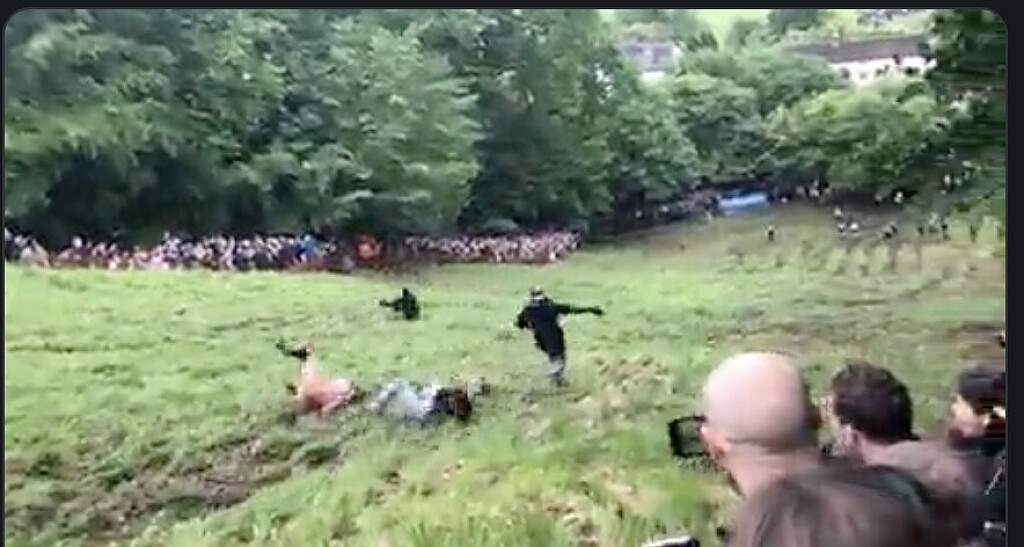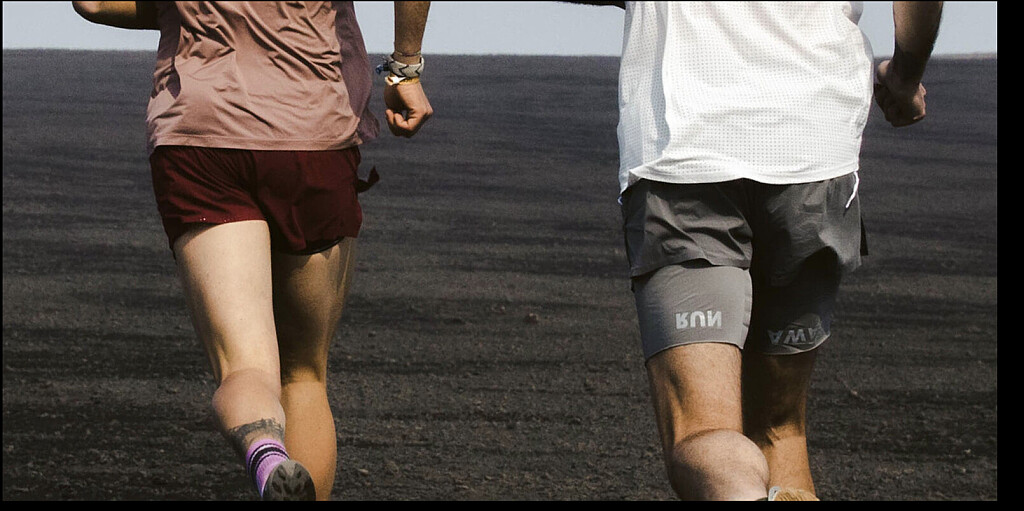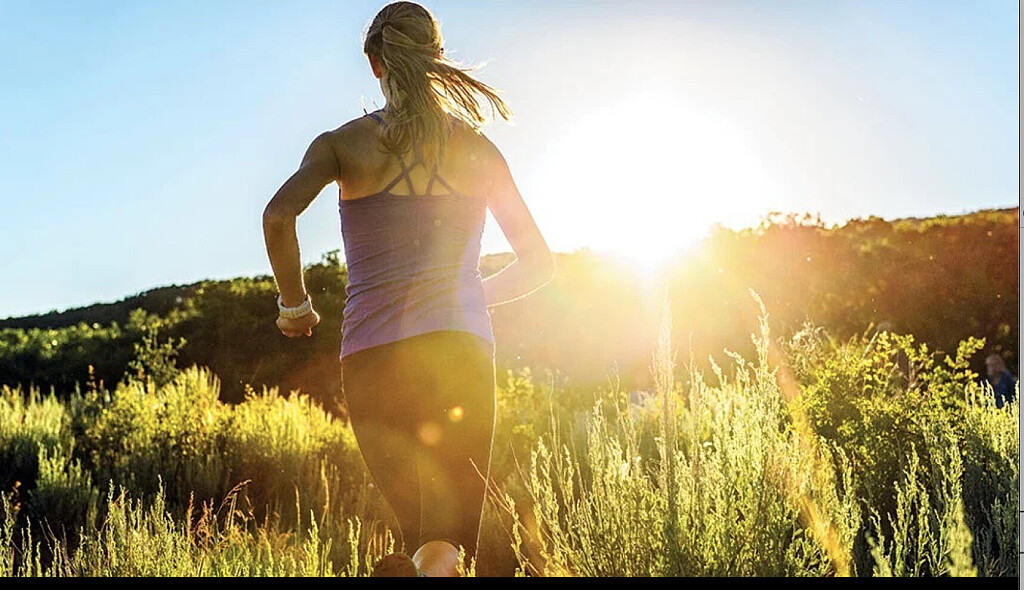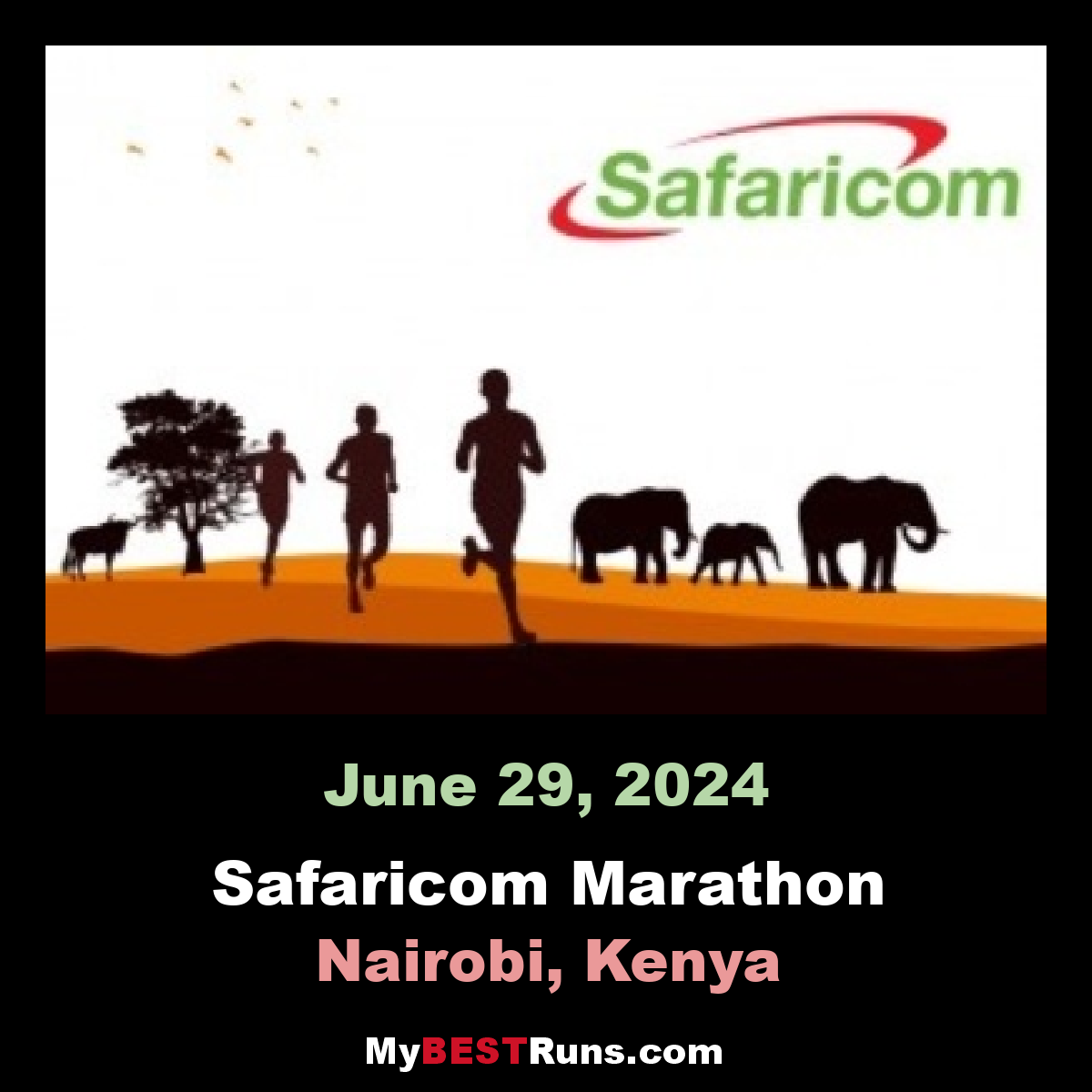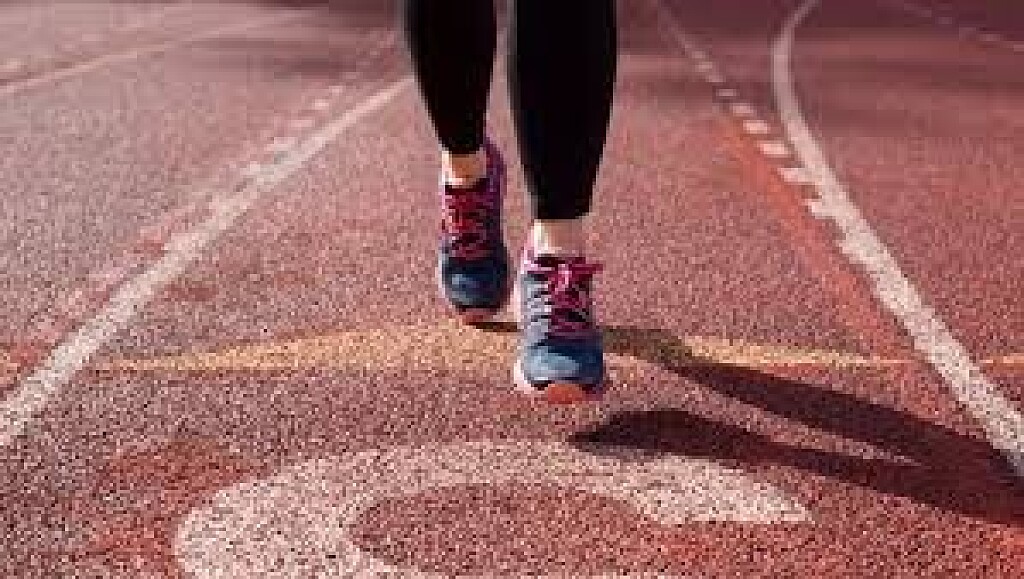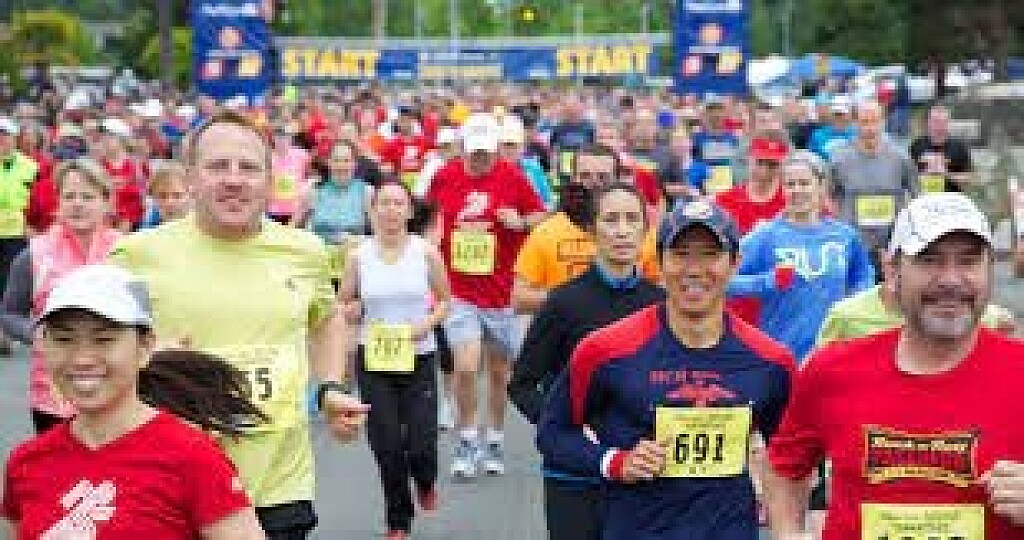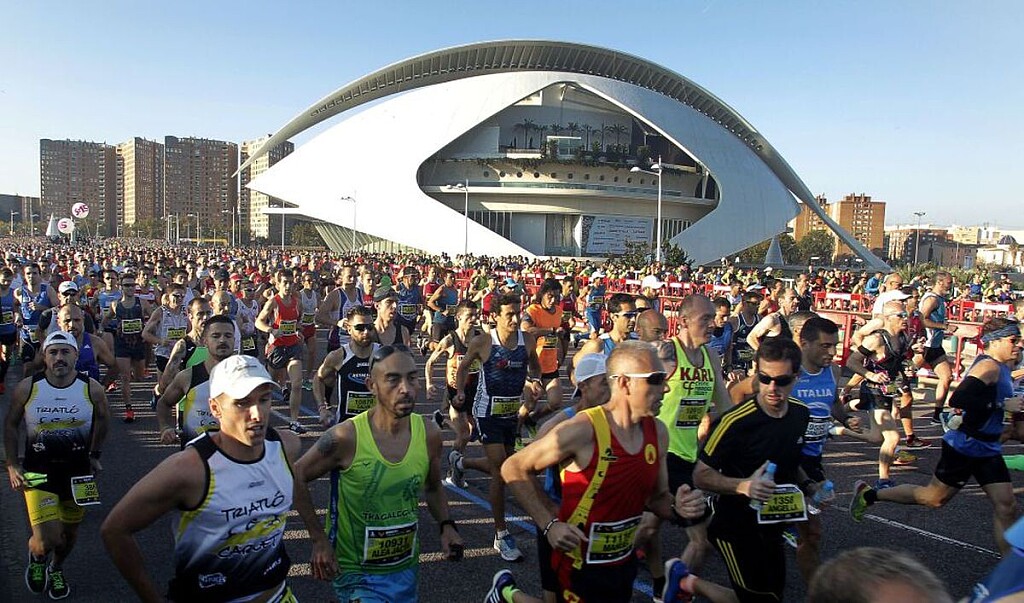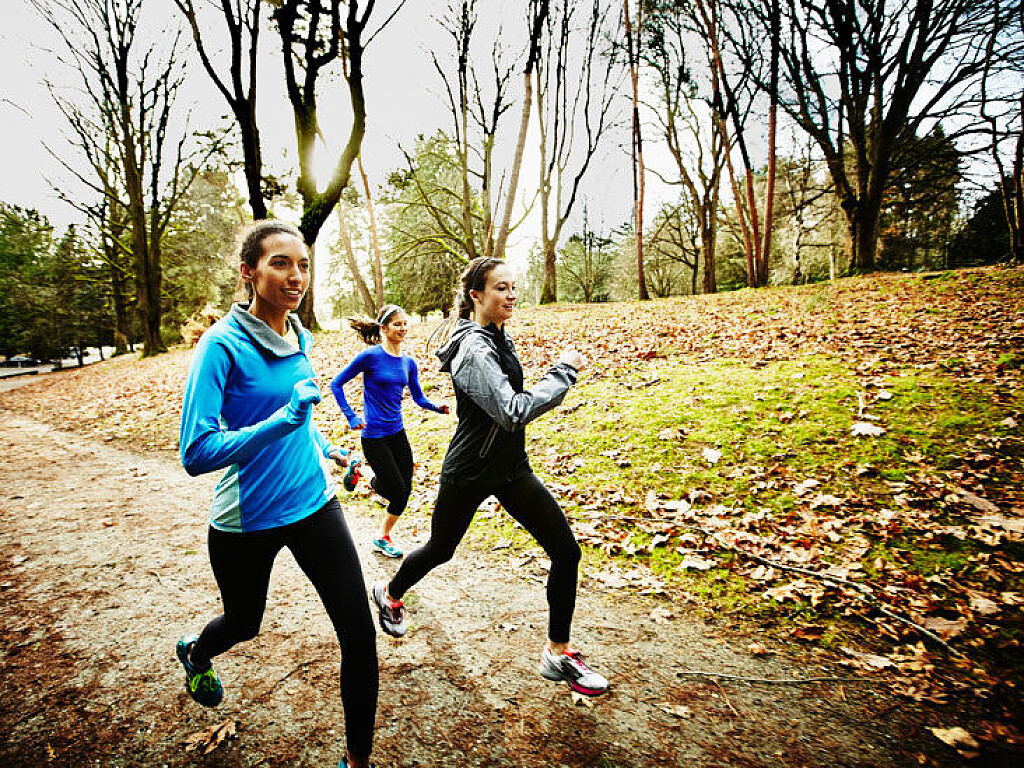Running News Daily
Running News Daily is edited by Bob Anderson in Mountain View, California USA and team in Thika Kenya, La Piedad Mexico, Bend Oregon, Chandler Arizona and Monforte da Beira Portugal. Send your news items to bob@mybestruns.com Advertising opportunities available. Over one million readers and growing. Train the Kenyan Way at KATA Running Retreat Kenya. (Kenyan Athletics Training Academy) in Thika Kenya. Opening in june 2024 KATA Running retreat Portugal. Learn more about Bob Anderson, MBR publisher and KATA director/owner, take a look at A Long Run the movie covering Bob's 50 race challenge.
Index to Daily Posts · Sign Up For Updates · Run The World Feed
USATF 2022 Outdoor Championships schedule
The Nation’s best will leave it all on the track June 23-26 as they compete for a spot on the world’s best track and field team.
The meet will be held at Hayward Field at the University of Oregon. This will be the tenth time that the U.S. championship meet will be staged in TrackTown USA. The meet will also serve as the qualifying event for the 2022 World Athletics Championships Oregon22, set for July 15–24.
USATF 2022 Outdoor Championships schedule (times are PDT)

Day 1: Thursday 23 June
4:00 p.m. 800m Men First Round
4:25 p.m. 800m Women First Round
4:50 p.m. 400m Hurdles Women First Round
5:00 p.m. Hammer Throw Women Final
5:15 p.m. Long Jump Women Final
5:15 p.m. 100m Women First Round
5:40 p.m. 100m Men First Round
5:45 p.m. Discus Throw Men Final
6:05 p.m. 3000m Steeplechase Men First Round
6:35 p.m. 1500m Men First Round
6:53 p.m. 1500m Women First Round
7:11 p.m. 400m Women First Round
7:36 p.m. 400m Men First Round
Day 2: Friday 24 June
5:10 p.m. 100m Hurdles Women First Round
5:35 p.m. 100m Women Semi-Final
5:45 p.m. Long Jump Men Final
5:50 p.m. 100m Men Semi-Final
5:55 p.m. Pole Vault Women Final
6:05 p.m. 3000m Steeplechase Women First Round
6:15 p.m. High Jump Women Final
6:35 p.m. 400m Hurdles Men First Round
6:42 p.m. Shot Put Men Final
6:45 p.m. Discus Throw Women Final
7:04 p.m. 400m Hurdles Women Semi-Final
7:21 p.m. 100m Women Final
7:30 p.m. 100m Men Final
7:46 p.m. 800m Men Semi-Final
8:02 p.m. 800m Women Semi-Final
8:25 p.m. 400m Women Semi-Final
8:46 p.m. 400m Men Semi-Final
Day 3: Saturday 25 June
11:30 a.m. Javelin Throw Women Final
11:45 a.m. 200m Men First Round
12:00 p.m. Pole Vault Men Final
12:10 p.m. 200m Women First Round
12:15 p.m. Hammer Throw Men Final
12:30 p.m. Triple Jump Women Final
12:35 p.m. 110m Hurdles Men First Round
1:04 p.m. 100m Hurdles Women Semi-Final
1:22 p.m. 400m Hurdles Men Semi-Final
1:40 p.m. 1500m Women Final
1:52 p.m. 1500m Men Final
2:04 p.m. 3000m Steeplechase Men Final
2:21 p.m. 400m Women Final
2:31 p.m. 400m Men Final
2:41 p.m. 100m Hurdles Women Final
2:51 p.m. 400m Hurdles Women Final
Day 4: Sunday 26 June
12:15 p.m. Triple Jump Men Final
12:25 p.m. High Jump Men Final
12:30 p.m. 200m Men Semi-Final
12:35 p.m. Javelin Throw Men Final
12:46 p.m. 200m Women Semi-Final
1:00 p.m. Shot Put Women Final
1:04 p.m. 110m Hurdles Men Semi-Final
1:18 p.m. 5000m Women Final
1:40 p.m. 400m Hurdles Men Final
1:48 p.m. 800m Men Final
1:54 p.m. 800m Women Final
2:03 p.m. 5000m Men Final
2:23 p.m. 3000m Steeplechase Women Final
2:38 p.m. 200m Men Final
2:46 p.m. 200m Women Final
2:54 p.m. 110m Hurdles Men Final
(06/20/2022) ⚡AMPUSATF Outdoor Championships
With an eye toward continuing the historic athletic success of 2022, USATF is pleased to announce competitive opportunities for its athletes to secure qualifying marks and prize money, including a new Grand Prix series, as they prepare for the 2023 World Athletics Championships in Budapest, Hungary.As announced a few months ago, the 2023 Indoor Championships in Nanjing, China have been...
more...Five high school boys have combined to break the four-minute barrier seven times in 2022 and no one has enjoyed it more than Jim Ryun
Jim Ryun was the first high school boy to break the four-minute barrier in the mile as a Kansas 17-year-old in 1964 and went on to a legendary track and field career that included three Olympic appearances in the 1,500m, a silver medal in the 1968 Mexico City Olympics, and numerous American and world records.
Ryun’s name always surfaces when a high schooler dips under 4 minutes in the mile. And in 2022, his name has been coming up a lot.
Ryun’s career was also in the spotlight earlier this month when he was one of 30 former college track and field athletes inducted into the inaugural class of the USTFCCCA’s Athlete Hall of Fame in conjunction with the NCAA Championships in Eugene, Ore.

The original 4-minute high school barrier breaker celebrates the resurgence of American high school distance running and says for too long runners were held back in fear of what would happen if they ran under 4 minutes for the mile.
“I think they realize it’s not a barrier that can’t be broken, it’s more of a matter that if you break it,” Ryun said, “will you go on from there, which you can because we’re seeing more and more of them that are doing that.
“It’s not the barrier that it once was, should never have been there. For a long time, there were three of us. Myself, Marty Liquori and Tim Danielson. We were the only (sub) 4-minute milers from high school for years and I think it was the result of people being afraid of that, and coaches saying if you run too fast, too soon you’ll never make it very far.”
Growing up, Ryun often wondered if he would ever be successful in an athletic endeavor. He tried basketball and football and was cut from his church baseball team. At a high school assembly, Bob Timmons, the school’s track and field and cross country coach, encouraged students to run on his cross country team in the fall.
Ryun had never run more than one lap around a track before joining the cross country team, but in one season at Wichita East High School, he went from the last runner on the third-string team to a sixth-place finish at the Kansas state meet.
“Running was so new to me, I didn’t know who the heroes were,” Ryun recalled. “In fact, my first thought was I wanted to be a baseball, football, basketball player. Running, what’s that? So, it took a while. The first book Coach Timmons gave to me was about Emil Zatopek, the great Olympian, so I read that, and it began helping me understand about the sport.”
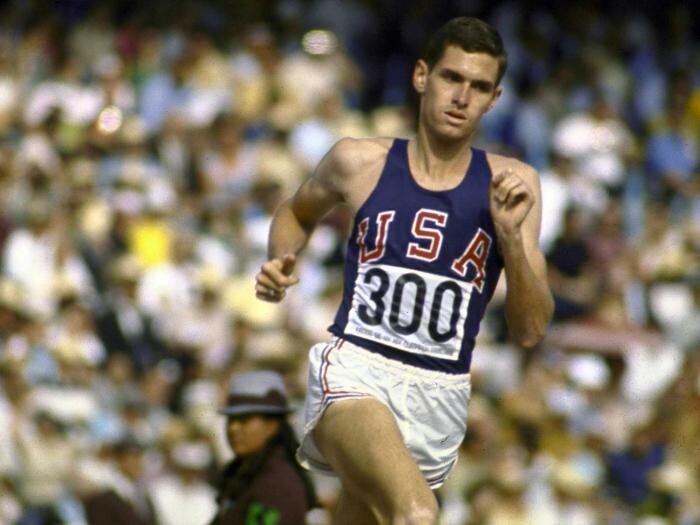
Ryun said Timmons was convinced he could be the first high school runner to break 4 minutes in the mile. That came true on June 5, 1964, when Ryun ran 3 minutes, 59.0 seconds to finish eighth at the Compton Invitational in Los Angeles.
“The goal originally was my coach’s because I was the kid that got cut from the church baseball team, didn’t have great talent and when I started running, I was looking for direction,” Ryun said. "And he began basically teaching me about goals, how to reach goals, and gave me workouts to get there. The night that I ran 4 minutes, 3:59.0, I didn’t sleep that night (before) because I realized that it was his goal.
“But my thought was, what happens if I take ownership, ownership being there’s certain things you as an athlete know you could do like maybe a little extra weightlifting, better eating. It was a transformational moment, because I mean when you finish eighth in a race and become the first kid to run under 4 minutes, that has to change your life – and it did.”
Ryun’s running career took off from there. He made the 1964 U.S. Olympic team in the 1,500m that went to Tokyo and was the last U.S. high school men’s track and field athlete to make the U.S. Olympic team until teenager Erriyon Knighton qualified for the 2020 Tokyo Olympics in the 200m and finished fourth there.
As a high school senior, Ryun broke 4 minutes four more times. His time of 3:58.3 at the 1965 Kansas state meet was the first time 4 minutes was broken in a high school-only meet. On June 4, 1965, Ryun returned to the Compton Relays, the site of his first sub-4-minute mile and ran 3:56.8. A little over three weeks later, he ran 3:55.3 at the U.S. AAU Championships in San Diego and beat New Zealand’s Peter Snell, the 1964 Olympic champion in the 800m and 1,500m.
Ryun, who would stay close to home and attend Kansas University after graduating from high school in 1965, roomed with a former Jayhawks great, Billy Mills, during U.S. training camps leading up to the 1964 Olympics. In Tokyo, Mills stunned the world by becoming the only U.S. athlete to ever win the Olympic 10,000m.
In 1966, Tim Danielson became the second American high schooler to break 4 minutes when he ran 3:59.4. A year later, Marty Liquori ran 3:59.8 to become the third high schooler under 4 minutes.
Ryun and Liquori had illustrious careers after high school, particularly Ryun. At age 19 in 1966, Ryun set two world records, first in the 800m (1:44.9), and then the mile (3:51.3). He was the NCAA indoor mile champion for Kansas in 1967, 1968 and 1969, and the 1967 outdoor NCAA mile champion. In 1967, he set a 1,500m world record of 3:33.1 that stood for seven years.
That same year, he lowered his mile world record to 3:51.1., a mark that stood for almost eight years. Ryun was the last American man to hold the mile world record. He still holds American junior records for the mile (3:51.3) and 2-mile (8:25.1), and his 800m American junior record of 1:44.9 stood for exactly 50 years.
In 2003, ESPN.com ranked Ryun as the greatest U.S. high school athlete of the 20th century, ahead of Tiger Woods, LeBron James, Lew Alcindor (now Kareem Abdul-Jabbar), Wilt Chamberlain, Marion Jones, and others.
After Ryun, Danielson, and Liquori, the 4-minute mile wasn’t broken by a prep athlete again for more than 32 years until Alan Webb ran 3:59.86 at the New Balance Games in New York on Jan. 20, 2001. Sensing something special in Webb, the promoters of the Prefontaine Classic in Eugene, Ore., invited him to run in the Bowerman Mile, the signature event of the meet that has since become a Diamond League event, on May 27, 2001.
Morocco’s Hicham El Guerrouj, still the world record-holder in the 1,500m and mile, won the event in 3:49.92, followed by Kevin Sullivan of Canada and Bernard Lagat, then of Kenya, who later ran for the U.S. They helped pull Webb to a fifth-place finish in 3:53.43, breaking Ryun’s 36-year-old high school record.
“I thought he would. I just didn’t know how much he would break it by," Ryun said. “It was one of those moments in time where he had run well, but he needed somebody to help him get over that finish line, just as I did running under 4 minutes for the first time. You need someone to help set the pace. You can relax a little bit, and he was able to take advantage of that.
“So, there was no real surprise to me. The biggest surprise was that there weren’t more high school boys running under 4 minutes.”
It would be another 10 years before a high schooler would break 4 minutes in the mile. In 2015, Matthew Maton and Grant Fisher, now the U.S. record-holder in the men’s 10,000m, both ran 3:59.38 about one month apart. In 2016, two runners broke 4 minutes, including Drew Hunter, who did it twice in a 15-day span in February indoors, both times in New York.
The 4-minute barrier was broken by high schoolers once in 2017 and again in 2020 during the height of the COVID-19 pandemic. In 2021, Hobbs Kessler ran the fastest high school mile since Webb when he ran 3:57.66 indoors. Kessler later that year broke Ryun’s 1,500m American junior record of 3:36.1 that stood for almost 55 years.
The lack of American high school runners breaking 4 minutes in the mile for decades might be a big reason why U.S. men haven’t enjoyed much Olympic or international success until recently. When Matthew Centrowitz won the men’s 1,500m at the 2016 Rio de Janeiro Olympics, he was the first American man to do so since 1908. At the same Olympics, Clayton Murphy won the bronze medal in the 800m, the first American man to medal in the event since 1992.
And when the World Athletics Championships are hosted on U.S. soil for the first time next month in Eugene, Ore., the defending 800m men’s champion is American Donavan Brazier.
“If you look back in history, you’d see there was a dominance maybe by a country for a time like Great Britain had all those great runners. America at one time was dominant in that area as well,” Ryun said. “So, I think it’s a matter of floating from place to place, and I think it comes down to motivation. How motivated are you?
“Over time you start realizing that motivation has to come down to you be willing to get up, run in all kinds of weather, race all over the world and let those talents be developed that God’s given you. So, it takes time. I think America can come back with dominance, but it also comes down to how motivated you are. I see the Kenyans as very motivated, and America can be just as motivated as you see with these new young runners that are developing quickly.”
That has proven to be the case this season. Seventeen high school runners have broken the 4-minute barrier, and 2022 has been the banner season for it so far with five runners breaking the mark seven times.
“I think a lot of coaches are seeing, too, that kids are just developing a lot faster doesn’t mean you’re going to burn out,” Ryun said. “It means you’ve got great opportunities. Will you decide to keep it going and, in my case, will you take ownership? The coach can only take you so far, but then you have to establish ownership.”
The owner of the fastest prep mile this year is Colin Sahlman, who ran 3:58.81 indoors in February, and, like Webb, was invited to the Bowerman Mile at the Prefontaine Classic. In a field that included 2020 Tokyo Olympic 1,500m gold medalist Jackob Ingebrigtsen, defending World Athletics Championships 1,500m gold medalist Timothy Cheruiyot, and defending 1,500m NCAA outdoor champion Cole Hocker, Sahlman finished 13th in 3:56.24. Of the 14 men who finished the race, seven set personal bests and seven set season bests, including Ingebrigtsen, whose time of 3:49.76 is the fastest in the world this year.
Sahlman’s time moved him to third on the all-time prep list behind Webb and Ryun. Sahlman, who is headed to Northern Arizona University for college, was part of a high school powerhouse at Newbury Park High in Southern California. In 2021, Newbury Park became the first high school team to have four runners break 4:10 for the mile in the same season.
“That mindset has really evolved and developed over these last three to four years,” Sahlman said in a March article in the Los Angeles Times. “It’s just like it’s transformed into something that we never thought was possible. Now we think anything’s possible.”
Gary Martin has also broken 4 minutes twice this year, running 3:57.98 on May 14 and 3:57.89 on June 2 in the Festival of Miles in St. Louis. At the Festival of Miles, Connor Burns ran 3:58.83 to become the first high school junior since Ryun to break 4 minutes. It was also the first time two prep runners broke 4 minutes in the same race.
Those two performances gave the Festival of Miles four prep runners who have broken 4 minutes. That’s where Fisher did in 2015, a feat repeated by Reed Brown a year later.
And one day after Martin and Burns broke 4 minutes, Rheinhardt Harrison ran 3:59.33 in Florida on June 3. On June 15, Simeon Birnbaum added to the list of sub-4 minute runners when he became the second high school junior this season to break the mark with a time of 3:59.51.
Will this high school running resurgence lead to greater U.S. success against international competition and major global championships? Only time will tell.
(06/20/2022) ⚡AMPby Ashley Conklin (World Athletics)
Branna MacDougall joins Silvia Ruegger as the only Canadian woman to run under 2:29:00 before the age of 25
On the shores of Lake Superior in Duluth, Minn., Canada’s rising marathon star, Branna MacDougall, ran a five-minute personal best of 2:28:36 to place fifth at the 2022 Grandma’s Marathon. Her time is one minute under the world marathon standard of 2:29:30 and the seventh-fastest ever among Canadian women.
(First photo) Branna MacDougall of Kingston, Ont., approaches the finish line at the Muskoka Half-Marathon in 2020.
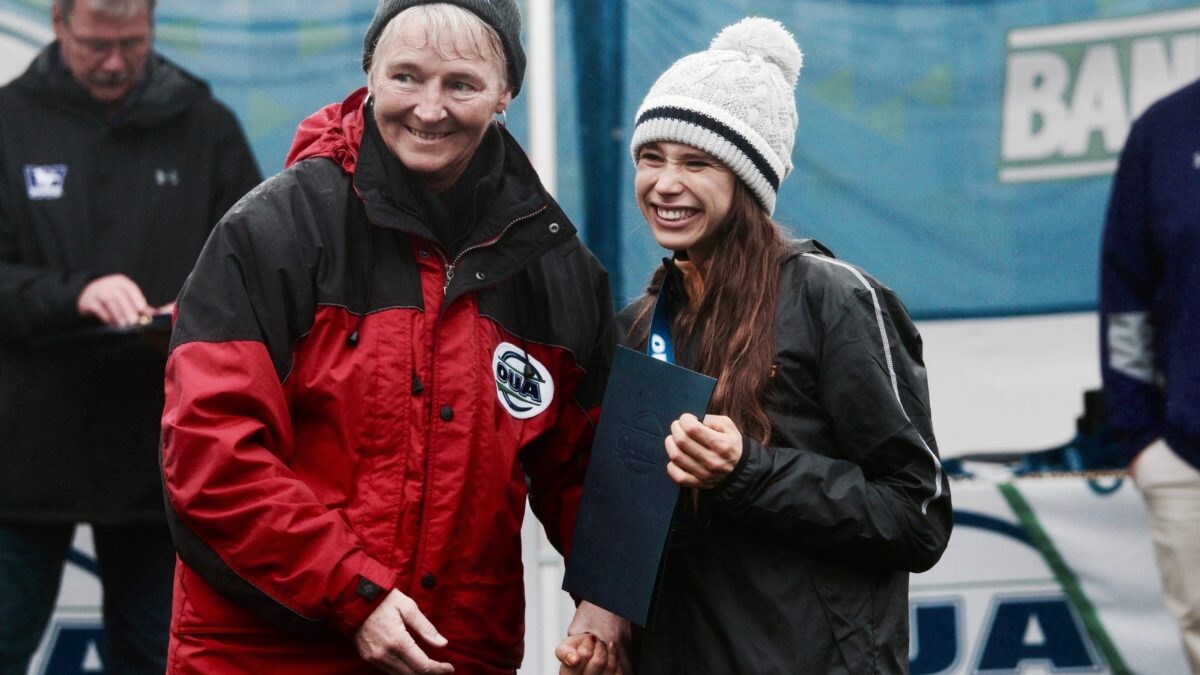
Although MacDougall had only tackled the marathon distance once before, she ran the race like a seasoned veteran. She negative split the second half of the race in 1:14:13, moving up to fifth from seventh place. Her first marathon, last fall, was in Muskoka, Ont., where she ran a solo 2:33:40.
MacDougall, 23, had a prolific cross-country career at Iowa State University and Queen’s University, winning the U Sports team title in 2019. Since then, she has continued her training in Kingston under former Queen’s coach Steve Boyd and Physi-Kult.
U.S. marathoner Dakota Lindwurm become the first Minnesotan to successfully defend her title, winning in a personal best time of 2:25:01, which is four minutes faster than her previous winning time of 2:29:04.
Sarah Sellers, who finished second at the Boston Marathon in 2018, and school teacher Susanna Sullivan of the U.S., rounded out the top three in 2:25:43 and 2:26:56, respectively.
MacDougall’s time is the second-fastest time by a Canadian woman this year, only behind Malindi Elmore’s 2:27:56 at the 2022 Boston Marathon. Although MacDougall’s time is under the 2022 world championship standard, the qualification period closed on May 29 and Canada’s team has already been named.
The 2022 Commonwealth Games qualification window closed on June 19, therefore, there’s a chance MacDougall could be selected to represent Canada in Birmingham, U.K., or considered for the 2023 World Championships in Budapest.
(06/20/2022) ⚡AMPby Running Magazine
Grandmas Marathon
Grandma's Marathon began in 1977 when a group of local runners planned a scenic road race from Two Harbors to Duluth, Minnesota. There were just 150 participants that year, but organizers knew they had discovered something special. The marathon received its name from the Duluth-based group of famous Grandma's restaurants, its first major sponsor. The level of sponsorship with the...
more...Tokyo Olympian Tachlowini Gabriyesos will lead a six-member Athlete Refugee Team (ART) to next month's World Athletics Championships Oregon22.
Tachlowini Gabriyesos, 24, made waves one year ago when he finished 16th in the Olympic marathon in Sapporo, beating some of the world's best marathoners.
“It makes me so proud to once again wear the Athlete Refugee Team vest at the World Championships,” said Gabriyesos, a native of Eritrea who made his Athlete Refugee Team debut at the 2019 World Championships in Doha where he competed in the 5000m.
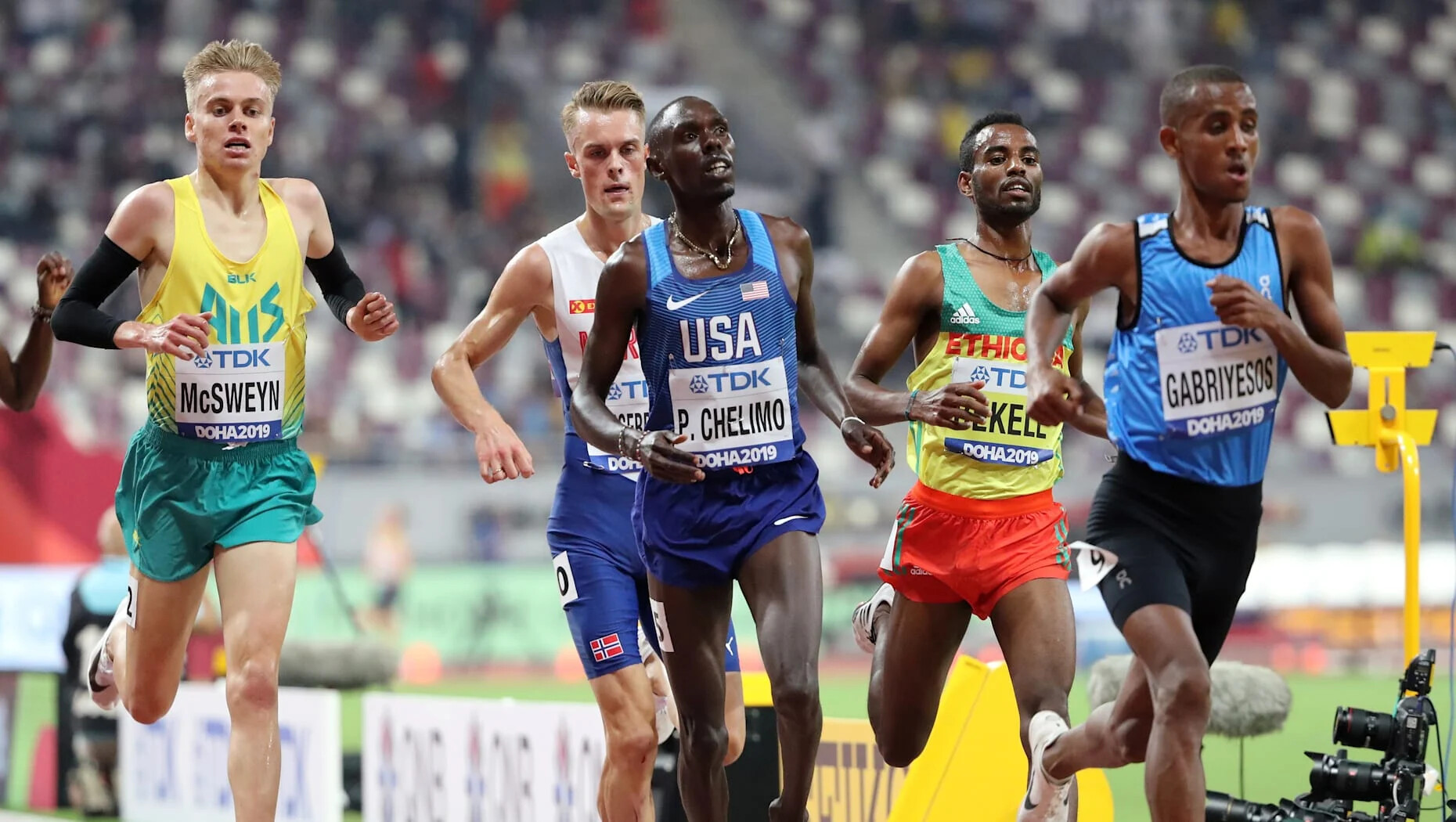
“I don’t represent a country, but millions of people without one. I want to be a role model for refugee youth around the world and wish to show the world once again that refugees can be strong, that we are hungry for success and that we deserve equal opportunities.”
Gabriyesos fled conflict and bloodshed in Eritrea at age 12 and journeyed through Ethiopia, Sudan and Egypt before crossing the Sinai desert on foot to Israel where he's been living since 2010. He began running soon after and eventually found that he was best suited for athletics' longest running event.
At the Hahula Galilee Marathon in Israel in March 2021, Gabriyesos clocked 2:10:55 to become the first refugee athlete to meet an Olympic qualifying standard. He later served as the co-flag bearer for the Olympic Refugee Team at Tokyo’s Opening Ceremonies. After his solid performance in Sapporo's hot and muggy conditions, Gabriyesos improved to 2:10:09 at the Seville Marathon in February.

After its involvement with the inaugural Refugee Olympic Team that competed at the 2016 Olympic Games in Rio, World Athletics established the Athlete Refugee Team in 2017 to provide refugees with high level training and competitive opportunities.
It is the world’s only year-round team composed solely of refugee athletes. The team has been represented at almost every World Championship event since, in addition to a growing number of continental and regional events, most recently the European 10,000m Cup in May and the African Championships earlier this month.
"On this World Refugee Day, our Athlete Refugee Team brings a powerful and inspirational message of hope and solidarity to the world, at a time when it's truly needed," said World Athletics President Sebastian Coe. "They're also showing, through their rapid development and world class performances, that they do belong among the world's best athletes."
Representing a community of 89 million
When the refugee team was introduced at the 2016 Olympic Games in Rio, that squad of 10 – six competing in athletics – represented 65 million people around the world who had been forcibly displaced from their homes.
That figure soared to more than 82 million by 2020 and, propelled by conflict, the climate crisis and skyrocketing inequality, has grown to 89.3 million at the end of 2021. The six athletes who are set to compete in Eugene next month will represent a community that collectively would be the 17th most populous country on the planet.
Similarly, the number of athletes involved in the World Athletics Athlete Refugee Team project continues to grow. More than 40 athletes are now involved in the programme, training at their respective bases in Kenya, Israel, France, the United Kingdom, Sweden, Germany, Canada and Portugal.
Gabriyesos will be joined by Jamal Abdalmajid Eisa-Mohammed, a native of Sudan, who will make his second consecutive World Championships appearance in the 5000m. The 28-year-old improved his lifetime best over the distance to 13:42.98 at the Olympic Games last year.
Dorian Keletela, 23, will be making his third ART appearance after outings at the 2021 European Indoor Championships and last summer's Olympic Games in Tokyo. In the Japanese capital, he clocked 10.33 to win his 100m heat in the preliminary round, smashing his previous career best by 0.13. He improved to 10.27 last year and at the moment has a 10.47 season's best.
Fouad Idbafdil, a refugee from Morocco who is based in France, rounds out the men's squad. The 34-year-old steeplechase specialist improved his lifetime best to 8:37.94 nine days ago. He too competed on the ART squad in Doha in 2019.
The women’s team is led by Anjelina Nadai Lohalith, who will bring plenty of experience to the start line of the 1500m. The 27-year-old native of South Sudan, who is based at the Tegla Loroupe Peace Foundation training camp in Ngong, Kenya, will be making her second World Championships appearance after her debut in 2017.
Nadai is a two-time Olympian and most recently competed at the World Indoor Championships in Belgrade in March and the African Championships in Mauritius 11 days ago. She set her 4:31.65 lifetime best in Tokyo last year.
She'll be joined by Atalena Napule Gaspore, another South Sudanese athlete from the Loroupe camp, who will be making her Athlete Refugee Team debut competing in the 800m.
Athlete refugee team for WCH Oregon22
Women 800m: Atalena Napule Gaspore 1500m: Anjelina Nadai Lohalith
Men 100m: Dorian Keletela 5000m: Jamal Abdalmajid Eisa-Mohammed marathon: Tachlowini Gabriyesos 3000m steeplechase: Fouad Idbafdil
(06/20/2022) ⚡AMPby World Athletics
World Athletics Championships Budapest23
Budapest is a true capital of sports, which is one of the reasons why the World Athletics Championships Budapest 2023 is in the right place here. Here are some of the most important world athletics events and venues where we have witnessed moments of sporting history. Throughout the 125-year history of Hungarian athletics, the country and Budapest have hosted numerous...
more...Remembering Kusocinski's athletics feats and heroic struggle
It was 90 years ago today that Janusz Kusocinski ran his way into the world record book.
Already a prolific national champion in his homeland, at distances ranging from 800m to 10,000m, the 25-year-old Pole made a name for himself at a global level when he crossed the line in an international 3000m race in Antwerp, Belgium, ahead of John Fellowes of the USA in 8:18.8.
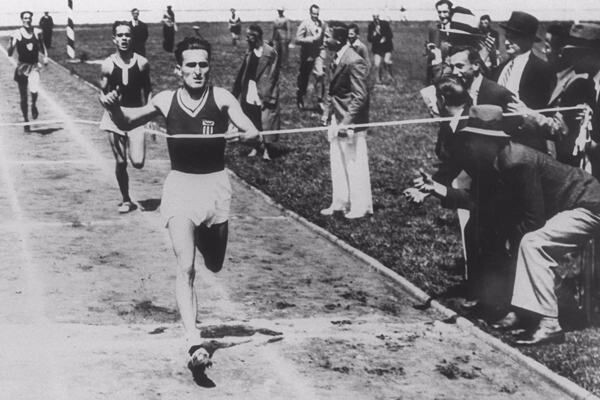
“Kusy,” as the popular Warsaw gardener was known to friends and the wider public in Poland, eclipsed one of the enduring global marks set by the finest of all the formidable Flying Finns.
The world record for 3000m had belonged to the peerless Paavo Nurmi for six years. The nine-time Olympic gold medallist had clocked 8:20.4 in Stockholm in 1926.
To prove it had been no fluke, 10 days later – on 29 June 1932 – Kusocinski claimed another of Nurmi’s world records. On that occasion, he smashed it by 13 seconds, his 19:02.6 for 4 miles obliterating Nurmi’s 1924 figures of 19:15.6.
First non-Finnish winner
A month later, Kusocinski enjoyed his finest half an hour in track and field.
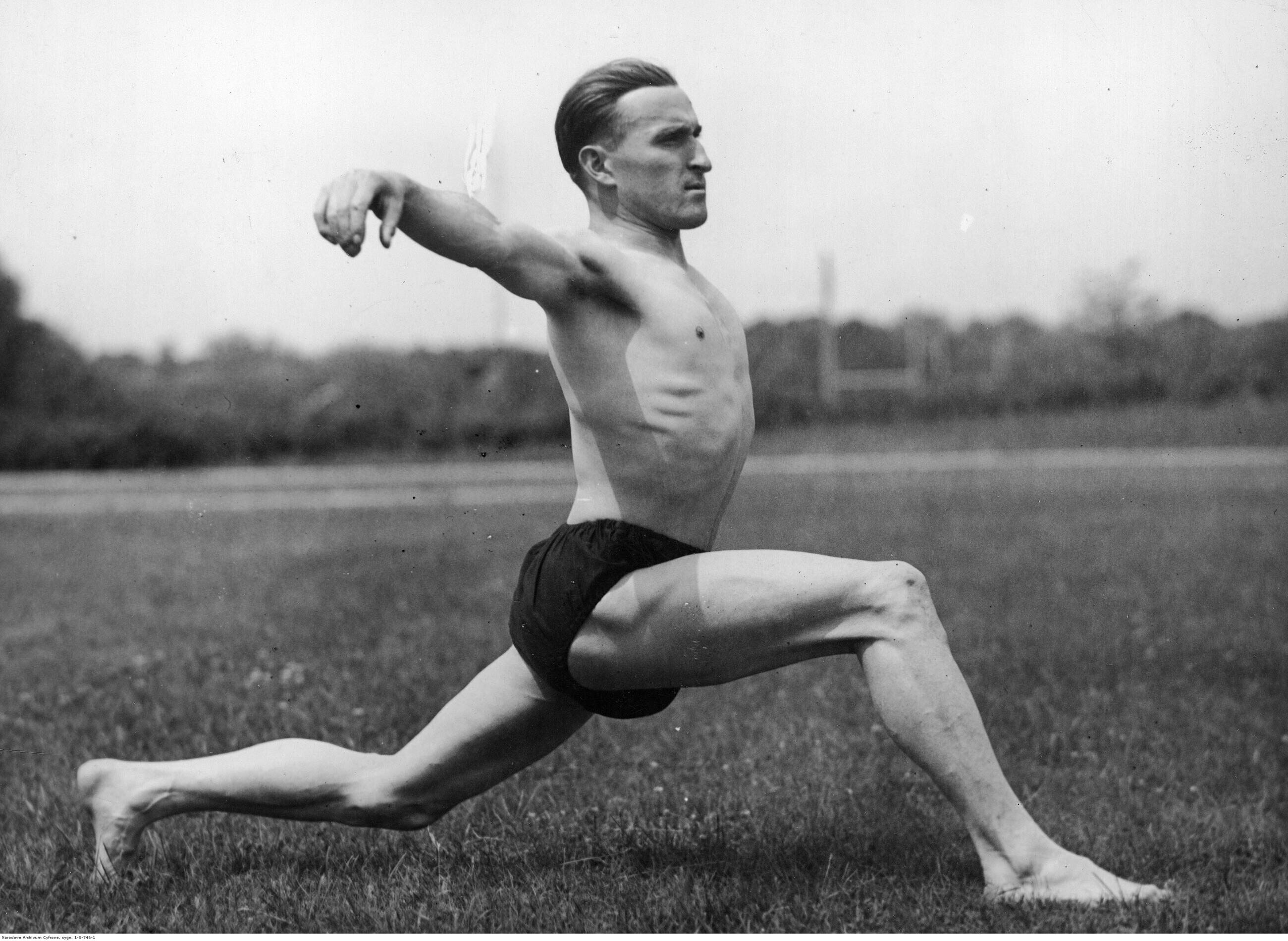
Running for his country in the Los Angeles Coliseum on 31 July, he fought a nip and tuck battle with Finn Volmari Iso-Hollo for 24 laps of the 1932 Olympic 10,000m final.
Iso-Hollo led by a metre going into the final lap but then Kusocinski sprinted clear before slowing to a jog and still winning by 1.1 seconds. His time, 30:11.4, shattered the Olympic record Nurmi had established in Amsterdam four years previously: 30:18.8.
In succeeding Nurmi, Kusocinski became the first non-Finnish winner of the Olympic 10,000m crown. He was the only non-Finn to win the coveted Blue Riband of distance running until Emil Zatopek in London in 1948.
For Iso-Hollo, compensation came seven days later in the form of the 3000m steeplechase gold medal. The Finnish typesetter would have claimed the world best too had the stand-in trackside lap-counter not been distracted by the decathlon pole vault, allowing the field to complete an extra circuit of the track.
Iso-Hollo went on to win another steeplechase gold, plus a 10,000m bronze medal, in front of Adolf Hitler and the Nazi regime at the 1936 Olympics in Berlin.
Resistance hero
Kusocinski proceeded to etch his name into national folklore as a fearless fighter against the Nazi occupation of his homeland.
When Hitler’s troops invaded Poland in September 1939, Kusocinski volunteered for the Polish Army and was drafted into the machine gun company as a corporal in the Second Battalion of the 360 Infantry Regiment. In the fight to defend Warsaw, he was wounded twice and was awarded the Cross of Valour.
After the country fell to Nazi Germany, he worked ostensibly as a waiter at the Red Rooster Bar in Warsaw while secretly operating as a member of the underground resistance movement known as the Wolves, using the pseudonym Prawdzic.
Kusocinski was arrested by Gestapo officers at the gate of his house in Warsaw on 28 March, 1940. He was interrogated and tortured at Gestapo headquarters but refused to reveal the names of fellow resistance members.
On the night of 20-21 June, he was transported to Palmiry on the outskirts of Warsaw and executed in Kampinos Forest as part of what the Nazis called Operation AB, an attempt to exterminate all Polish intelligence operatives.
Nine decades on, the name of Janusz Kusocinski, world record-breaker, Olympic champion and national hero lives proudly on in Poland.
Scores of streets and primary schools throughout the country carry his name. So does the Janusz Kusocinski Memorial meeting, which celebrated its 68th edition in Chrozow on 5 June this year and is part of the World Athletics Continental Tour Gold series.
Vladimir Kuts took part in the inaugural event in 1954 and meeting records dating back to the 1970s are held by greats such as Alberto Juantorena (1:43.66 for 800m), Irena Szewinska (49.75 for 400m) and Bronislaw Malinowski (8:21.2 for the 3000m steeplechase).
An athlete by chance
Kusocinski was born in Warsaw in 1907, the son of a railway clerk. Armed conflict took its toll on his family when he was a child. His eldest brother, Zygmunt, was killed in France in World War I. Another brother, Tedeusz, was a casualty of the Polish-Bolshevik War in 1920.
In his youth, Janusz’s first sporting love was football. He played as a dashing forward for various clubs in Warsaw.
He became an athlete by accident. In 1925, his sports club RKS Sarmata was a relay runner short for a workers’ holiday meeting. Kusocinski agreed to stand in and helped the Sarmata team to victory.
The following year he started competing as an 800m and 1500m runner and came under the wing of the club’s celebrated track and field coach: one Aleksander Klumberg.
Klumberg became Poland’s national athletics coach between 1927 and 1932. Back in 1922, the native Estonian had become the first official holder of the decathlon world record after posting 7485.61 points in Helsinki. In 1924 he had taken the decathlon bronze medal at the Paris Olympics, behind Harold Osborn and Emerson Norton of the USA.
The young Kusocinski thrived under Klumberg’s regime of intense interval training, winning the Polish 5000m and cross country titles in 1928. His running career was interrupted by a year of national service in the Polish Army but he was stronger upon his return, capturing national titles at 800m, 1500m, 5000m and cross country leading up to his annus mirabilis in 1932.
He represented Poland at the inaugural European Championships in Turin in 1934, placing fifth in the 1500m and taking silver in the 5000m behind Roger Richard of France.
Kusocinski hung up his racing spikes after returning from Italy but dusted them off to win the Polish 10,000m title in 1939.
By that time, he had moved on from gardening to become a PE teacher, coach and then a successful journalist, rising to editor-in-chief of Kurier Sportowy.
Then came the Nazi invasion, and the heroic struggle and tragedy that followed.
In 2009, Kusocinski was posthumously awarded the Commander’s Cross with Star of the Order of Polonia Restituta - “for outstanding contribution to the independence of the Polish Republic, and for sporting achievements in the field of athletics.”
(06/19/2022) ⚡AMPby Simon Turnbull (World Athletics)
Whittaker repeats as mile champion in Seattle by edging Engelhardt and elevates to No. 7 all-time outdoor performer with 4:36.23 effort in first girls high school race with seven athletes running under 4:40
Julia Flynn called it.
“I knew it. I knew today was going to be a crazy race,” said Flynn, a recent graduate of Traverse City Central High in Michigan.

That it was. On a cloudy Wednesday afternoon at the University of Washington’s Husky Stadium in Seattle, Flynn was part of the fastest Brooks PR Invitational mile in meet history.
Defending champion Juliette Whittaker of Mount de Sales in Maryland led the charge with a final surge down the straightaway to win in 4 minutes, 36.23 seconds, lowering her own meet record of 4:38.65 from last year.
Six girls quickly followed, all crossing the finish line under 4:40 to make it the deepest girls mile race in U.S. prep history. The boys mile also didn’t disappoint to cap the meet by having junior Simeon Birnbaum of Rapid City Stevens High in South Dakota eclipse the 4-minute barrier and five athletes run sub-4:02 for the first time in a single high school race.
“I predicted Juliette was going to win, but I was like, ‘You know what? Regardless of the winner, we’re all going to get really big PRs,’” Flynn said. “That’s why it’s Brooks PR, it lives up to the name.”
With the girls and boys miles scheduled annually as the last races of the meet, fans at Husky Stadium lined the outskirts of the track down the straightaway, creating an intimate and electric environment for the 12 female runners all capable of winning the event.
“I knew it was going to be a fast race and I knew it was going to be competitive,” Whittaker said. “Just the fact that we came around with a lap to go and all of us were still in the race, was insane, it was really just a kick to the finish.”
With a slight separation from the pack, Whittaker and freshman Sadie Engelhardt of Ventura High in California – who set an age 15 world mile record April 9 by running 4:35.16 at the Arcadia Invitational – came sprinting down the last 100 meters.
Similar to how the New Balance Indoor National mile championship race played out March 13 between the two athletes, Whittaker had a little more left in her to pull ahead of Engelhardt for the victory. Whittaker prevailed by a 4:37.23 to 4:37.40 margin at The Armory in New York.
Engelhardt finished runner-up Wednesday in 4:36.50, while Flynn ran 4:37.73 to set a Michigan state record by eclipsing the 2013 standard of 4:40.48 produced by Hannah Meier of Grosse Pointe South.
Riley Stewart of Cherry Creek High was fourth in 4:38.21, lowering her own Colorado state record of 4:40.66 from last year, when she placed second behind Whittaker.
“I’m feeling amazing,” Stewart said. “I’ve been 4:40 three times now, so to finally get it (under 4:40) and to run with all these amazing girls, I have to say that was probably one of the best miles we’ve ever seen come through here, so just to be part of it is just amazing.”
Samantha McDonnell of Newbury Park High in California placed fifth in 4:38.44, Isabel Conde de Frankenberg of Cedar Park High was sixth in a Texas state record 4:38.55, and Mia Cochran from Moon Area in Pennsylvania secured seventh in 4:39.23. Conde de Frankenberg eclipsed the 2009 standard of 4:40.24 established by Chelsey Sveinsson of Greenhill High.
Every performance achieved from Engelhardt to Cochran was the fastest all-time mark by place in any high school girls mile competition.
Just missing going under 4:40 was Taylor Rohatinsky of Lone Peak High in Utah, clocking 4:41.83 to also produce the fastest eighth-place performance in any outdoor prep mile race.
Whittaker’s winning effort made her the No. 7 outdoor competitor in U.S. prep history, with three of the marks achieved this year, the other two coming from Dalia Frias of Mira Costa High in California (4:35.06) – who also ran the national high school outdoor 2-mile record 9:50.70 to open Wednesday’s meet – and Engelhardt’s victory at Arcadia.
Whittaker, along with Flynn, Stewart, 10th-place finisher Ava Parekh (4:52.09) of Latin School in Chicago and Roisin Willis from Stevens Point in Wisconsin – second place Wednesday in the 400 in 53.23 – are all part of Stanford’s 2022 recruiting class.
Despite having an unusual high school career due to the pandemic, Whittaker said the surge of quicker times and a more competitive environment may be due to the circumstances the pandemic created with more time for training.
“I feel like ever since COVID, honestly we have just surpassed any goals that we used to always set,” Whittaker said. “(Running) 4:40 used to be a barrier that like many people wanted to break, if so, maybe one, but the fact that seven girls (did) in the same race. I’m excited for years to come to keep watching. Sadie, obviously only being a freshman, and like other girls, I’m excited to see what times they are going to run.”
Here is the list of high school girls who have broken 4:40 before this race:
High School Girls Who Have Run Sub-4:40 Miles
Mary Cain — 4:28.25i (2013)
Alexa Efraimson — 4:32.15i (2014)
Katelyn Tuohy — 4:33.87 (2018)
Dalia Frias — 4:35.06 (2022)
Sadie Engelhardt — 4:35.16 (2022)
Polly Plumer — 4:35.24 (1982)
Katie Rainsberger — 4:36.61i (2016)
Kim Gallagher — 4:36.94 (1982)
Sarah Bowman — 4:36.95 (2005)
Arianna Lambie — 4:37.23 (2003)
Juliette Whittaker — 4:37.23i (2022)
Marlee Starliper — 4:37.76i (2020)
Christina Aragon —4:37.91 (2015)
Addy Wiley — 4:38.14 (2021)
Victoria Starcher — 4:38.19 (2020)
Caitlin Collier — 4:38.48 (2018)
Debbie Heald — 4:38.5i (1972)
Ryen Frazier — 4:38.59 (2015)
Taryn Parks — 4:39.05i (2019)
Wesley Frazier — 4:39.17 (2013)
Sarah Feeny — 4:39.23 (2014)
Danielle Toro — 4:39.25 (2007)
Mia Barnett — 4:39.41 (2021)
Katelynne Hart — 4:39.57 (2020)
Cami Chapus — 4:39.64 (2012)
Brie Felnagle — 4:39.71 (2005)
Dani Jones — 4:39.88 (2015)
Angel Piccirillo — 4:39.94 (2012)
Allison Cash — 4:39.98 (2013)
(06/19/2022) ⚡AMPby Mary Albl of DyeStat
Run Commutes Aren’t Just for Getting to Work
If you’re looking for ways to stay motivated during your Streak, try using the daily jog as transport.
The second half of the Run Streak is when most of us start to crave a rest day or feel a slump in motivation. It’s also the time that I dip into what has been a streak-saving secret: run commuting.

After all, running was transport way before it was sport, and the idea of bookending your work day with runs to and from the office isn’t a new one—especially during the summer Streak when we’ve got more daylight and try to avoid the hottest hours of the day. (Even if you work from home, you can still jog a “fake” commute like ultrarunner Mike Wardian does each morning when he’s trying to get in extra mileage.)
Personally, the majority of my run commuting isn’t from home to office and back again. Rather, it’s for heading to other destinations that I would have otherwise hopped in a car. I can’t help but mention that at a time when gas prices have soared over 5 bucks (6 in some areas!) per gallon. It may not save you a significant amount at the tank, but I feel like it counts double when the mileage that would have been going on your car is going in your training log instead.
If you’re dragging a bit and need something new in your Streak, or just need to squeeze in a quick mile with a task you’ve already got on your schedule, I’ve got a few suggestions. I’ve done them all myself, and each has either added a little convenience or excitement to my Streak. My challenge to you is to try one of these during the final days of yours:
Run to a local coffee shop for your morning coffee.
Jog to meet a friend you haven’t seen in a while.
Get an errand out of the way. (I run to get my groceries and count carrying them home as my weight training.)
Experiment with a run commute to work
End a hot run with ice cream for the walk home.
Save the delivery fee on something small you’ve Uber Eats’d (These apps offer more than just food orders now.)
Pick up birthday or holiday cards for friends and family.
A Few Tips
If you have a watch that offers built-in payment methods, get it set up before you head out so you can leave your wallet at home.
Remember that you don’t have to run the whole way. Maybe you’ll ask a friend for a lift home, carpool with a coworker, or use public transport for a portion of your trip.
Plan your route ahead of time. Use turn-by-turn GPS navigation on your phone’s app or watch as back up.
If you’re commuting during busy hours, incorporate parks into your route to avoid busier roads and sidewalks.
Use hear-through mode on your headphones, or just leave them at home.
Seal your cash or cards in a Ziplock baggy to keep them from getting sweaty.
Short, easy jogs during cooler hours won’t leave you stinky or drenched.
Always give yourself about 10 more minutes than you think you’ll need.
(06/19/2022) ⚡AMPHow much will running in poor air quality compromise your health? It depends on which markers of health you consider
Here’s a bold prediction for the upcoming dog days of summer 2022: it’s going to be hot, smoggy and smoky. Whether you’re in a big metropolis sucking in diesel fumes or on a remote mountain trail coughing up smoke particles from a distant forest fire, there’s a good chance you’re going to encounter some less-than-pristine air over the next few months.
Is that a problem? On the surface, the answer is obvious. Inhaling polluted air triggers a cascade of inflammation and oxidative stress that raises your risk of both immediate and long-term health problems. The rise and fall of air quality readings, for example, is mirrored by the rise and fall of hospital admissions for conditions such as heart disease. And the harder you breathe, the more pollution you inhale, which is why public health authorities typically warn you to avoid outdoor exercise on days with poor air quality.

But there’s an alternate perspective. Pollution is definitely bad for your health—but so is skipping your workout. If you’re weighing the lesser of two evils, it may be that running in dirty air is better than not running at all. That’s the perspective that Michael Koehle, an environmental physiologist who is one of the world’s leading experts on exercise and air pollution, offered when I visited his lab at the University of British Columbia a decade ago: “Exercise is such a big hammer that it crushes everything else,” he told me.
At the time, few studies had addressed the balance between exercise’s benefits and pollution’s harms. Since then, Koehle and others have been grappling with this question, with new findings still appearing on a regular basis. Here’s where the research currently stands.
The good news
Last summer, researchers in Taiwan published a study in the Canadian Medical Association Journal that analyzed the medical records of nearly 400,000 adults who had undergone medical screening starting in 1994. Their exercise habits were assessed with a questionnaire, and their pollution exposure was estimated based on their home address. More exercise was associated with greater longevity, while more pollution was associated with worse longevity, as you’d expect. But it was the interaction—or rather, the lack of interaction—between these two factors that was most interesting. Exposure to high levels of pollution didn’t dampen or reverse the health benefits of high levels of exercise.
A few earlier studies have produced similar findings. For example, a Danish analysis of 52,000 people found that higher levels of exercise protected against premature death, heart disease and diabetes, regardless of how much pollution the subjects were exposed to based on a detailed street-by-street air quality database. An explanation for these results might be found in a series of studies by Brazilian scientists, who directly measured inflammation and oxidative damage in the lungs of mice breathing diesel exhaust. Regular running, it turned out, blocked this inflammation and oxidative damage; exercise was a big enough hammer to cancel out the diesel.
The bad news
Longevity is a pretty good marker of health, but it’s not the only one. Earlier this year, researchers at the University of Arizona published a pair of studies that looked at the effects of exercise and air pollution on brain health. It’s well known that people who exercise regularly tend to have brains with more grey matter (where the neurons are) and healthier white matter (which connects and supports the neurons). They are also less likely to develop degenerative brain diseases like Alzheimer’s: data from the long-running National Runners’ Health Study estimates the risk to be 40 per cent lower in those who run about 25 kilometres a week.
The first Arizona study used brain scans to assess the size and health of white and grey matter in 8,600 British adults; the second one used health records to look for dementia diagnoses in about 35,000 people. They used activity trackers to assess exercise habits and home addresses to estimate pollution exposure. For people in low-pollution areas, the results were as expected: more exercise predicted healthier brains and fewer dementia diagnoses. But for people in moderate- and high-pollution areas, the brain benefits of exercise disappeared.
It’s worth emphasizing that exercising in the polluted areas didn’t make people less healthy, nor did it cancel out the many other benefits of exercise, for example, on heart health. But we all want healthier brains, and the news that even moderate pollution blocks some of those benefits is concerning.
What to do about it
The devil is in the details. There are undoubtedly some situations—the apocalyptic aftermath of a big forest fire, say—when it makes sense to skip a run entirely. And people with respiratory or heart conditions should be especially careful to avoid poor air quality.
More often, though, it may be possible to choose a lesser evil. Mornings generally have significantly cleaner air, thanks to traffic patterns and the interaction of sunlight with certain pollutants, so set that alarm clock. Location, too, plays a big role. Trails and paths that are away from busy roads are your best bet, but even small distances and barriers can help. Vancouver’s bike lanes, for example, are often separated from traffic by a lane of parked cars because that gives cyclists measurably better air quality, according to Koehle.
Contrary to what you might expect, Koehle’s research has found that more intense exercise isn’t necessarily worse than easy exercise. Panting hard may change the way particulates of pollution settle (or don’t settle) in the lungs. As a result, he suggests favouring shorter, harder workouts rather than longer, easier ones when the air quality is worse than usual. Moving indoors is also an option—but unless your facility has state-of-the-art air filtration, don’t assume that the air inside is any better than the air outside. It all comes from the same place, after all.
In the long term, rather than tweaking when and where you run, the best solution would be to make sure that we all have consistent access to clean air. That’s a big hill to climb—but by sticking to your running plans rather than, say, driving to the gym, you’re taking a small step in the right direction.
(06/19/2022) ⚡AMPAfter Suffering from Years of Drug Addiction, Running Helped This Dad Get Clean
Now he’s finishing triathlons and conquering ultramarathons.As a teenager, I grew up in St. Louis, Missouri, and found myself in trouble constantly. I started smoking cigarettes and marijuana, and stealing alcohol at a very young age. And by the time I was 15, I had already started using cocaine, LSD, and ecstasy frequently.
Prescription pills took hold of me at a young age and led me into an opiate addiction. At the climax of my addiction, I was homeless and living on the street. I was the guy you would see at a highway exit holding a sign begging people for money. I tried to get off the opiates by going to a methadone clinic and taking methadone (a FDA-approved drug in the opioid family, used to treat opioid use disorder), and wound up more addicted to that drug.

In the clinic, I also met tons of heroin addicts that introduced me to that drug. Being an addict took me to prison and almost took my life several times, and all the relationships in my life were broken as a result. I tried to commit suicide and found myself in psychiatric units, treatment centers, halfway houses, and rehabs frequently.
The worst of my overdoses was the week of February 4th, 2015, where I had a total of three heroin overdoses in one week. I was found unresponsive with a needle in my arm. During one of those overdoses, I had locked myself in a bathroom with my back to the door and feet against the vanity so nobody would be able to open the door. My father, who had been trying to intervene, actually got into my apartment and broke the door to get me out. He gave me CPR and called 911.
The paramedics gave me several doses of Narcan to try and save my life, and I was put on a ventilator in the ICU due to the fluid in my lungs and pneumonia. After a very scary nine days in the ICU, by the grace of God, I woke up.

At this point, I had a decision to make: either run away like a coward or run toward my failures and take responsibility for my life. At this time, my wife was six months pregnant with our first child, so I made the decision to find help at a men’s faith-based recovery center called Lifeline-connect in Urbana, Illinois, that completely changed my life.
Lifeline-connect is a one-year residential program, so I knew I was going to be there for a while. One of my mentors in the program, RJ Eaton, was into fitness and challenged me to get into shape spirituality, mentally, and physically. Up to that point, my lungs were in bad condition. I smoked two packs of cigarettes a day for over a decade.
I had been running off and on since the first time I went to Lifeline-connect in 2009. And after my relapse in 2015, I started running again this time, and at first could barely run a tenth of a mile without stopping because my lungs hurt.
One day while running, someone saw me running in a really old pair of beat up shoes that were falling apart and blessed me with a brand new pair of Saucony shoes, which really encouraged me. A tenth of a mile turned into two and then a half-mile, and with consistency day by day, it wasn’t long until I was running several miles every day.
By the end of my time at Lifeline-connect, I was running five miles a day, five days a week. As I continued on through my recovery, I kept running and fell in love with it.
In 2019, I competed in the Illinois half marathon and remember thinking at the time about how difficult it was to run a half marathon. But following that race, I realized that running was helping me forge mental toughness to stay strong in other areas of my life. Running helped me to have the same mental fortitude to not quit on longer runs, which is the same mental toughness that has helped me not give into temptation in rough times.
Since then, I’ve run three full marathons, one a personal 26.2-mile run, then a 35-mile ultra that wasn’t a sanctioned event. I also set a PR at the Illinois half marathon this past spring, finishing in 1:42, and have also come to love mountain and road cycling.
To keep pushing the bar, I signed up for and completed the Ironman 70.3 Chattanooga this year and finished with a time that I was pleased with accomplishing. I have a goal to summit all 58 14-ers (mountains above 14,000 feet elevation) in Colorado.
Currently, my running schedule is between 25 and 35 miles a week. Every once in a while, I sign up for a 5K, 10K, marathon, or triathlon to keep me motivated because I really enjoy the community of runners/cyclists/triathletes. I’ve actually connected with a number of local athletes who are now friends of mine and I get to meet up with them for runs or rides.
Next on my running goals list is to do a 50-mile ultramarathon, then a 100K run.
Overall, running makes me feel alive and accomplished. It’s one of my personal devotional times where I express my gratitude to my God for keeping me alive. Because of running, today I now have a beautiful life with my three beautiful children: Eden, Amaeya, and Summit. My wife, Maegan, is my biggest cheerleader. She’s my rock who stuck by my side, always encouraging and believing in me. I am so grateful that I get to tuck my three beautiful children in to sleep at night and be their dad. The only thing running didn't prepare me for was raising these three kiddos ages 2, 4, and 6—talk about an endurance event!
A special shout-out to my 2-year-old Siberian husky, Slushy, who has been my running partner over the years. I train with him regularly because he holds me accountable when running. He’s ready to go every day at 5:30 a.m. rain or shine, and he has helped me to be better. We all need a husky in our lives: personally, spirituality, and professionally.
For anyone reading this, I want them to know that no matter what struggle they are going through, there is an opportunity to come out of the fire stronger than before. Sometimes it takes a fire in our lives to clear and burn away all the impurities that were holding us down. Now is the time to get up, lace your shoes, and march forth. If I can do it, anyone can.
These three trips have made my running journey a success:
1. Smile when you run
It helps me to remind myself why I love this.
2. Practice gratitude
When running gets tough, I try to remind myself of how lucky I am to be able to run. I am blessed to have found this path, when others close to me have lost their lives.
3. Run everywhere you travel.
I run everywhere, even on vacation or staying at a friend or family’s house out of state to keep the spirit of adventure alive!
(06/19/2022) ⚡AMPby Runner’s World
Olympic Champion Dame Kelly Holmes has announced she is gay, and says she has hidden it for 34 years.
Speaking during Pride month, the two-time gold medallist said she realised she was gay at the age of 17 after kissing a fellow female soldier, and that her family and friends have known since 1997.
The Olympic champion told the Sunday Mirror: "I needed to do this now, for me. It was my decision. I'm nervous about saying it. I feel like I'm going to explode with excitement.
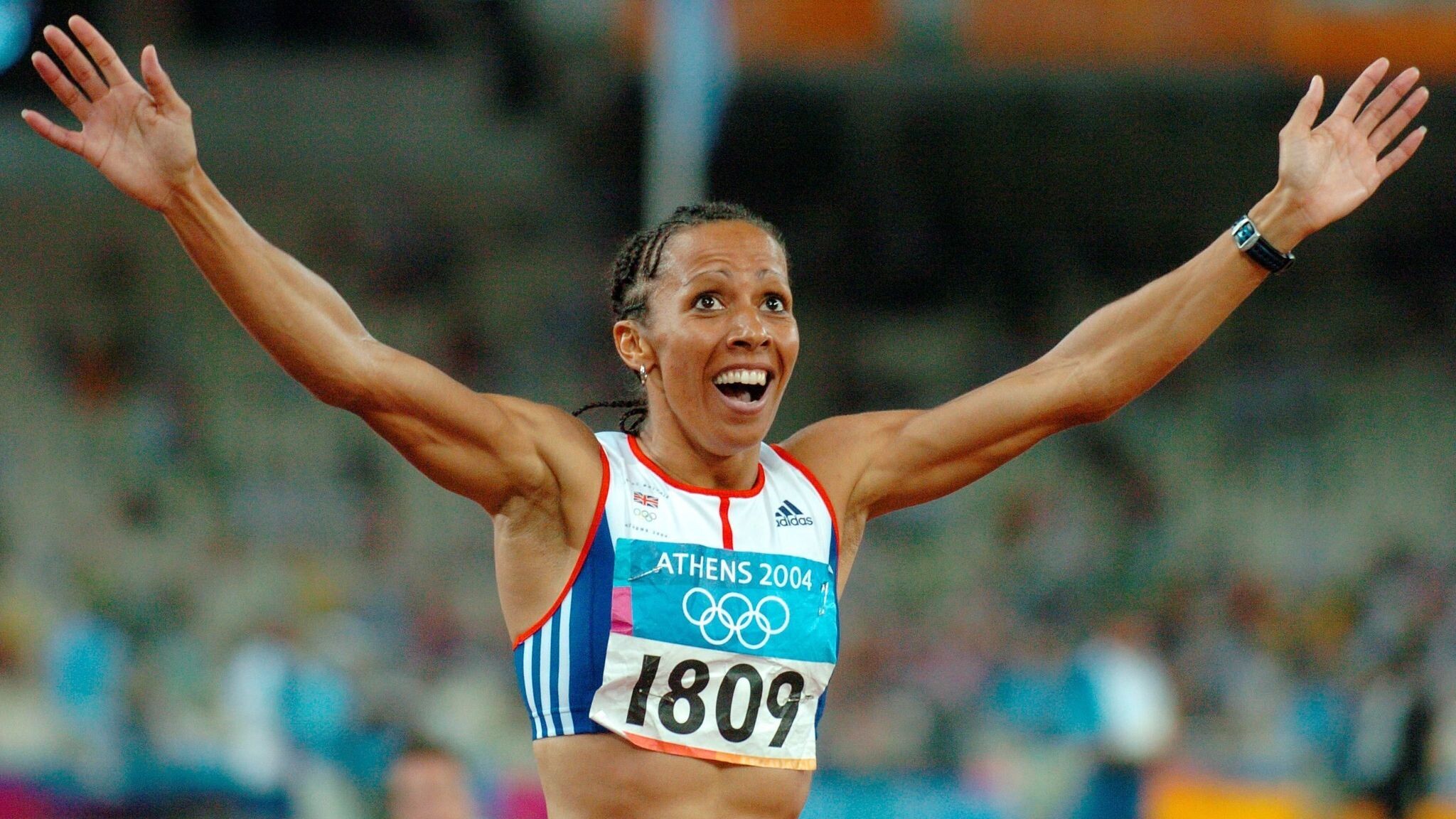
"Sometimes I cry with relief. The moment this comes out, I'm essentially getting rid of that fear."
The 52-year-old also revealed she struggled with her mental health because of having to hide her sexuality, and that she had to keep several same-sex relationships she had during her time in the Women's Royal Army Corps secret, for fear of being courts marshalled.
Until 2000, it was illegal for gay, lesbian and bisexual people to serve in the British Army, Royal Navy and RAF - and Dame Kelly feared she would still face repercussions for breaking that law during her time in the forces.

She contacted a military LGBTQ+ leader in 2020 to find out if she could be sanctioned for breaking army rules and was told she would not be.
She said: "I felt like I could breathe again, one little call could have saved 28 years of heartache."
(Second photo) Crossing the finish line to win the gold medal in the women's 800m at the 2004 Olympic Games in Athens. She also won the 1500m.
Dame Kelly took part in her final major championship in 2004, with a double gold medal-winning performance at the Athens Olympics.
In 2005 - the year she retired from athletics - she was made a Dame by the Queen.
She has since been made an honorary colonel with the Royal Armoured Corps Training Regiment.
Dame Kelly set up a charity in 2008, created to support retired athletes to transition out of their sport, and to create mentoring programmes to inspire young people from disadvantaged backgrounds into sports.
Social media has been flooded with support for the Olympic champion.
She has also started to make a documentary about her experiences called Being Me, where she talks to LGBTQ+ soldiers about their lives in the military now.
(06/18/2022) ⚡AMPSebastian Coe runs first few steps at Budapest’s new National Athletics Centre
World Athletics President Sebastian Coe ran the first metres on the track at the new National Athletics Centre of Hungary, which will be the venue for the World Athletics Championships Budapest 23 in just over a year.
Coe, who is in Budapest for the FINA World Championships, met with key members of the local organising committee for the 2023 World Athletics Championships, including CEO Péter Deutsch and Hungarian Athletics Association President Miklós Gyulai. During his time in the Hungarian capital, Coe was shown around the National Athletics Centre by 2017 world 110m hurdles bronze medallist Balázs Baji.
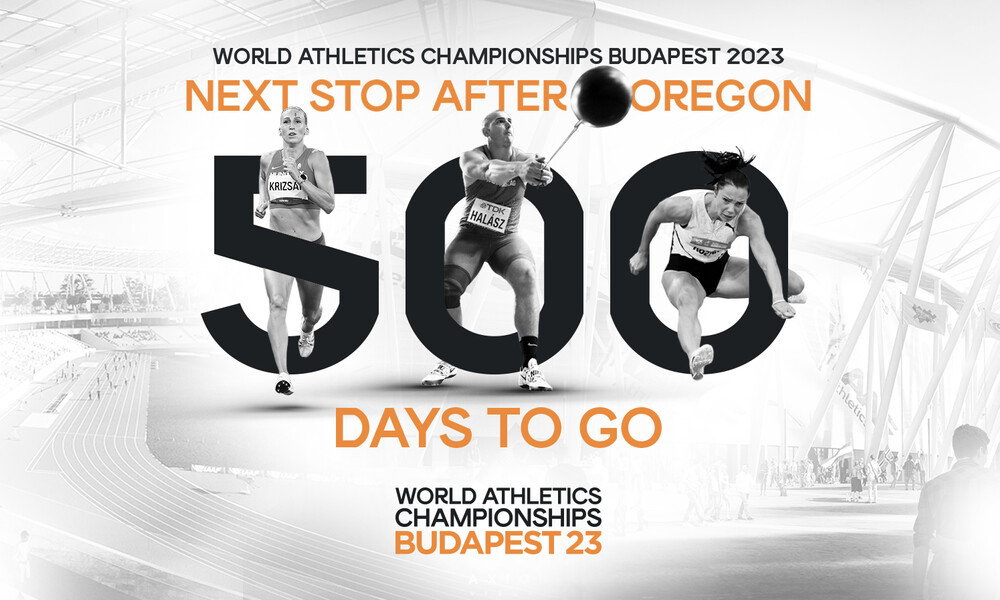
Coe also joined 10 participants from the Hungarian Kids’ Athletics Programme and ran with them on the field of play in the new stadium, which is still under construction. The Hungarian Kids’ Athletics Programme aims to inspire more and more children to choose athletics as their first sport, given it is the foundation of all sports. As a result of the programme, the number of young athletes aged six to 12 has already increased by 30% in Hungary in 2021. The programme is part of World Athletics’ Kids’ Athletics initiative.

“I am impressed with the organisation,” said Coe. “Of course there is still a lot to do, but everything is going to plan. I saw a very focused team and I’m sure we’ll see a fantastic World Championships here in Budapest in 2023. Even with the ongoing construction, the stadium already looks impressive. It was great to meet some of the budding young talent from the Hungarian Kids’ Athletics Programme, and it was a pleasure to join them in their debut at the stadium. I hope they all get an opportunity to compete here in the years to come.”
Deutsch added: “Just over a year from now, in August 2023, the World Athletics Championships – the biggest sporting event in Hungary's history – will begin. Our goal with the World Championships is to strengthen and promote the Hungarian athletics and to get as many children as possible to choose this fantastic sport.”
(06/18/2022) ⚡AMPHow to Run (When You Hate Running)
If you slog through the same boring miles week after week, can’t even imagine slogging through miles every week, or if your high school coach used laps as punishment... of course you’re gonna hate running. Here’s how you won’t.
If you’re not a fan of running, you’re definitely not alone. Forty-six percent of the 1,800 people who answered our MH poll said they hate it too. But here’s the thing: Running’s not about banging it out anymore. It’s still an incredibly efficient cardio workout that you don’t get with weights alone.

Now, however, running itself isn’t really the point. It’s just what happens to be going on in the morning, with friends. Or at night, when the city’s yours and you may or may not be breaking some rules. It’s a game you play with yourself, a way to test yourself, a way to find yourself, a way to forget. You don’t really hate running. You hate the way you’ve been running. And we’ve got six cures for that.
CURE 1:
Add a new level of exploration—or competition—by lacing up after dark.
There’s a version of running in which you don’t wake up early, you don’t pay hundreds in race fees, and the finish line, at least sometimes, is a bar. It doesn’t quite have a name, or at least it hasn’t been branded yet. It’s punk rock. It’s returning running to the people from the hands of corporate sponsors and type A, predawn joyless slogs. Call it night running if you want, since that’s when it happens.
Many groups start weekly workouts around 8:00 P.M.—not too late for us normies but late enough for the pack to be defined by the flecks of light bouncing off hidden reflective patches on clothes, shoes, caps. But there’s another kind of night running that really sets you free.
It’s not as much about a time of day as it is about a mind-set. These are unsanctioned adventures—underground races with mostly word-of-mouth buzz in which a small group of people (maybe ten friends, maybe 100 entrants) chase a win by running between checkpoints by themselves, picking whatever route they want. There are no closed roads, no signs, no aid stations or port-a-johns. Some races are pretty hardcore—strategic, competitive, and ruled by local studs.
Others, like one I did from a bar in Brooklyn to one in Manhattan, are less aggressive, and your finish time includes drinking a can of beer. That type of gritty night running is the closest you can get to the pure spirit of racing—of grinding your body into the pavement until you’re doubled over. The streets have quieted down, and you’re out in them on your own. Along with every other runner who shares this passion. —MATT ALLYN
CURE 2:
Don’t run, glide. Bound. And sometimes walk.
As the editorial director of a group that includes Runner’s World, I spend more days than not surrounded by real runners, so what I am saying to you is not opinion but lived and learned fact: Real runners rarely seem to be running. They glide. They bound. They kiss the earth with their tippy-toes as a courtesy to gravity rather than a necessity of physics.
I, however, run as if I got into a brawl with a much bigger opponent and am paying for it. Yet: I run. It’s more efficient than cycling (my sport of choice), and it’s easier to manage when you’re traveling. I highly recommend getting the shit kicked out of you by a run. But you can’t be afraid to walk. If you only run for as long as you can actually run, you’re not going to be out there long enough to do yourself much good.
At first, the only way I could do a 30-minute “run” was to run for a few minutes, walk a few, then run some more. Walking is not only okay but pretty much mandatory. Real runners know this and won’t shame you for not running while you run. Anyone else can go suck it, because they’re not even in the damn fight. —BILL STRICKLAND
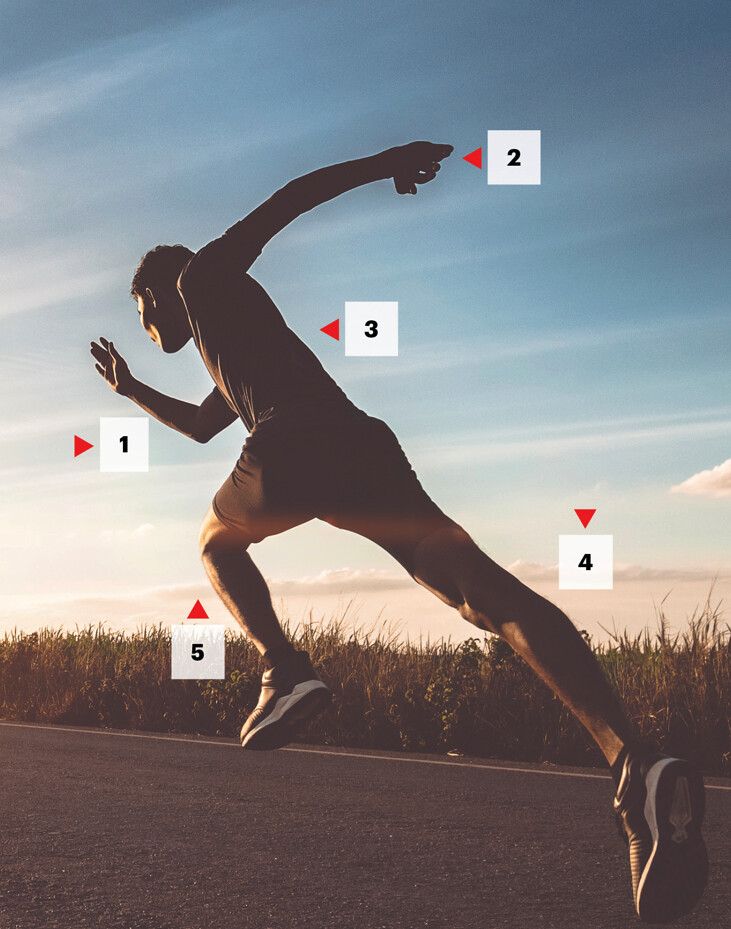
CURE 3
Sprint and Get It Over With
Forget 30 minutes. Crash through just six all-out 100-meter sprints with two minutes’ rest between each (you’ll need it) and you’ll be done with all your running in less than 15 minutes. Here’s how. —EBENEZER SAMUEL, C.S.C.S.
1. A Tight Core
A rock-solid core keeps you exploding straight ahead. Train this with mountain climbers. Do 3 sets, working for 30 seconds, resting for 30. Avoid the common flaw: Don’t let your butt rise!
2. Explosive Arms
Pump your arms to generate speed. Struggling? Sit on the ground, legs extended, then pump your arms as aggressively as possible, as if running. Focus on moving from the shoulders. Do three 30-second sets, resting 30 seconds after each.
3. Back Strength
Don’t just throw your arms forward when you run; build back strength to drive your elbows high. Do 3 sets of 8 to 10 dumbbell rows per side at least twice a week.
4. Strong Feet
Toe and foot strength is key for sprinters. Build it with single-foot jump-rope hops. Jump for 45 seconds, then rest 15 seconds. Do 3 sets.
5. High Knees
Drive your knees powerfully on every stride. Practice this by doing high knees in place for 15 seconds, then resting 15 seconds. Do 3 sets. Focus on driving your knees higher than your hips.
CURE 4
Run with Friends
About two years ago, after I’d put on about ten pounds, I sent a text to two friends at 8:00 on a Sunday morning, saying, “I’m going running at 9:00. Would either or both of you like to join?” Although we’d never discussed running together, I got a “Yup” from one and a “Sure” from the other. Then I got an “I don’t understand what’s going on” from the “Yup,” but—too late!—we had a plan. An hour later, we met up and ran five miles at the slowest pace I’ve ever run, and we’ve run virtually every weekend since then.
Now it’s a ritual. We’re a lot faster, but that isn’t the point. We keep it up because we also don’t want to fail at the opportunity we’ve created. When else do three fathers— three people—get an hour of uninterrupted weekly conversation? That the conversation has the added benefit of regulating our breathing, keeping us at a sensible pace, means we never go too hard—and going too hard is probably one of the reasons I used to stop running.
CURE 5
Try the (New, Gamified) Treadmill
The treadmill’s no longer a cataclysmic-weather default. Tech has brought competition and camaraderie to what used to be just running on a belt in your basement. These three options are changing everything.
Top the Leaderboard: PELOTON
On-demand streaming puts the workout you want right in front of you, along with everyone’s stats on a leader board so you can outpace that 18-year-old in L. A. (or your dad). Buy the treadmill (with a special belt for softer landings, starting at $4,295) or get the workouts, but not the stats, on your own treadmill via an app for $19.50 a month. OnePeloton.com
Run with Far-flung Friends: ZWIFT RUNNING
Run with a friend—even if you’re in St. Louis and they’re in Toronto—via this app. Set it up on a tablet or computer by your treadmill, pick an avatar, and have your friend do it too. You’ll both show up on the same virtual course. The app is free, but you’ll need a foot pod (as little as $30)—a device that clips to your shoe and sends your pace and distance to the app. Zwift.com —M. M.
THE MILE IS THE NEW MARATHON
Train for this everything-you-got sprint to get a fitness bump and bragging rights.
For the past few years, Ironpeople and cardiovores have tried to one-up one another with epic training efforts, competing on the number of miles they run, the number of Ironmans they do, and the number of ultra-early-morning sessions they knock out. Yet one of the most effective ways to train—and one of the most beneficial for your physical and mental health—has always been the shortest and the simplest: mastering the mile.
“The mile is an amazing blend of speed and endurance, and a good indicator of your overall cardiovascular health,” says Danny Mackey, head coach of the Brooks Beasts, an elite pro track team. “You can hammer it, and because it doesn’t take long to recover, you can run it again soon to see how much you’ve improved.
You can’t say that about a marathon, where most people are just trying to finish.” Even better, Mackey says you’ll notice yourself getting faster in three weeks. While a typical in-shape guy can run a mile in ten minutes, running one in 6:30—under the 6:47 average time for a man in the 5th Avenue Mile, the largest one-mile race in the country—can win you bragging rights. (The fastest finishing time in that race last year was 3:52.) Here’s exactly how to get after it.
(06/18/2022) ⚡AMPby Runner’s World
Here’s What Happens to Your Body (and Mind) When You Run Every Day
From your muscles to your mental state, you gain a plethora of benefits from daily runs.
Are you in the midst of a streak and feeling like a different person than when you started? That’s because you are. Running every day triggers a variety of mental and physical benefits, all of which can help improve your athletic performance and make you a healthier human.

“If running or exercise were a pill, it would be the most widely prescribed drug in the world for all of the benefits for your health that it has,” Todd Buckingham, Ph.D., chief exercise physiologist at The Bucking Fit Life, a wellness coaching company and community, tells Runner’s World. “Exercise really is medicine, and running is medicine,” he says.
If you’re wondering about the effects of your daily dose, here are a list of all the benefits of running every day. Let it fuel you with motivation to keep running toward your run streak goal.
Your Heart Gets Stronger and More Efficient
As a new runner, those first couple of runs can be brutal. Your breathing is labored, and your heart feels like it’s pounding against your chest. Meanwhile, your legs are barely moving. But, a couple of weeks into your training, breathing becomes easier, and that heart-pounding sensation lessens as your feet pick up the pace.
If you’re wearing a fitness tracker, you may even notice a dip in your heart rate while you hit the same paces. “The heart is a muscle, just like every other muscle in the body. The more that you train it, the stronger it’s going to get,” Buckingham says.
He explains that running every day strengthens cardiac muscle tissue and causes the heart’s left ventricle, the chamber that forces oxygenated blood into the aorta (the artery that carries blood from the heart to the body), to increase in size. “There’s more space in that left ventricle to fill up with blood,” he says. “So not only is there more blood to be pumped out, but the heart is also stronger, so it can pump more blood out with each beat.”
As a result, your heart doesn’t have to work as hard to deliver oxygenated blood to your muscles. This is a boon for your daily runs and your overall heart health.
You Gain Muscle Mass and Strength
When you pound the pavement, treadmill, or trail day after day, your muscles—specifically, the glutes, quadriceps, hamstrings, soleus, and gastrocnemius (those last two are your calf muscles)—respond to the stimulus being imposed upon them.
“The muscle is damaged, and that means that the body has to repair the damaged muscles so that the same run doesn’t have the same effect that it did last time,” Buckingham says. Essentially, the muscles are re-built bigger and stronger. “It’s a lot like lifting weights,” he says.
But, unless your workouts consist of sprint intervals paired with resistance training, don’t expect to bulk up. Running long distances (even just a mile or more) at a sustainable pace primarily engages type I muscle fibers, which are good at resisting fatigue but are small in size. (Type II fibers, which are quick to fatigue but generate more force and power, are generally responsible for visible muscle growth.)
“You might see a little bit of increase in [muscle] size with distance running, but it’s not going to be as pronounced. Type I muscle fibers can get bigger, but not to the same extent as those type II fibers,” Buckingham explains.
Your Connective Tissue (Slowly) Adapts
Your body’s connective tissue, namely the tendons and ligaments, will also adapt to withstand the daily stress of running—just not as quickly as your muscle tissue. “The reason for this is because tendons and ligaments don’t have the same amount of blood flow that the muscles do, so it takes them longer to adapt,” Buckingham says.
While your muscles may begin to change a couple of weeks into a running streak, it could take three to four months for your tendons and ligaments to catch up, he says.
To prevent overuse injuries, it’s best to begin a streak with a conservative goal (a mile a day is a good place to start, says Buckingham) and gradually build upon that foundation. The general rule of thumb is to increase your mileage by no more than 10% each week, but Buckingham notes that this can vary depending on the athlete, their experience, and their mileage.
Avoiding long breaks is helpful for your connective tissues, says Alison Staples, coach at &Running in Howard County, Maryland. “Tendons need to be loaded consistently to learn how to accept the impact of running,” she says. “Running sporadically often leads to injury because we haven’t practiced loading our tendons enough before tacking on mileage.”
Your Nervous System Becomes Fine-Tuned
Buckingham compares the nervous system to a maze. “The first time you do it, you’re going to take a lot of wrong turns and end up doing extra work,” he says. But, over time, you learn the most direct path from point A to point B.
Similarly, the first few times you go out for a run, your neuromuscular connections will fire inefficiently, as one nerve fiber connects to multiple muscle fibers. Muscle fibers that don’t need to contract will be stimulated, resulting in wasted energy. However, with consistent running, your nervous system eventually adapts and learns the optimal route so everything works more efficiently.
Research backs this up, too, saying that consistent running trains your central nervous system to adjust to and get more efficient at the commands of running.
“The more you run, the more efficient you’re going to become [at running] because you're teaching the body which muscle fibers should be firing and which shouldn’t,” Buckingham says.
You Feel Mentally Sharper
Running boosts circulation, increasing blood flow to the brain and delivering the nutrients you need to think and function. But exercise has also been shown to promote the expression of brain-derived neurotrophic factor (BDNF), a protein important to brain function and memory.
“BDNF actually increases the brain’s ability to form new synapses, or connections, in the brain,” Buckingham says. “This helps with learning and memory. It makes it easier to absorb information and form long-term memories. The more BDNF that somebody has, the more the memory improves in function and capacity.”
According to Buckingham, the effects of increased BDNF are cumulative, but you may feel mentally sharper and more alert after just a few days of running.
Your Mood and Motivation Improve
BDNF can also help mitigate stress. “It doesn’t decrease stress hormones, but it does decrease the number of stress receptors,” Buckingham says. “And this could minimize the effect of those stress hormones in the brain.”
Add that to an exercise-induced endorphin release, and you have a recipe for an improved mood. In fact, research shows just 10 minutes of running can enhance your happiness.
“I am currently running the #RWRunStreak myself, and based on my own experience, running a mile every day has been a huge boost in my mood and motivation,” Staples says. “My one mile a day is my own form of non-negotiable self-care… And by doing this run streak, I’m certainly more relaxed and motivated to get my run in every day.”
(06/18/2022) ⚡AMPby Runner’s World
Trail-running podcast host creates job board for runners
If you’ve always longed to find a career that aligns with your love of running (especially trail running), Finn Melanson may have some options for you. Melanson, ultrarunner and host of the Singletrack podcast, has created a website for people seeking jobs in the running industry.
Melanson calls the job board a work in progress, and explains that “every aspect of our sport improves as more talented people decide to invest their life’s work here.” Passionate runners or trail enthusiasts with useful skill sets may still find it challenging to find opportunities in today’s rapidly changing job market, and Melanson hopes to eliminate some of the struggle.

“There’s been a lot of recent discussion in the ultrarunning world about what it’s going to take to improve the sport, grow the sport and generally get it to a place where it’s more relevant in a 21st century world. I’m attracted to that kind of big picture, forward-thinking and I wanted to lend a hand,” says Melanson. He adds: “Maybe by the mid 21st century, the running industry (and the outdoor industry in general) becomes THE place where people want to invest their intellectual and physical energies. I bet that will generate a lot of laughs, but why not?”
The job board is updated daily, and currently has a variety of openings posted by well-known industry names like Strava, Tracksmith, Training Peaks, and AllTrails.
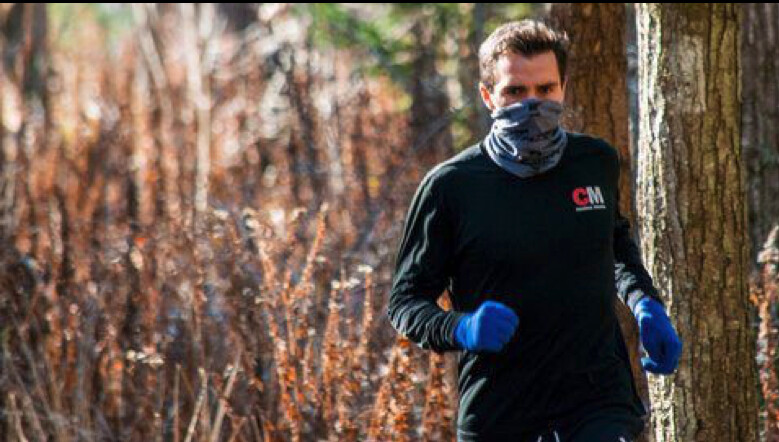
While the postings are currently largely U.S. based, many have remote options. Melanson asks for employers from locations worldwide to reach out to him and help grow the site. He adds: “A jobs board plays a small role by creating awareness and routing these people to the opportunities available in our community.”
Melanson has plans for expansion: “I envision a day in the near future, to give one example, where an applicant not only sees a job posting for a company like Strava, but also a Youtube link to an interview with a recruiter discussing what they look for in an application, why someone should be interested in working there, and more” he says.
Melanson has experience in marketing from his day job as a low-code technology platform called OutSystems. Both the job board and the Singletrack podcast are passion projects he works on in his free time.
(06/18/2022) ⚡AMPby Running Magazine
Runners in Flagstaff, Ariz. evacuated due to wildfires
Residents of Flagstaff, Ariz. have been placed on high alert as the Pipeline fire rages near their communities. Hundreds of people have been forced to leave their homes, with thousands more told to prepare to evacuate. The area is a popular place to live and train for elite athletes due to the high elevation (around 2,133m or 7000 feet).
The Pipeline fire was preceded this year by several other blazes, including the Tunnel fire, which also caused evacuations and resulted in over 19,000 acres burning.Many Canadian athletes live or spend time at training camps in the Flagstaff area, and we spoke to Canadian half-marathon record holder Rory Linkletter. Linkletter and his family have been evacuated, and he explained: “Flames were about 1km from our home. Water trucks were parked in our neighbourhood ready to fight fire from our street and protect structures.” Linkletter added that it was the second fire in the last few months within a mile of his home.


The Pipeline fire was reported on Sunday, and as of Monday afternoon, over 5,000 acres of brush and forest had burned. The Cococino National Forest reported that two additional fires, the Haywire and Double fires, are now being fought within the same area.
Firefighters have been working diligently to suppress the fires and keep them from entering the nearby communities, and temporary shelters have been designated for both people and animals.Strong winds and warm weather have made containing the fires particularly challenging. Linkletter said that fires this year had been worse than anticipated. His family includes pets and his 10-month-old son, Jason, which add challenges to being evacuated.
Linkletter added, “Last fire people were evacuated for just under a week, and we would love to get home as soon as possible. I just hope our home and everyone else’s is safe and we can come home to some normalcy. It’s obviously stressful to have the uncertainty and feel so hopeless.”Matthew Riser, 57, was arrested on Sunday in connection to the fires. Riser admitted to burning toilet paper and placing it under a rock, saying he hadn’t seen the “no campfire” signs. The Pipeline fire is named after a popular hiking trail and Riser had been camping in the area.
Linkletter expressed some optimism about the weather in the next few days. “The wind is supposed to die down tomorrow, and rain is possible on Saturday,” he said.
Olympian Jenny Simpson narrowly missed losing her house in Boulder, Co. last year in another wildfire. Boulder is another very popular city for runners to live or train, and the Marshall fire destroyed over 1, 000 homes and 6,000 acres.
(06/18/2022) ⚡AMPby Running Magazine
Complete schedule of events for the 2022 World Athletics Championships
The 2022 World Athletics Championships are headed to Hayward Field in Eugene Oregon USA for a 10-day run from July 15-24. Dubbed Oregon22, the event will mark the first time that track & field’s world championships will be held in the United States.
Eugene will be the host for 2,000 athletes from more than 200 countries.

Track events range from the 100 meters to the 10,000 meters (6.2 miles). Field events include throws (hammer, javelin, discus and shot put) and jumps (high jump, long jump, triple jump and pole vault). There also are road events, from the marathon (26.2 miles) to race walks of 20 kilometers (12.4 miles) and 35 kilometers (21.7 miles).

Here’s a day-by-day look at the Oregon22 event schedule (PDT):
DAY 1, FRIDAY, JULY 15
Morning session
9:05 a.m.: Men’s hammer, qualifying, group A
10:10 a.m.: Men’s high jump, qualifying
10:30 a.m.: Men’s hammer, qualifying, group B
11:45 a.m.: Mixed 4x400 relay, heats
12:05 p.m.: Women’s hammer, qualifying, group A
12:30 p.m.: Men’s 100 meters, preliminaries
1:10 p.m.: Women’s 20k race walk, final
1:30 p.m.: Women’s hammer, qualifying, group A
3:10 p.m.: Men’s 20k race walk, final
Afternoon session
5:05 p.m.: Women’s shot put, qualifying
5:15 p.m.: Men’s 3,000 steeplechase, heats
5:20 p.m.: Women’s pole vault, qualifying
6:00 p.m.: Men’s long jump, qualifying
6:10 p.m.: Women’s 1,500 meters, heats
6:50 p.m.: Men’s 100 meters, heats
6:55 p.m.: Men’s shot put, qualifying
7:50 p.m.: Mixed 4x400 relay, final
DAY 2: SATURDAY, JULY 16
Morning session
10:30 a.m.: Women’s triple jump, qualifying
10:35 a.m.: Women’s 3,000 steeplechase, heats
11:10 a.m.: Women’s high jump, qualifying
11:25 a.m.: Men’s 110 hurdles, heats
12:00 p.m.: Men’s hammer, final
12:20 p.m.: Women’s 10,000 meters, final
1:20 p.m.: Men’s 400 hurdles, heats
Afternoon session
5:10 p.m.: Women’s 100 meters, heats
6:00 p.m.: Men’s 100 meters, semifinals
6:20 p.m.: Men’s long jump, final
6:25 p.m.: Women’s shot put, final
6:30 p.m.: Men’s 1,500 meters, heats
7:05 p.m.: Women’s 1,500 meters, semifinals
7:50 p.m.: Men’s 100 meters, final
DAY 3: SUNDAY, JULY 17
Morning session
6:15 a.m.: Men’s marathon, final
10:35 a.m.: Women’s 100 hurdles, heptathlon
11:05 a.m.: Men’s 400 meters, heats
11:35 a.m.: Women’s high jump, heptathlon
11:35 a.m.: Women’s hammer, final
12:00 p.m.: Women’s 400 meters, heats
1:00 p.m.: Men’s 10,000 meters, final
1:45 p.m.: Women’s shot put, heptathlon
Afternoon session
5:05 p.m.: Men’s 110 hurdles, semifinals
5:05 p.m.: Men’s discus, qualifying, group A
5:25 p.m.: Women’s pole vault, final
5:33 p.m.: Women’s 100 meters, semifinals
6:03 p.m.: Men’s 400 hurdles, semifinals
6:27 p.m.: Men’s shot put, final
6:30 p.m.: Men’s discus, qualifying, group B
6:38 p.m.: Women’s 200 meters, heptathlon
7:00 p.m.: Men’s 1,500 meters, semifinals
7:30 p.m.: Men’s 110 hurdles, final
7:50 p.m.: Women’s 100 meters, final
DAY 4: MONDAY, JULY 18
Morning session
6:15 a.m.: Women’s marathon, final
9:35 a.m.: Women’s long jump, heptathlon
10:55 a.m.: Women’s javelin, heptathlon, group A
12:05 p.m.: Women’s javelin, heptathlon, group B
Afternoon session
5:05 p.m.: Men’s 200 meters, heats
5:10 p.m.: Women’s discus, qualifying, group A
5:45 p.m.: Men’s high jump, final
6:00 p.m.: Women’s 200 meters, heats
6:20 p.m.: Women’s triple jump, final
6:35 p.m.: Women’s discus, qualifying, group B
6:55 p.m.: Women’s 800 meters, heptathlon
7:20 p.m.: Men’s 3,000 steeplechase, final
7:50 p.m.: Women’s 1,500 meters, final
DAY 5, TUESDAY, JULY 19
Afternoon session
5:15 p.m.: Women’s 400 hurdles, heats
5:40 p.m.: Women’s high jump, final
6:05 p.m.: Women’s 200 meters, semifinals
6:33 p.m.: Men’s discus, final
6:50 p.m.: Men’s 200 meters, semifinals
7:30 p.m.: Men’s 1,500 meters, final
7:50 p.m.: Men’s 400 hurdles, final
DAY 6, WEDNESDAY, JULY 20
Afternoon session
3:20 p.m.: Women’s javelin, qualifying, group A
4:25 p.m.: Women’s 5,000 meters, heats
4:50 p.m.: Women’s javelin, qualifying, group B
5:20 p.m.: Men’s 800 meters, heats
6:15 p.m.: Women’s 400 hurdles, semifinals
6:30 p.m.: Women’s discus, final
6:45 p.m.: Women’s 400 meters, semifinals
7:15 p.m.: Men’s 400 meters, semifinals
7:45 p.m.: Women’s 3,000 steeplechase, final
DAY 7: THURSDAY, JULY 21
Afternoon session
5:05 p.m.: Men’s javelin, qualifying, group A
5:10 p.m.: Women’s 800 meters, heats
6:10 p.m.: Men’s 5,000 meters, heats
6:20 p.m.: Men’s triple jump, qualifying
6:35 p.m.: Men’s javelin, qualifying, group B
7:00 p.m.: Men’s 800 meters, semifinals
7:35 p.m.: Women’s 200 meters, final
7:50 p.m.: Men’s 200 meters, final
DAY 8: FRIDAY, JULY 22
Morning session
6:15 a.m.: Women’s 35k race walk, final
Afternoon session
5:05 p.m.: Men’s pole vault, qualifying
5:40 p.m.: Women’s 4x100 relay, heats
6:05 p.m.: Men’s 4x100 relay, heats
6:20 p.m.: Women’s javelin, final
6:35 p.m.: Women’s 800 meters, semifinals
7:15 p.m.: Women’s 400 meters, final
7:35 p.m.: Men’s 400 meters, final
7:50 p.m.: Women’s 400 hurdles, final
DAY 9: SATURDAY, JULY 23
Morning session
9:50 a.m.: Men’s 100 meters, decathlon
10:40 a.m.: Men’s long jump, decathlon
11:20 a.m.: Women’s 100 hurdles, heats
12:00 p.m.: Women’s long jump, qualifying
12:10 p.m.: Men’s shot put, decathlon
Afternoon session
4:10 p.m.: Men’s high jump, decathlon
5:10 p.m.: Women’s 4x400 relay, heats
5:40 p.m.: Men’s 4x400 relay, heats
6:00 p.m.: Men’s triple jump, final
6:10 p.m.: Men’s 800 meters, final
6:25 p.m.: Women’s 5,000 meters, final
6:35 p.m.: Men’s javelin, final
6:55 p.m.: Men’s 400 meters, decathlon
7:30 p.m.: Women’s 4x100 relay, final
7:50 p.m.: Men’s 4x100 relay, final
DAY 10: SUNDAY, JULY 24
Morning session
6:15 a.m.: Men’s 35k race walk, final
9:35 a.m.: Men’s 110 hurdles, decathlon
10:30 a.m.: Men’s discus, decathlon, group A
11:40 a.m.: Men’s discus, decathlon, group B
12:15 p.m.: Men’s pole vault, decathlon, group A
1:15 p.m.: Men’s pole vault, decathlon, group B
Afternoon session
5:05 p.m.: Women’s 100 hurdles, semifinals
5:05 p.m.: Men’s javelin, decathlon, group A
5:25 p.m.: Men’s pole vault, final
5:50 p.m.: Women’s long jump, final
6:05 p.m.: Men’s 5,000 meters, final
6:10 p.m.: Men’s javelin, decathlon, group B
6:35 p.m.: Women’s 800 meters, final
7:00 p.m.: Women’s 100 hurdles, final
7:20 p.m.: Men’s 1,500 meters, decathlon
7:35 p.m.: Men’s 4x400 relay, final
7:50 p.m.: Women’s 4x400 relay, final
(06/17/2022) ⚡AMPby Joel Odom
Next up is the Wanda Diamond League meeting in Paris on Saturday June 18
At 35, Jamaica’s two-time Olympic 100m champion Shelly-Ann Fraser-Pryce has done it all. But she still hasn’t finished, and her appearance at the Wanda Diamond League meeting in Paris on Saturday (18) will represent another significant step in her campaign to defend her world 100m title in Oregon next month.
Fraser-Pryce established her name early on this season’s world list when she ran in the rarified air of Nairobi and won in 10.67 - only seven-hundredths off the personal best she ran last year to put herself third on the all-time list.
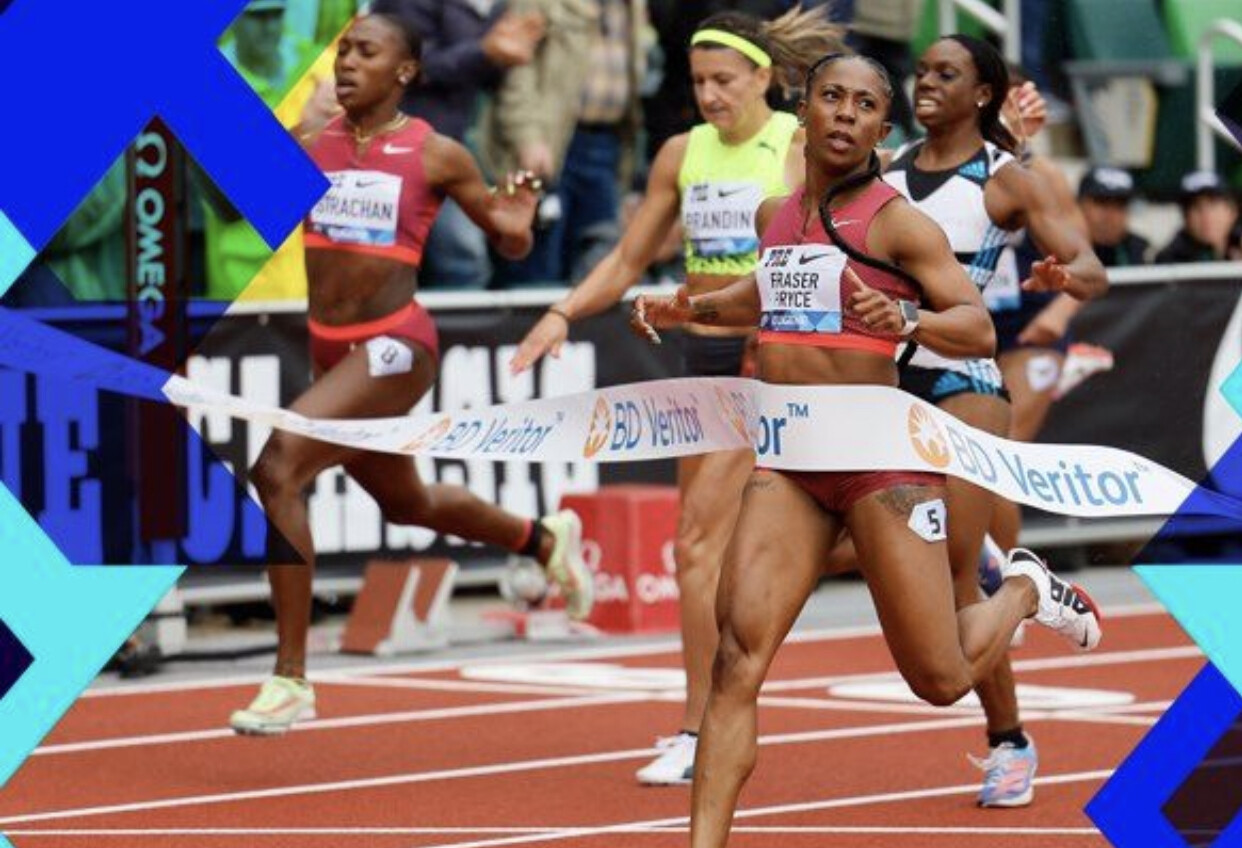
Her Jamaican compatriot and twice successor as Olympic 100m champion, Elaine Thompson-Herah, has since made a good start to her pursuit of a first individual world title with a best of 10.79 on the Eugene track that will stage the World Athletics Championships Oregon22.
But now Fraser-Pryce is back to make another impression in top-level competition at the Meeting de Paris on the ultra-fast blue track at Stade Charlety, which was renovated in 2019.
She will be taking on some talented sprinters including Switzerland’s Mujinga Kambundji, the surprise – and surprised – winner of the world indoor 60m title in Belgrade earlier this year in a personal best of 6.96. Kambundji, who turns 30 on the day before the race, will be targeting her personal best of 10.94.
Also in the mix will be Michelle-Lee Ahye of Trinidad and Tobago, who has run 10.94 this season and has a personal best of 10.82, and Marie-Josee Ta Lou of the Ivory Coast, who missed a 100m medal by one place in Tokyo as she ran 10.91.
Two-time Olympic 400m champion Shaunae Miller-Uibo, who has raced well but not exceptionally at 200m this season, will get down to serious business at her specialist event.
The 28-year-old Bahamian, who lowered her own continental record to 48.36 in Tokyo last summer, is third in this year’s top list with her time of 49.91, but that was set in April and the Olympic champion will want to check in on her current form having run over 200m recently.
She faces a strong Polish trio of Natalia Kaczmarek, who ran a huge personal best of 50.16 in Ostrava and stands sixth in this year’s world list, European champion Justyna Swiety-Ersetic and Anna Kielbasinska.
The Bahamas will be providing both Olympic 400m champions in Paris, with Steven Gardiner hoping to further fine-tune his world title defence in Oregon with a rare Diamond League appearance.
The leggy 26-year-old, who is 1.93m tall and has run 43.48, making him the sixth best performer of all time, did not compete in any Diamond League race last year and only raced once in Europe, at Szekesfehervar in Hungary.
His last appearance on the sport’s top circuit was at Monaco in 2019, when he won. Gardiner is already in good shape, having run 44.22 at Baton Rouge in Louisiana on 23 April - the fastest time recorded so far this year.
Meanwhile, European champion Matthew Hudson-Smith, who recently took one hundredth of a second off the British record of 43.36, set by Iwan Thomas in 1997, could be in position to better a record of even longer standing, this time the European one of 44.33 set by East Germany’s Thomas Schoenlebe in 1987.

Devon Allen of the United States, whose 12.84 clocking in last Saturday’s New York Grand Prix – the third-fastest ever run – earned him a handsome victory ahead of world champion and compatriot Grant Holloway, maintained winning momentum over 110m hurdles in Oslo, although this victory was earned in 13.22 into a headwind of -1.2 m/s.
Allen, who will take up a professional American football career at the end of this season as a wide receiver with National Football League side Philadelphia Eagles, is due to run in Paris against a field that includes home hurdler Wilhem Belocian.
Canada’s Olympic 200m champion Andre De Grasse has been running 100m recently to sharpen up, but after clocking 10.24 at the Birmingham Diamond League on 21 May he dropped out of the Fanny Blankers-Koen Games on 5 June. On Thursday in Oslo, however, he returned to form in the 100m – in which he won Rio 2016 bronze – as he earned victory in 10.05 from Britain’s Reece Prescod, who clocked 10.06.
On Saturday, like Miller-Uibo, he will get down to business in his main event against a field that includes Prescod, who produced a big personal best over 100m of 9.93 in blustery conditions at the Ostrava Golden Spike meeting on 31 May. Meanwhile, Alexander Ogando of the Dominican Republic will be seeking to build on what has been a good start to the season, in which he has run 20.07.
Olympic 10,000m champion Selemon Barega, who won the Ethiopian World Championships trials race in Hengelo and then finished fourth in the 5000m in Rome, is expected to race over the shorter distance in Paris.
(06/17/2022) ⚡AMPby World Athletics
Ingebrigtsen and others in record breaking form in Oslo despite the rain
A Wanda Diamond League record from Jakob Ingebrigtsen (first photo) in the mile, along with meeting records from Mondo Duplantis in the pole vault and Femke Bol in the 400m hurdles brightened a rainy evening at the Bislett Games in Oslo on Thursday (16).
Ingebrigtsen has won almost all there is to win in middle-distance events, but a senior Dream Mile victory in Oslo was one thing missing from the 21-year-old’s resume. In fact, before today no Norwegian man had ever won the prestigious discipline at the Bislett Games.
But, racing in the final individual track event of the night, Ingebrigtsen ensured the 15,000 fans at the Bislett Stadion went home happy as he won the mile in a Norwegian record of 3:46.46, breaking the Wanda Diamond League record in the process.
Paced through the first two laps in 56.01 and 1:53.30, Ingebrigtsen was tracked closely by Australia’s Oliver Hoare and Britain’s Jake Wightman for most of the race. The Olympic 1500m champion never appeared to be under too much strain, though – even when Hoare was attempting to close in on the leader with half a lap left.
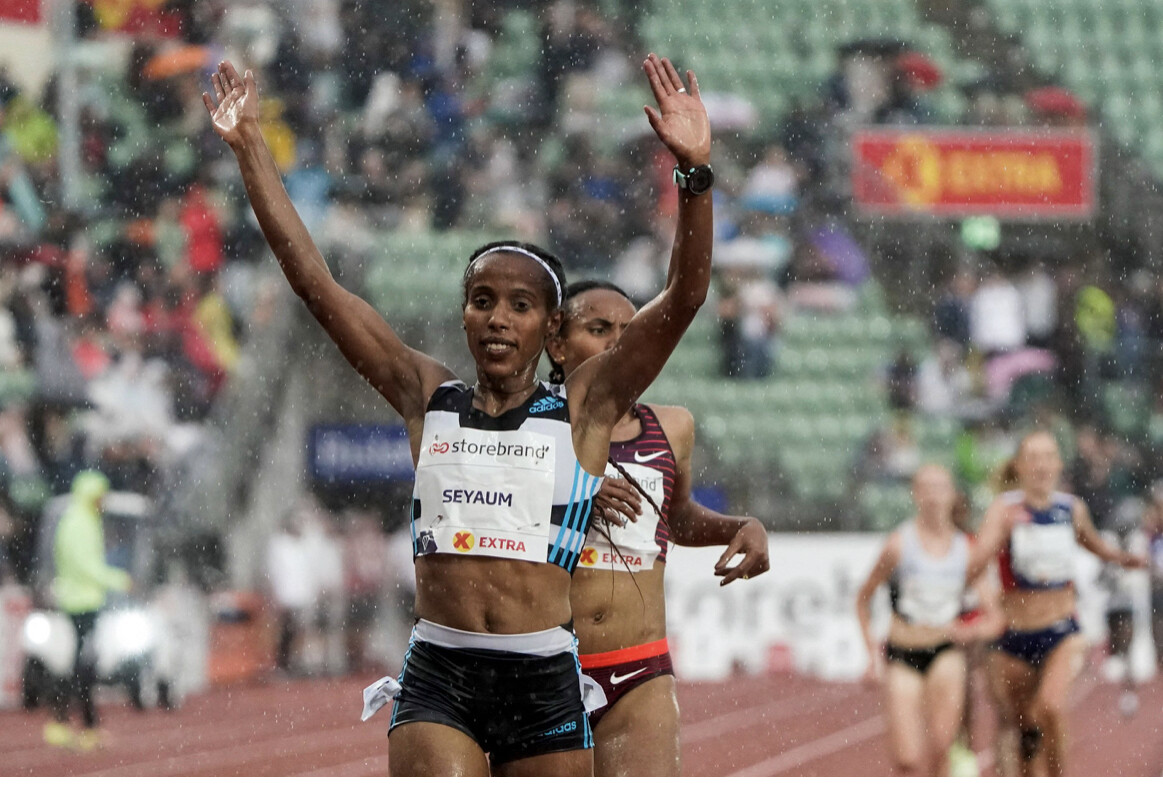
Ingebrigtsen – roared on by the home crowd, many of whom were on their feet – kicked down the home straight and crossed the line in 3:46.46, taking almost a second off his own Norwegian record and moving up to sixth on the world all-time list, just 0.14 shy of Steve Cram’s European record.
Hoare finished second in 3:47.48 to break the Oceanian record and move to 13th on the world all-time list. Wightman was third in a PB of 3:50.30 from fellow Brit Neil Gourley (3:52.91). There was also a national record for Charles Grethen of Luxembourg in fifth (3:53.20).
“I was ready to run fast and was happy to do that and to win,” said the world indoor silver medallist. “Some work needs to be done before the World Championships, but I will work hard to be in better shape there.
“Last year I was sick and couldn't race here, so it was even more special here tonight, as being the first Norwegian to win the Dream Mile. Doing things nobody else has done before is really great.”
Seyaum and Bekele lead Ethiopian 5000m sweeps
Dawit Seyaum may be new to the 5000m, but the former 1500m specialist looked anything but inexperienced as she outkicked her fellow Ethiopians to win a high-quality race.
The opening pace was steady, the first 1000m covered in 2:53.83 and 2000m reached in 5:52.33. Versatile Norwegian runner Karoline Bjerkeli Grovdal then took up the pace in the second half and passed through 3000m in 8:48.65, leading a large lead pack. Grovdal held on to that lead for another 1500 metres, but then Seyaum and compatriots Letesenbet Gidey, Gudaf Tsegay and Almaz Ayana started battling for the lead with one lap to go.
Ayana’s challenge soon faded, leaving Seyaum, Tsegay and Gidey out in front. Seyaum’s kick down the home straight was enough to break free from Tsegay and she won in 14:25.84. Tsegay, the Olympic bronze medallist at this distance, was second in 14:26.69 while world record-holder Gidey was third in 14:26.92. Grovdal held on to fourth place in a Norwegian record of 14:31.07 and USA’s Alicia Monson was fifth in a big PB of 14:31.11.
(Second photo)Dawit Seyaum celebrates her 5000m win at the Wanda Diamond League in Oslo
For just the second time in history, seven women finished inside 14:35 and eight women finished inside 14:40.
There was another Ethiopian 1-2-3 in the men’s 5000m, though this time the 1500m standout was beaten by the 5000m specialist.
The pace was steady though never blazing quick, meaning most of the field was still in contention at the business end of the race. Two-time world indoor champion Samuel Tefera led at 3000m, passing in 7:54.39, but then sat back in the pack to save his legs for a potential fast finish.
He made his way back to the front of the pack in the closing stages, but could not get on level terms with Bekele, who kicked ahead and won in 13:03.51. Tefera held on for second in 13:04.35, just ahead of compatriot Getnet Wale (13:04.48).
Keely Hodgkinson won the battle of the Brits over 800m, getting the better of fellow Olympic silver medallist Laura Muir.
The 20-year-old ran a controlled and assured race and kept her cool in the closing stages to win comfortably in 1:57.71. Muir was second in 1:58.09, ahead of France’s Renelle Lamote (1:58.50) and world champion Halimah Nakaayi of Uganda (1:58.68).
(06/17/2022) ⚡AMP
by World Athletics
How Many Days To Take Off After A Half Marathon
Running a half marathon can be very taxing. Recovering from running 13.1 miles takes time for your body to repair the damage, build back stronger, and prevent any running injuries. A lot of runners wonder how many days to take off after a half marathon. The answer depends on a lot of different factors.
Many runners make the mistake of jumping right back into training after running a half marathon. This is problematic because these runners overlook the many weeks of training it took to get to the start line and the microtears and stress on the musculoskeletal system done during the race.
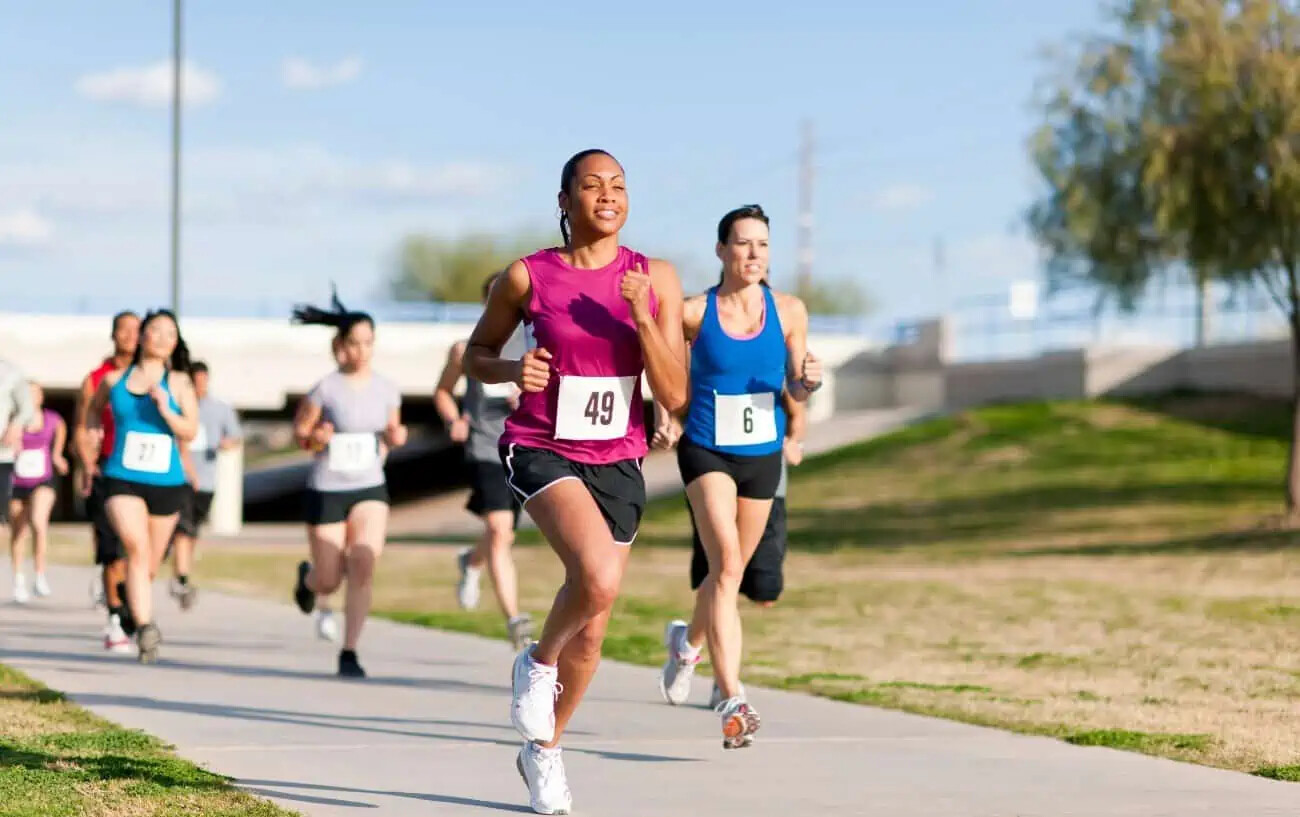
Healthy and smart runners prioritize and optimize recovery after a half-marathon, so they can build upon the fitness yielded from the training cycle and return to running faster.
In general, runners should take two to four days off running after racing a half-marathon. Note that I said racing—not running.
There is a big difference between running a half marathon at an easy pace versus running one at a hard effort.
If your half-marathon was your goal race, you should take at least two to four days of rest.
It’s possible to run two days after a half marathon if your half marathon was treated as a long training run done at a comfortable pace or your half marathon time was less than 90 minutes.
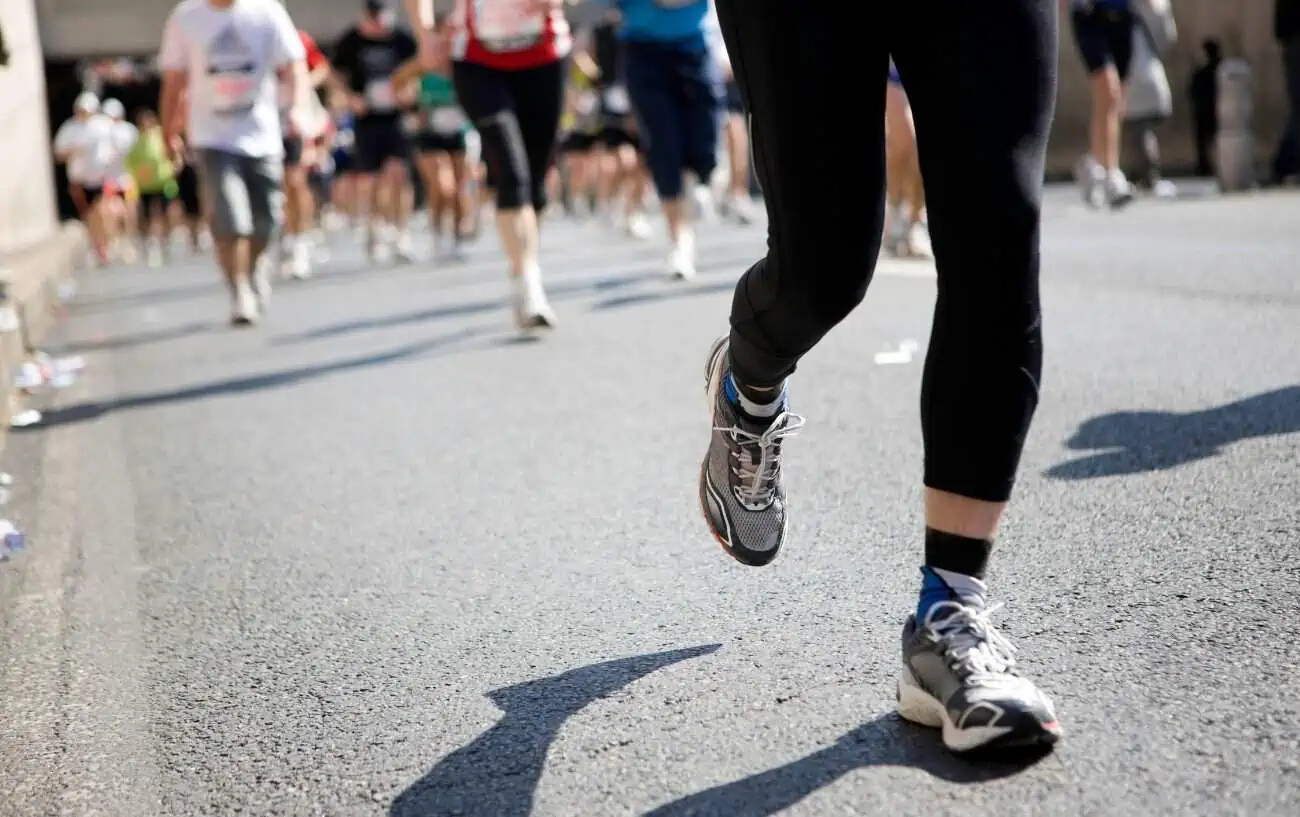
If your time was longer than 2 hours, it’s recommended to take up to a week off of running.
What Factors Determine How Many Days To Take Off After A Half Marathon?
There are many factors that determine how many days to take off after a half-marathon. The recovery time for your friend will likely not be the same as yours, so throw out comparisons and look hard at the following variables.
Six Factors That Determine Half Marathon Recovery Time
#1 - Race Effort
How hard you ran will determine how many days to take off after a half marathon.
If you ran your half marathon as a goal race or at a hard effort, you’ll need more time off from running (at least 2 to four days).
If you ran the race as a training run at an easy pace, you may not need to take any time off at all. It’s possible to do a light recovery jog the day after, keeping your heart rate low and distance short.
#2 - Race Result
How the race went will also determine how much time you may need to take off running after your half marathon.
If your race went poorly and you are feeling upset, it’s prudent to take several days to mentally recover and refocus.
If the race went poorly and, as a result, didn’t overly tax the body, you can resume running as long as you aren’t mentally shaken.
If the race went according to plan or better, resume training as normal after 1-4 days off.
If the race went well, but you are feeling fatigued, rest at least 2-4 days.
#3 - Race Experience
Whether running 13.1 miles is routine or a first for you determines how many days to take off after a half marathon. Many novice runners will not cover 13.1 miles until race day, while experienced runners will cover that distance at least one day per week.
If you haven’t covered the half marathon distance before race day, take 5-7 days rest, or more, as needed.
If you have covered the race length in training, resume easy running after 1-4 days of recovery if you are feeling up to it.
#4 - Race Time
The longer it takes you to complete 13.1 miles, the longer amount of recovery time you will need.
If it took you less than 90 minutes to run a half-marathon, you may need only 2-4 days of rest.
If it took you longer than 2 hours to run a half marathon, your body may need up to a week off of running.
#5 - Injury History
If you were recovering from an injury or staving one off during your half marathon training cycle, it’s smart to take more time off running. A week off running may help your body repair damaged tissue.
#6 - How You Feel
All these tips are guidelines and should not overrule how you feel. If you ran a half marathon in 90 minutes, it went great, but if you still feel drained after four days off running—then take more time to recover.
Nothing should override how you feel. And only YOU know how you feel. So, listen to your body over advice from your coach, your friends, or even this article. In general, all runners benefit from taking at least 1-2 days completely off during half marathon recovery. However, be sure to get in some walking during this time. Get plenty of sleep and drink plenty of water.
(06/17/2022) ⚡AMPby Whitney Heins
What Are therapeutic use exemptions and Why Are They Controversial?
Athletes such as Molly Seidel, who was recently diagnosed with ADHD and prescribed Adderall, must receive exemptions from doping agencies in order to use medications that are banned.
Olympic bronze medalist Molly Seidel announced on Instagram on June 8 that she’d be missing the New York Mini 10K last weekend. The reason? She’d been diagnosed with ADHD early in 2022, and after the Boston Marathon, she started taking the prescription drug Adderall.

Adderall is banned by the World Anti-Doping Agency (WADA) for use in competition, because it can be used as a performance enhancer. But Seidel has a legitimate medical need for the drug, so she can apply for a therapeutic use exemption, commonly known as a TUE.
Seidel wrote on Instagram that she applied for a TUE about six weeks ago, and she won’t have an answer on her application until the end of June at the earliest.
Since she started taking Adderall, she had been feeling much better. “I felt like I was able to get the quiet, functioning brain in my day-to-day life that I could previously only achieve with intense physical activity,” she wrote. “It also gave me remission of many eating disorders behaviors that I’ve dealt with consistently since my teens.”
She was disappointed to pull out of the New York Mini 10K. Seidel wrote, especially after she has had a tough few months. (She dropped out of the Boston Marathon in April with a hip impingement at about the 16-mile mark.)
“However, I’m committed to a clean sport and respecting my own mental health needs, so that means following the appropriate procedures of this TUE process,” she wrote. “Mental health takes work, and I want to be transparent about the fact that medication is sometimes a very necessary part of that work.”
Seidel is due to run the World Championships marathon in Eugene on July 18.
Her case illustrates a years-long debate among athletes, coaches, and officials about TUEs. At issue: How can the sport allow its athletes to legally obtain treatment for diagnosed medical conditions while preventing others from abusing the system?
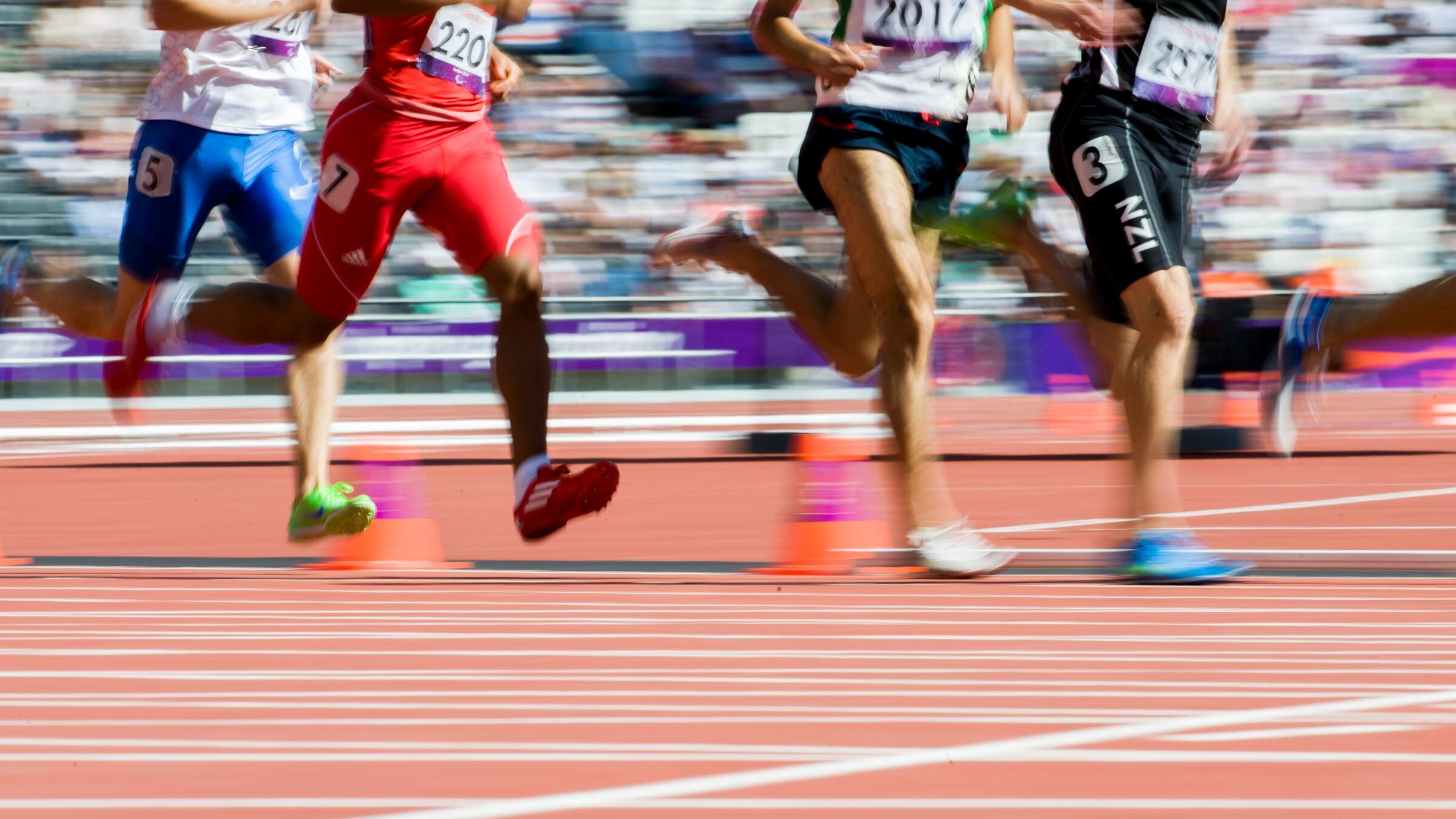
Below, we answer a few common questions about TUEs.
What is a therapeutic use exemption (TUE)?
When an athlete is sick or has a condition that requires treatment with medicine that is listed on WADA’s prohibited substance list, he or she can be granted a TUE to take the drug, according to the U.S. Anti-Doping Agency (USADA).
Some drugs are prohibited when an athlete is competing. Other drugs are also banned for out-of-competition use. If a TUE is approved, it usually has a starting and ending date during which the athlete may take the medication. If the athlete is drug tested during that period and tests positive for an illegal substance for which they are granted an exemption, he or she will not face disciplinary measures.
In an emergency situation, if somebody is treated with a prohibited substance, he or she is allowed to file an emergency TUE afterward, as soon as possible. For example, when Shalane Flanagan received an IV for severe dehydration in February after the 2016 Olympic Marathon Trials, which is otherwise a banned practice, she was granted an exemption because she was in medical need.
“I resisted getting an IV but a lot of the doctors there were insisting that I needed it,” Flanagan said, weeks after the race. “It would have taken a really long time to get those fluids in orally. So the IV really speeded up my recovery. It actually made me realize probably why they are illegal [in competition] under most circumstances—my core temperature immediately went down. If I hadn’t had that, I would have had a much longer process.”
How does an athlete get a TUE?
U.S. athletes apply for a TUE through USADA, though if somebody is also competing at an international event, it may require that person to obtain another exemption through World Athletics, the governing body for track and field.
“The TUE application process is thorough and designed to balance the need to provide athletes access to critical medication while protecting the rights of clean athletes to compete on a level playing field,” according to USADA.
If a pro runner is in need of a TUE, he or she downloads the application and completes it with a doctor. A medical file must accompany the application.
Who decides if the athlete gets a TUE?
The Therapeutic Use Exemption Committee reviews the application, the medical details, the patient history, test results, how the condition has been managed over time, and attempts to treat it with non-prohibited medications and methods. Galen Rupp, for example, has been granted exemptions to take prednisone to treat asthma.
The committee includes doctors and medical experts, according to USADA. They review and either approve or deny the application without knowing the athlete’s name by following WADA’s standards, outlined in an annual 30-page document.
WADA policy states that athlete must prove that the prohibited substance is needed to treat an acute or chronic medical condition, “such that the athlete would experience a significant impairment to health” if it is withheld; that the medication is highly unlikely to produce any enhancement of performance beyond what would be considered “anticipated” by a return to the individual’s normal health; and that there is no reasonable alternative to treat the condition.
What is on the WADA prohibited substance list?
The prohibited list includes more than 300 substances and methods of taking substances (for example, orally, by injection, intravenously). It also includes those that are always prohibited and those that are only prohibited during a competition. The lists are updated by WADA each year, and it’s up to the athletes to be aware of changes of the rules.
Some examples of prohibited substances include steroids, human growth hormone, certain stimulants, diuretics, and masking agents that can interfere with drug tests.
How could an athlete use TUE system or prescription drugs to cheat?
Athletes at the highest level are constantly searching for fractions of percentages in performance gain. Some, of course, seek such gains illegally. Should that athlete have a support team of coaches and doctors who also engage in unethical practices, they can collectively seek exemptions for medications that are not medically needed but could produce a competitive advantage.
In July 2015, Rupp and his coach Alberto Salazar were accused by former members of the Oregon Project of manipulating the TUE system for performance gain and faking symptoms in an effort to be prescribed legal thyroid medications. Those medications could help with a runner’s energy levels, allowing an athlete to train with more intensity and volume. Rupp and Salazar have strongly denied those accusations. Salazar has since received a four-year ban for trafficking performance-enhancing drugs to his athletes and in a separate matter, he has been banned permanently from track by SafeSport.
(06/17/2022) ⚡AMPby Runner’s World
Simeon Birnbaum becomes 17th high schooler ever to run sub 4-minute mile
Rapid City Stevens distance runner Simeon Birnbaum became just the 17th United States high-schooler ever to run a sub 4-minute mile.
While competing in the Brooks PR Invitational in Seattle on Wednesday, Birnbaum finished the mile race in 3:59.51, winning the event in a historic way.
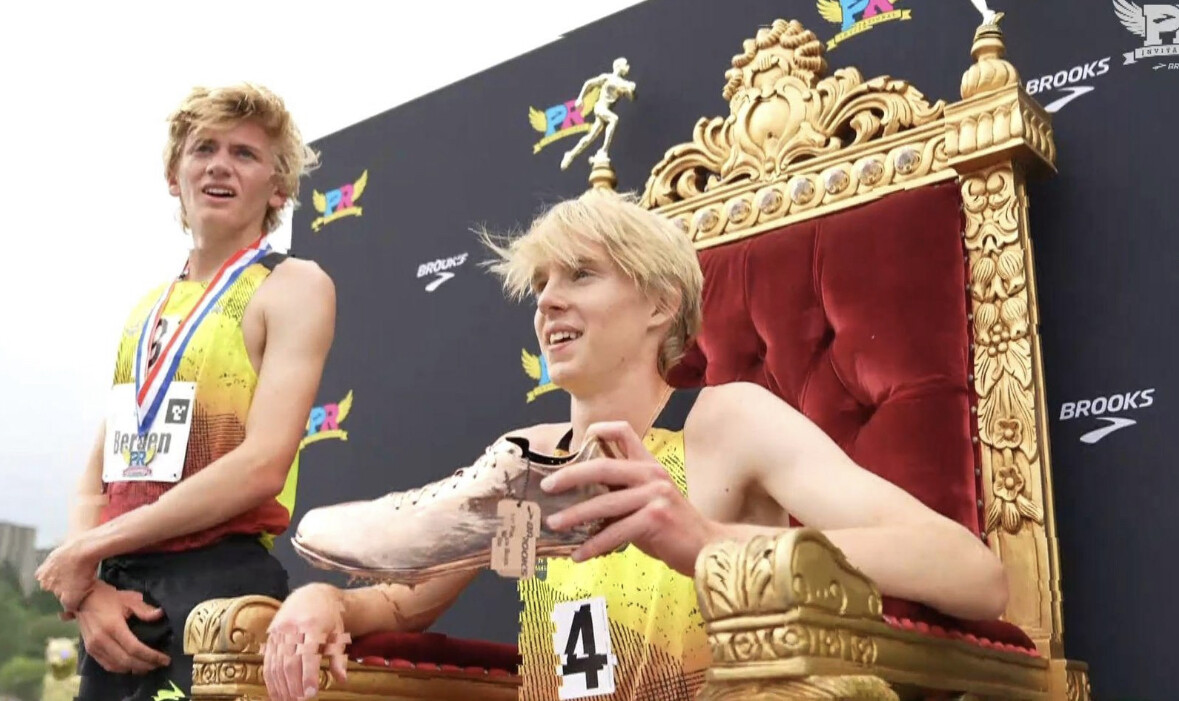
Birnbaum, who set several records at the South Dakota state track and field meet in late May, told the Argus Leader in April he had his sights set on the feat for his senior season. By hitting the mark in the summer of his junior year, he is the third high-school junior to ever run a sub 4-minute mile. Southern Boone (Missouri) High School junior distance runner Connor Burns also broke sub 4-minutes this year.
Birnbaum had already set the South Dakota high school mile record at the Arcadia Invitational in California with a time of 4:07.88. Wednesday, he ran more than eight seconds faster.
"There's some really great youngsters out there, and I think they can come up and get these records now, so I'm really going to try to lower them for them," Birnbaum told the Argus Leader after setting the state meet record in the 800-meter run at the state track and field meet.
Birnbaum is one of five runners to break the milestone this year, along with Burns, Nease (Florida) High School runner Rheinhardt Harrison, Archbishop Wood (Pennsylvania) runner Gary Martin and Newbury Park (California) High School runner Colin Sahlman. Sahlman and Martin each have broken it twice this year.
(06/16/2022) ⚡AMPOne month to go - Road to Oregon22
One month from yesterday, the World Athletics Championships Oregon22 – the first to be held in the United States – will get under way at the all-new Hayward Field in Eugene.
One week from today, that same venue will stage the fearsome, first-three-home drama of the USATF Championships, where home athletes will seek to earn the right to return to the re-built arena once the global event starts on 15 July.

The perennial jeopardy of that event means that some of the most likely home medallists cannot yet be inked in for the World Championships. But wild card entries for defending champions mean that US athletes such as 200m gold medallist Noah Lyles, who has demonstrated convincing form in recent weeks and days, will count on toeing the line.
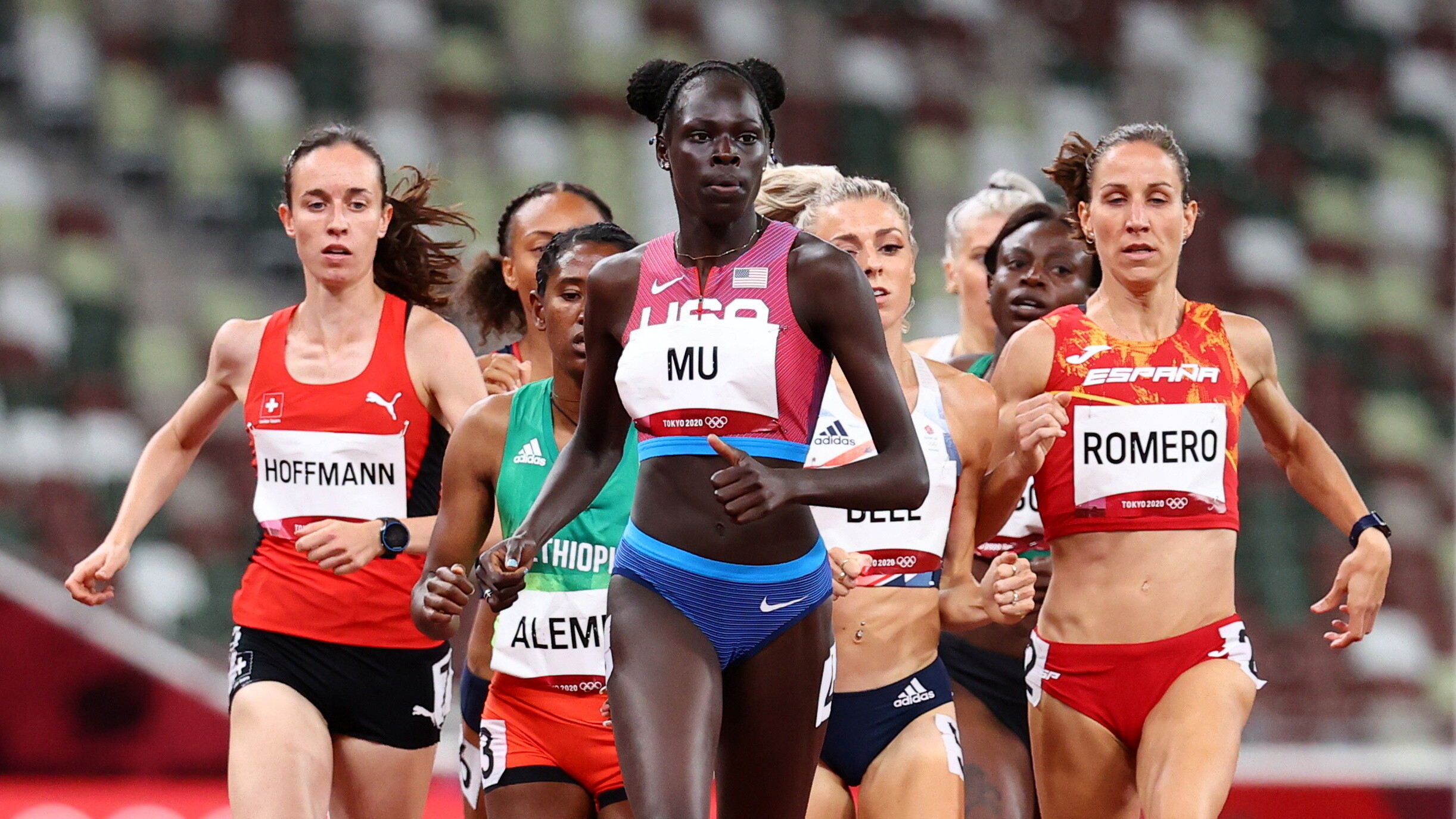
Prospective challengers for medals in Eugene, notably from Europe and Africa, have been laying down their markers in earnest over the last fortnight, however, as the meetings have come thick and fast. The level of excitement and anticipation is rising rapidly on the Road to Oregon.
Britain’s Keely Hodgkinson has her sights firmly set on world 800m gold in Oregon. As does her fellow 20-year-old Athing Mu of the US, who beat her to Olympic gold in Tokyo last year. Something has to give.
Hodgkinson eschewed an almost certain 800m medal at the World Indoor Championships in March as a precaution after feeling a muscle twinge in warm-up for the final – it had to be gold or nothing for her, and she didn’t want to risk what promises to be a richly busy outdoor season.
After an impressive victory in Birmingham she travelled to the Eugene Diamond League keyed up for a pre-World Championships battle with her rival, only to find that Mu was a no-show following the after-effects of having Covid-19.
The Briton did all she could to lay down a big marker on the track where the world golds will be disputed, piling in to win in 1:57.72, the fastest time of the year.
The glove was down. And less than a fortnight later at the Rome Diamond League meeting it was firmly grasped by Mu as she answered the challenge by romping home to win in 1:57.01.
Emmanuel Wanyonyi, the phenomenal 17-year-old who won the world U20 men’s 800m title on his home track of Nairobi last year, has maintained impressive momentum this season, winning in 1:44.15 in Ostrava and coolly outrunning Botswana’s 2012 Olympic silver medallist Nijel Amos at the Rabat Diamond League meeting to win in 1:45.47.
In the Moroccan capital, local hero Soufiane El Bakkali, whose Tokyo victory in the men’s 3000m steeplechase provided his country with its only medal from the Games, once again defeated his great Ethiopian rival Lamecha Girma in a race that nearly blew the roof off the Prince Moulay Abdellah Stadium.
(06/16/2022) ⚡AMPWorld Athletics Championships Budapest23
Budapest is a true capital of sports, which is one of the reasons why the World Athletics Championships Budapest 2023 is in the right place here. Here are some of the most important world athletics events and venues where we have witnessed moments of sporting history. Throughout the 125-year history of Hungarian athletics, the country and Budapest have hosted numerous...
more...Injured or in a running rut? Try volunteering, a day spent volunteering at a race just might be the best thing you do all summer
While it’s temping to pack the warmer months with training and racing, taking a weekend off to volunteer at an event may be more rewarding than you’d expect. Last summer, an injury sidelined me right before an 80km race I had entered. Disappointed, and with a weekend at the race locale already booked, I offered to take on some volunteer shifts, dragging my race crew (hey, they’d already planned to help me that weekend) along with me. It was the best choice I had made all year. Here’s why you should sign up to volunteer this season:
The running community is incredible, and you’ll be reminded of that over and over
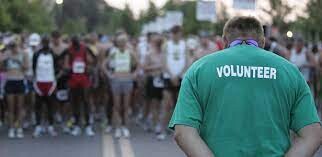
When my crew and I showed up at the aid station we were set to handle, we had no idea what was ahead of us. It was neat to see the incredibly fast first runners go through, but it was the midpack and back of the pack runners that won our hearts. Always thankful, some runners came in needing a quick electrolyte-mix refill and headed back out, while others needed to rest for a bit, or asked for ice (or a bucket to throw up in). Despite clearly feeling the full gamut of race-day emotion, they expressed gratitude and enthusiasm and cheered one another on.
You get an opportunity to give back

If you’ve raced before, you know how essential the volunteers are. They’ll give you directions, a pep talk, or find a first-aid kit for you, all with a smile. From a 5 km local fun-run to a 100-mile ultra, volunteers are often the backbone of the event. Being on the other side of the table is an act of service to your running family and your community at large.
You’ll learn valuable lessons for your next race
After noticing many runners asking for Coke at our aid station (which, to our dismay, we didn’t have), I decided to try one the next time I was able to go on a long training run, and I discovered how satisfying it was. I noticed how contagious positivity was, and made a mental note to be more thankful of the volunteers the next time I competed. It was also a great reminder of how fun races can be, something that can get lost when chasing personal bests.
It’s good for you
Studies show volunteering boosts mental health. Not only do volunteers feel connected to their community, but they meet new people and experience health benefits. We all know volunteering in general is helpful to others, but you’ll also be benefiting while you hand out medals or refill water bottles.
It’s as much fun as running (and maybe even more)
Our day at the aid station was so enjoyable that we picked up an additional night shift, and found it exhilarating to see runners of all speeds finish the event. I was surprised to discover that the enhanced sense of community and well-being I basked in after running in a race carried over to volunteering. For weeks, my husband and I reminisced about the people we met and the interesting things we witnessed, and we immediately signed up to volunteer regularly at a local event.
(06/16/2022) ⚡AMPby Running Magazine
In order to win his first Dipsea Race 28-year-old Eddie Owens had to study it first.
Two years ago when he moved to San Francisco, Eddie Owens knew nothing about the Dipsea – the country’s oldest trail race – other than what he heard from area runners. It prompted him to visit Marin County to meet Dipsea historian and author Barry Spitz, who has written the quintessential book about historic race, “Dipsea: The Greatest Race.” Owens bought a book from Spitz and said he was curious about the fastest times on record in the race.
Apparently, Owens not only read about them, but he appears hell bent on eclipsing them.
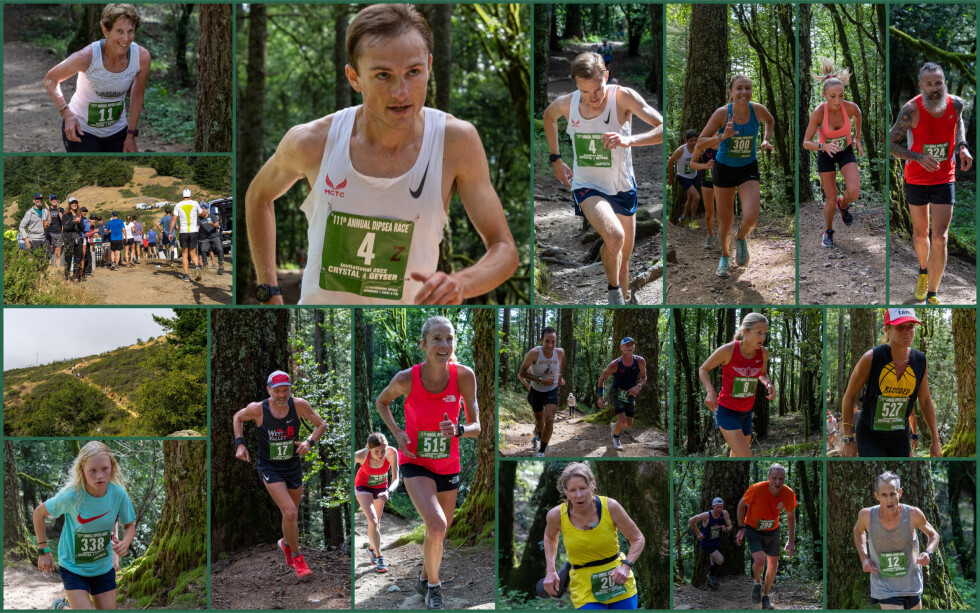
With a time of 48:35 on Sunday – more than a minute faster than anyone else in the field – Owens easily won the 111th Dipsea with a race for the ages. He became the first runner in his 20s to win the historic 7.5-mile foot race from downtown Mill Valley to Stinson Beach since 25-year-old Carl Jensen was the last person to win the event from scratch in 1966.
That feat followed Owens’ astonishing Dipsea debut effort last November when he denied Alex Varner of a 10th Best Time Award by finishing fourth overall with an actual running time of 47:47, the fastest in 26 years.
Owens, who grew up in Brooklyn, N.Y. and attended Princeton University, obviously is a fast learner when it comes to the Dipsea.
“I’ve run races all over the country and all over the world, but there is nothing like the Dipsea,” said Owens, who was a member of Team USA at the 2021 World Mountain and Trailrunning Championships. “I look forward to coming back for many years and decades to come.”
Owens was given a one-minute head start on Sunday in the Dipsea, a unique race in which each of the 1,500 runners are assigned head starts based on age and gender. With a two-minute head start Paddy O'Leary, a 34-year-old cancer researcher from San Francisco, finished second one minute and 17 seconds behind Owens and Clara Peterson, a 38-year-old mother of four from Corte Madera who was a two-time All-American cross country runner at Duke University, was third. She started seven minutes in front of Owens’ starting group and posted the fastest time (58:45) by a female in the race, finishing one spot ahead of Stephanie Howe of San Rafael, another two-time NCAA All-American in college (Northern Michigan University) who was making her Dipsea debut. Fiona Lyon and two-time Dipsea winner Chris Lundy finished right behind, the first time since 1992 that four females have finished in the Top Six of the Dipsea.

Mark Tatum, the defending Dipsea champion from Colorado Springs, CO, placed eighth overall.
Peterson and Howe -- along with two-time Dipsea champion Diana Fitzpatrick of Larkspur, 25-time Black Shirt winner Brad Byron of Penngrove, and Tanya Fredericks of San Anselmo – pushed the Tamalpa Runners into a remarkable first-ever tie with rival Pelican Inn Club for the Dipsea’s Team Trophy. Alex Varner, Cliff Lentz, Don Stewart, Jeffrey Stern, and John Gardiner were the top runners for Pelican Inn which won the team trophy last year.
The mother-and-son team Elena Shemyakina of Geneva, IL and Mikhail Shemyakin of Mill Valley won the Alan Beardall Family Trophy for the third time and Berkeley High School student Oliver Nickelsen claimed the First High School Boys Finisher for the second year in a row and won another Dipsea Black Shirt. He was joined in that select group by seven first-time Dipsea Black Shirt winners (Carolyn Latham, Benjamin Koss, Anthony Fagundes, Taylor Fortnam, Lacee Phillips, Patrick Wachter, and Ibet Allen.)
Emma Dunmire of Tamalpais High School was the First High School Girls Finisher, and Patrick Green of Long Beach was the first finisher in the race from the Dipsea Runner’s Section.
Diana Fitzpatrick, who won her record-tying 19th Dipsea Black Shirt to match Dipsea Hall of Famer Jamie Rivers, was named the recipient of the Norman Bright Award for “Extraordinary Effort in the Dipsea Race” in a post-race awards ceremony staged in person for first time at Stinson Beach Park since June 2019 before the COVID-19 pandemic. Robert Alexander, who made his Dipsea Debut in 1984 at the age of 32 when he placed 13th overall, was named the recipient of the Dipsea Demon Award for “dedication, perseverance and performance over time” to honor ” the late Jack Kirk, who completed a record 67 consecutive Dipseas, the last at the age of 95. Alexander, 66, competed in his 38th consecutive Dipsea on Sunday. Longtime Dipsea volunteer Mari Allen, who led the charge in organizing a centennial celebration of the Women’s Dipsea Hike in April, was named recipient of Red Tail Hawk Award for “Leadership, Dedication and Sportsmanship” named in honor of the late Jerry Hauke, the Dipsea Race director for 37 years.
This year’s Dipsea race featured runners from a total of 30 states plus the District of Columbia were entered in the 111th Dipsea from as far away as Maine and Italy.
The oldest runner entered was 84-year-old Norman Pease of Orinda and the oldest female entered was 80-year-old Emma Ulvestad of Mill Valley. The youngest girl entered was 8-year-old Caleesi Beck of Mill Valley and the youngest boy entered was 5-year-old Christopher Ciaschini of Mill Valley.
(06/15/2022) ⚡AMPThe Dipsea Race
First run in 1905, the Dipsea is the oldest trail race in America. It is run every year on the second Sunday in June. The scenic 7.4 mile course from Mill Valley to Stinson Beach is considered to be one of the most beautiful courses in the world. The stairs and steep trails make it a grueling and treacherous race....
more...127th 2023 Boston Marathon Field Size Established as 30,000 Participants and Registration to be held September 12–16, 2022
The Boston Athletic Association (B.A.A.) announced today that the field size for the 127th Boston Marathon, scheduled to take place on Monday, April 17, 2023, has been established as 30,000 participants. Registration will take place over five days, September 12–16, 2022.
“The 127th Boston Marathon will be another significant moment in B.A.A. history, as we recognize and honor the tenth anniversary of 2013,” said Jack Fleming, Acting Chief Executive Officer of the B.A.A. “On the third Monday in April 2023, athletes from around the world will gather with the resilience and spirit that has distinguished the Boston Marathon as the premiere event in road racing.”

Registration will open on Monday, September 12 at 10:00 a.m. ET and will close on Friday, September 16, 2022 at 5:00 p.m. ET. The B.A.A. will use the same registration process for qualified runners as it used for the 2021 and 2022 races, allowing any athlete who has achieved a currently valid Boston Marathon qualifying time to submit a registration application between September 12–16, 2022 through the B.A.A.’s online platform, Athletes' Village.
Registration is not on a first-come, first-served basis and applications will be accepted until 5:00 p.m. ET on Friday, September 16. The 2023 Boston Marathon qualifying window began on September 1, 2021 and will close at 5:00 p.m. ET on Friday, September 16.
Qualifying standards for the 127th Boston Marathon can be found here. Qualifiers may submit an application at any point during the registration window. Achieving one’s qualifying standard does not guarantee acceptance into the Boston Marathon. Those who are fastest among the pool of applicants in their age and gender group will be accepted.
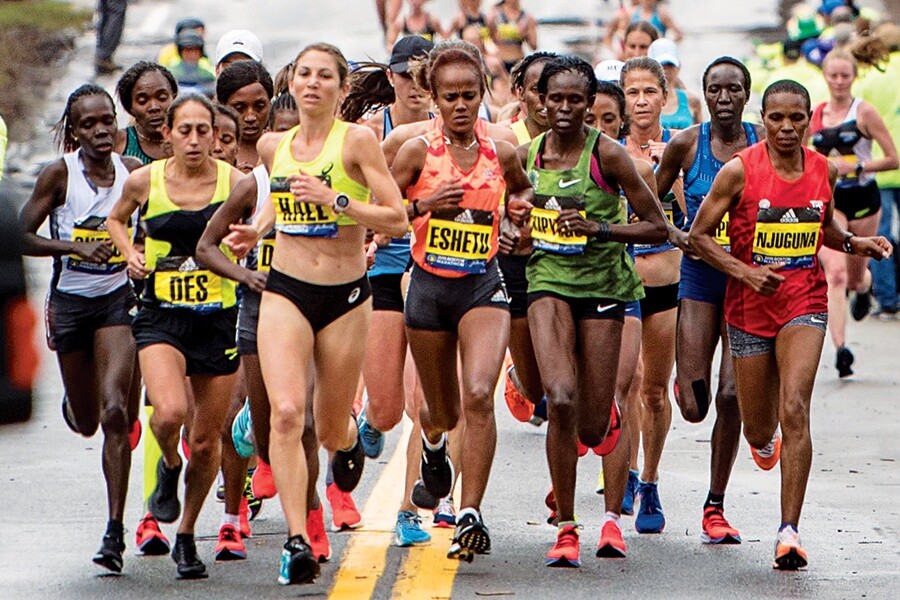
Entry fees and information on health and safety guidelines, including any COVID-19 policies, will be announced in the coming weeks. For the third straight year, participants will have the opportunity to purchase registration insurance at the point of registration.
The qualifying window for the 128th Boston Marathon, scheduled to take place on April 15, 2024, will begin on September 1, 2022. Registration details for that race will be announced following the 2023 Boston Marathon.
The next B.A.A. event is the B.A.A. 10K presented by Brigham and Women’s Hospital on Sunday, June 26.
(06/15/2022) ⚡AMP
Boston Marathon
Among the nation’s oldest athletic clubs, the B.A.A. was established in 1887, and, in 1896, more than half of the U.S. Olympic Team at the first modern games was composed of B.A.A. club members. The Olympic Games provided the inspiration for the first Boston Marathon, which culminated the B.A.A. Games on April 19, 1897. John J. McDermott emerged from a...
more...New personal best set at the KATA 10k Time Trial
The tenth edition of Kenya Athletics Training Academy 10kilometres monthly time-trial took place on Wednesday in Thika Kenya with Peter Wanyoike running a new personal best and winning again.
Sibling rivalry marked the event with upcoming Erick Mutuku and consistent Zakaria Kirika fighting for the runner-up position during the run that brought together 16 participants.
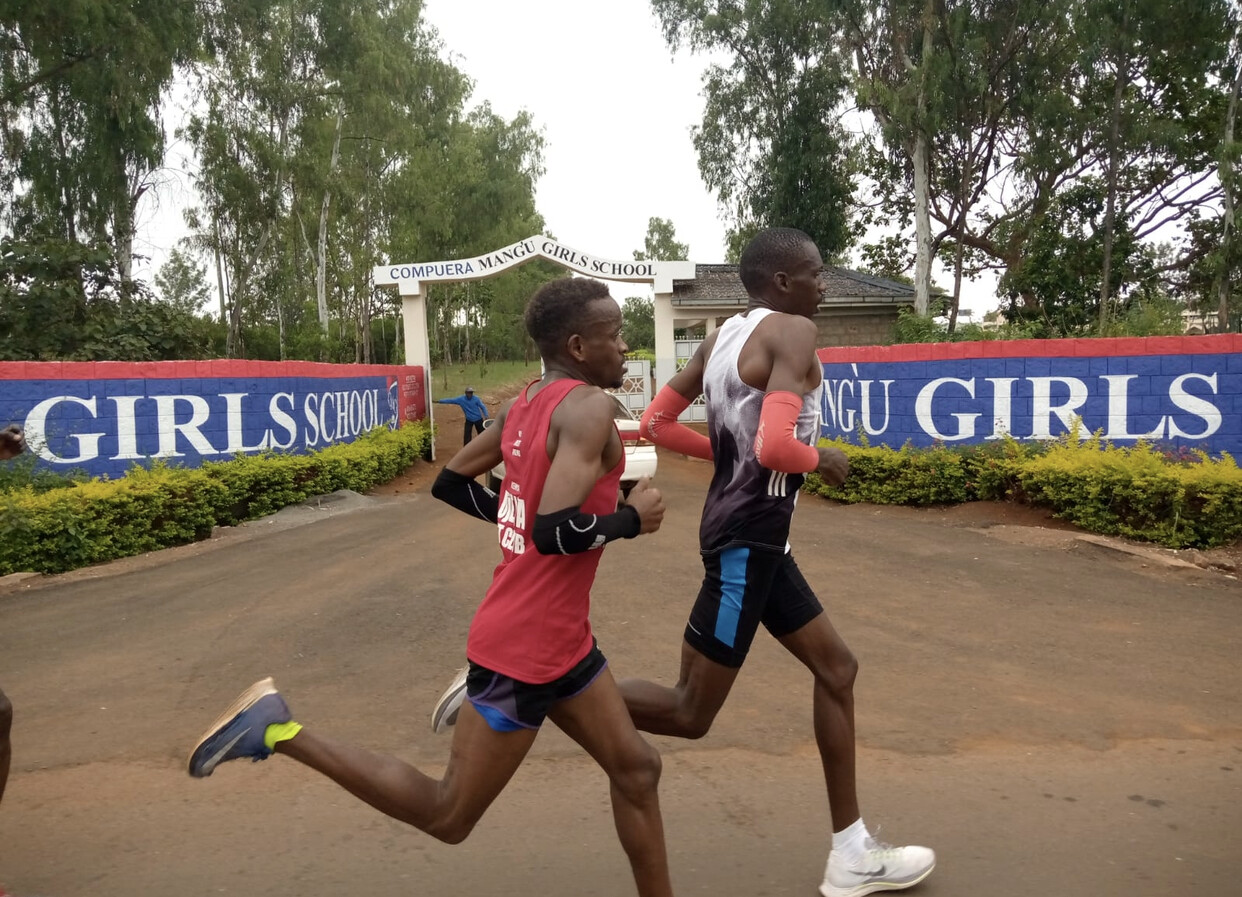
Wanyoike, winning the trial for the 4th time in a row, clocked 29:53.19 to beat his previous 29:53.68 registered during the 8th edition in April.
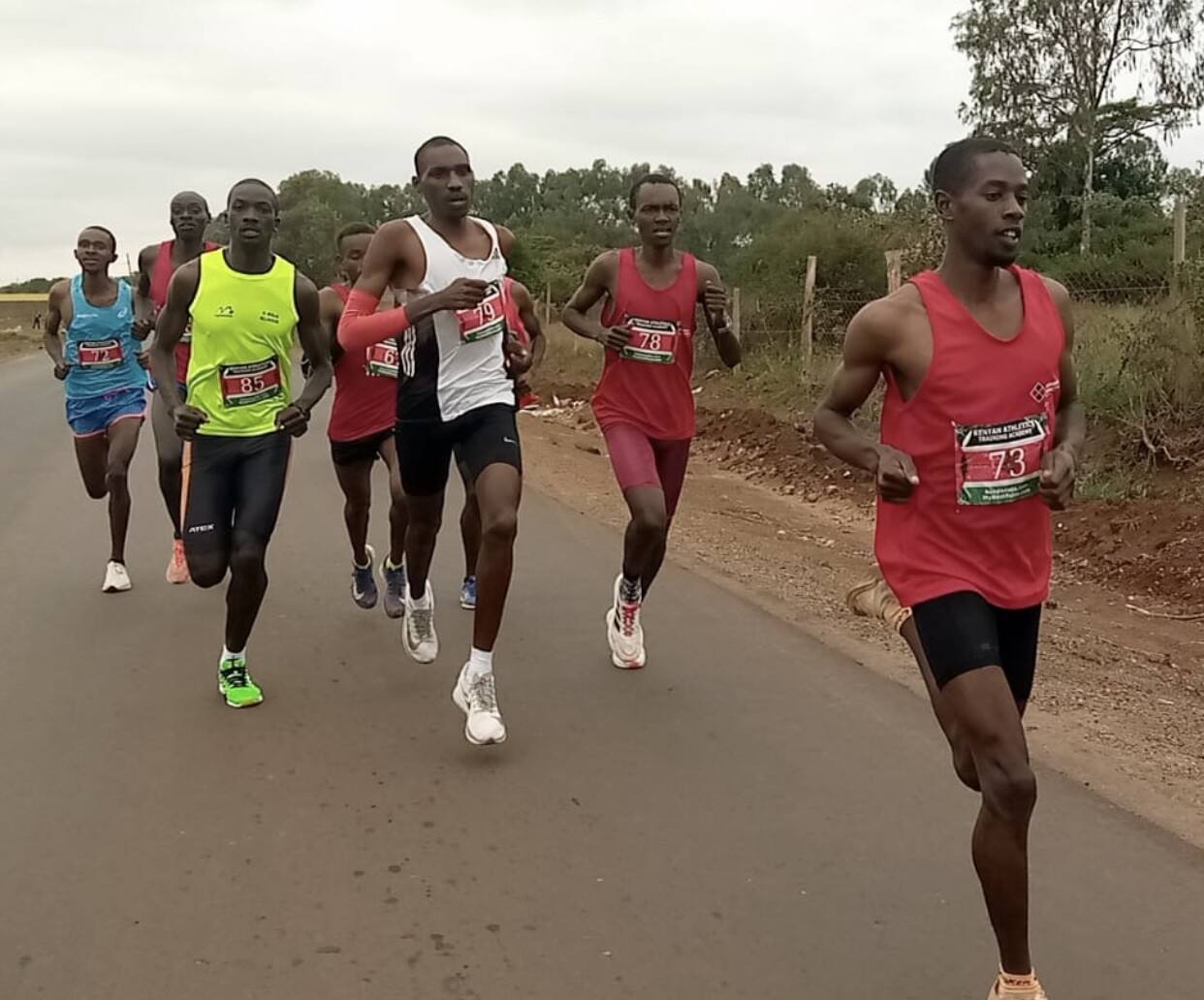
Kirika was dislodged from his second position by Erick Mutuku who timed 30:03.18. Kirika managed 30:14.86 in third place.
The monthly trial has become a yard stick forgauging individual speed with young and upcoming athletes reaping maximum benefits.
Levis Kuria, Erick Mutuku, Boniface Mungai, Nicholas Kitundu and Raphael Gacheru, all in their early 20s, attained their individual records with significant margins.
Kuria clocked 31:32.75, improving his previous 33:03.46 while Mutuku and Mungai timed 30:03.18 and 31:25.79 from 30:14.67 and 32:30.42 respectively.
The next KATA 10K Time-Trial will take place on 13th of July at the same place.
RESULTS
NAME BIB TIME Age
1.Peter Wanyoike 79 29:53.2 26
2. Erick Mutuku 67 30:03.2 20
3. Zakaria Kirika 78 30:14.9 21
4. Nichola Kitundu 72 31:13.3 22
5. Fredrick Kiprotich 76 31:21.9 23
6. Raphael Gacheru 70 31:25.5 22
7. Boniface Mungai 77 31:25.8 23
8. Robinson Mwaura 85 31:31.4 29
9. Levis Kuria 66 31:32.8 21
10. Geoffrey Mwangi 82 34:24.4 40
11. Erick Mugo 73 34:45.8 29
12. Paul Ng’ang’a 71 34:48.1 42
13. Charles Ndirangu 80 37:03.5 62
14: Peter Mukundi 81 37:36.1 25
15. Wisely Kipkirui 84 38:38.9 24
16. Ann Wangu 83 46:47.2 30
(06/15/2022) ⚡AMPby Coach Joseph
KATA Time Trial Series
The Kenyan Athletics Training Academy (KATA) in Thika Kenya stages a monthly time trial. Starting Sept 2021 this monthly event is open to anyone who would like to get an official time on a acurant course. Results will be published at My Best Runs so race directors and other interested people can see what kind of shape our participants are...
more...Red Bull 400 is the Steepest Race in the world!
Founded by Red Bull in 2011, the Red Bull 400 is the most intense and steepest 400-meter uphill sprint in the world. Ski jumping and ski flying hills have a total distance of 400 meters (1312 feet) and a maximum incline slope of 37 degrees, which competitors from around the world attempt to beat. When it comes to running, there's no better challenge than the Red Bull 400, an almost vertical dash that will put your speed, endurance, and general fitness to the test. Regardless of how difficult the race may be, the view from the top is quite breathtaking. The bettor will take bets on your achievable time for the athletes.
Things to know about the steepest race in the world
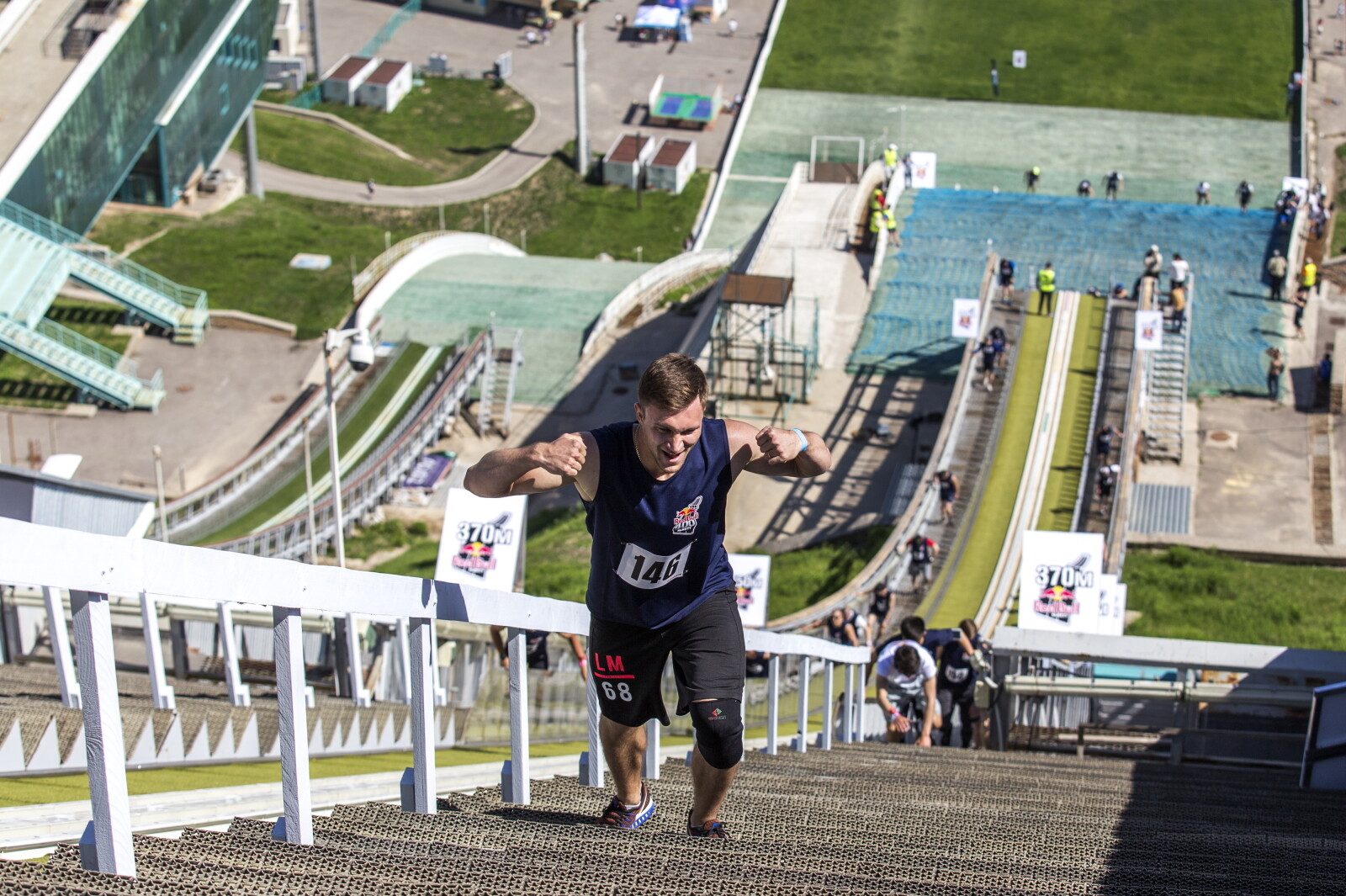
• It's hard to imagine a race being more demanding than the Red Bull 400. In order to achieve the fastest possible lung-busting dash up a ski jumping ramp, participants must complete it. The winner is the first to reach the pinnacle. There are 600 to 800 steps involved, and the farther you go up, the steeper it gets.
• Anyone who is physically healthy enough to run a 400-meter uphill sprint may participate in the Red Bull 400. Training for the calves and quads, in particular, is recommended before participating. Running up a ski jump, on the other hand, can only genuinely prepare you for the experience.
• In terms of the Red Bull 400, the numbers speak for themselves. A 40-story building's worth of elevation rise is required to complete the 400-meter course. In order to keep going, you'll need to get down on your hands and knees and work your way up to a 37-degree gradient. As a result, your heart rate can soar as high as 200 bpm, and your lactic acid buildup is 20 times more than normal.
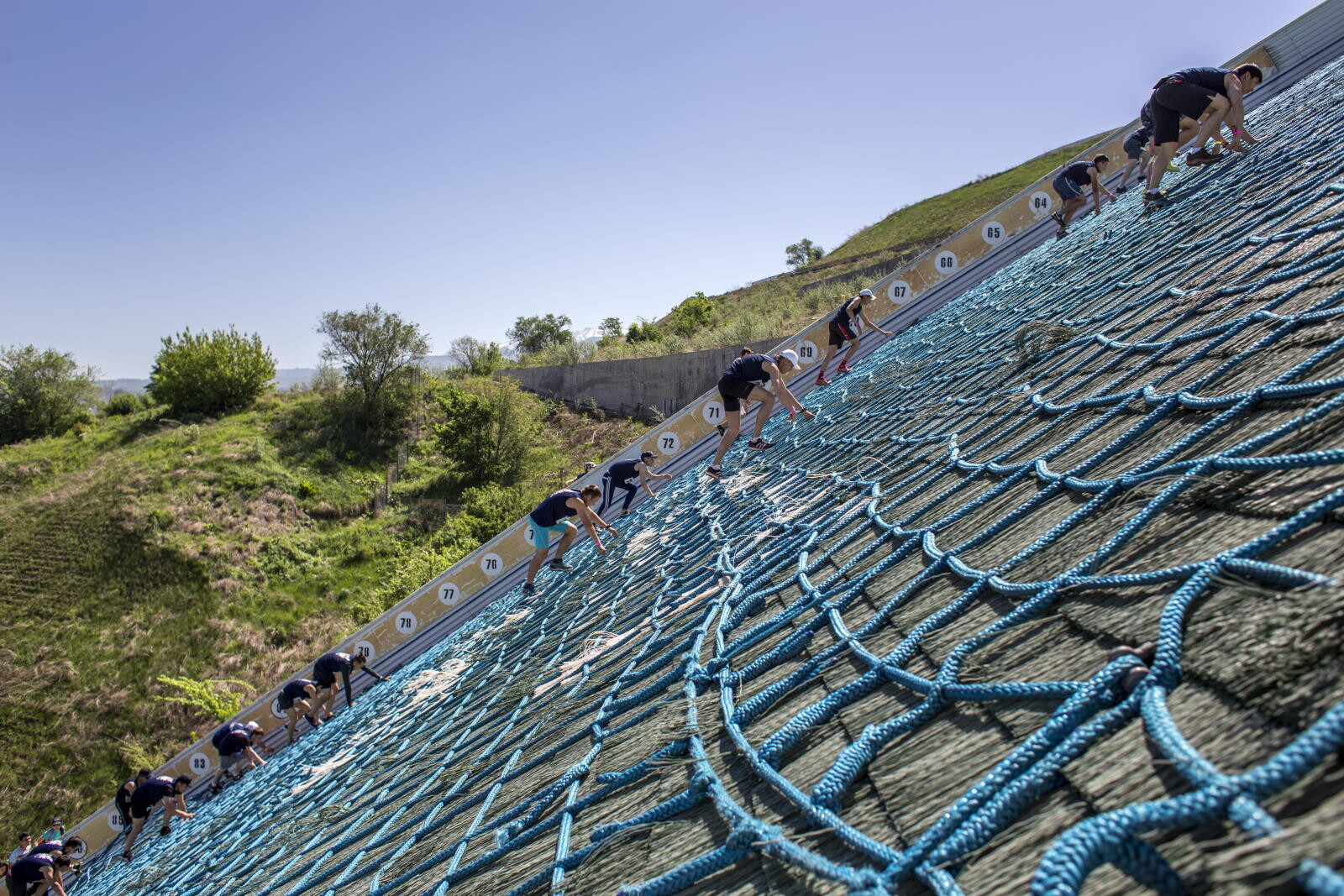
• It takes more than just energy to climb a hill; it also takes time. Changes in gravitational potential energy can occur over a short period of time or over an extended period. You'll see a different pace of energy change depending on the time period. Power is the rate at which energy changes.
• Whatever activity you participate in, it's imperative that you dress appropriately, but this is unlike any other race you've done before and necessitates a unique set of running clothes. Switch out your regular running shoes for trail shoes or even light hiking boots to get the most out of your workout. Gloves are also a good idea.
Athlete experience
After the ascent began, it was difficult to figure out the most efficient route to ascend the steep, grassy hill. In the beginning, I ran up the hill on my hands and feet, but soon after, I began crawling up the slope on my hands and knees as well. I found this to be far more efficient than relying just on my feet to get where I needed to go. Starting out too hard results in an early accident, and the track only gets steeper and more difficult as the race progresses.
Conclusion
The star of the Red Bull 400 has been identified. As the first male world champion, Ahmet Arslan has won 20 out of 23 Red Bull 400 races. During the Red Bull 400 event, there are steeper slopes than treadmills in the gym. You can complete it if you persevere through the pain in your quads and lungs. It is very difficult, but not unachievable on foot.
(06/15/2022) ⚡AMP
Estimate your mile time with this short speed workout
Have you ever wondered how fast you could run a mile? Many runners tend to bump up to longer distances before working on their speed, but training speed over shorter distances can translate well to longer distances, so it’s a great idea to test yourself on the track from time to time as well.
Knowing your mile time is essential for speed training, as it challenges your aerobic system. It also puts more stress on your mechanical system, since you’re running at a much faster pace than you would in a 5K or longer. This allows you to build the strength you need to maintain your form over longer distances.
Here is a workout to find your mile pace for speedwork and racing.
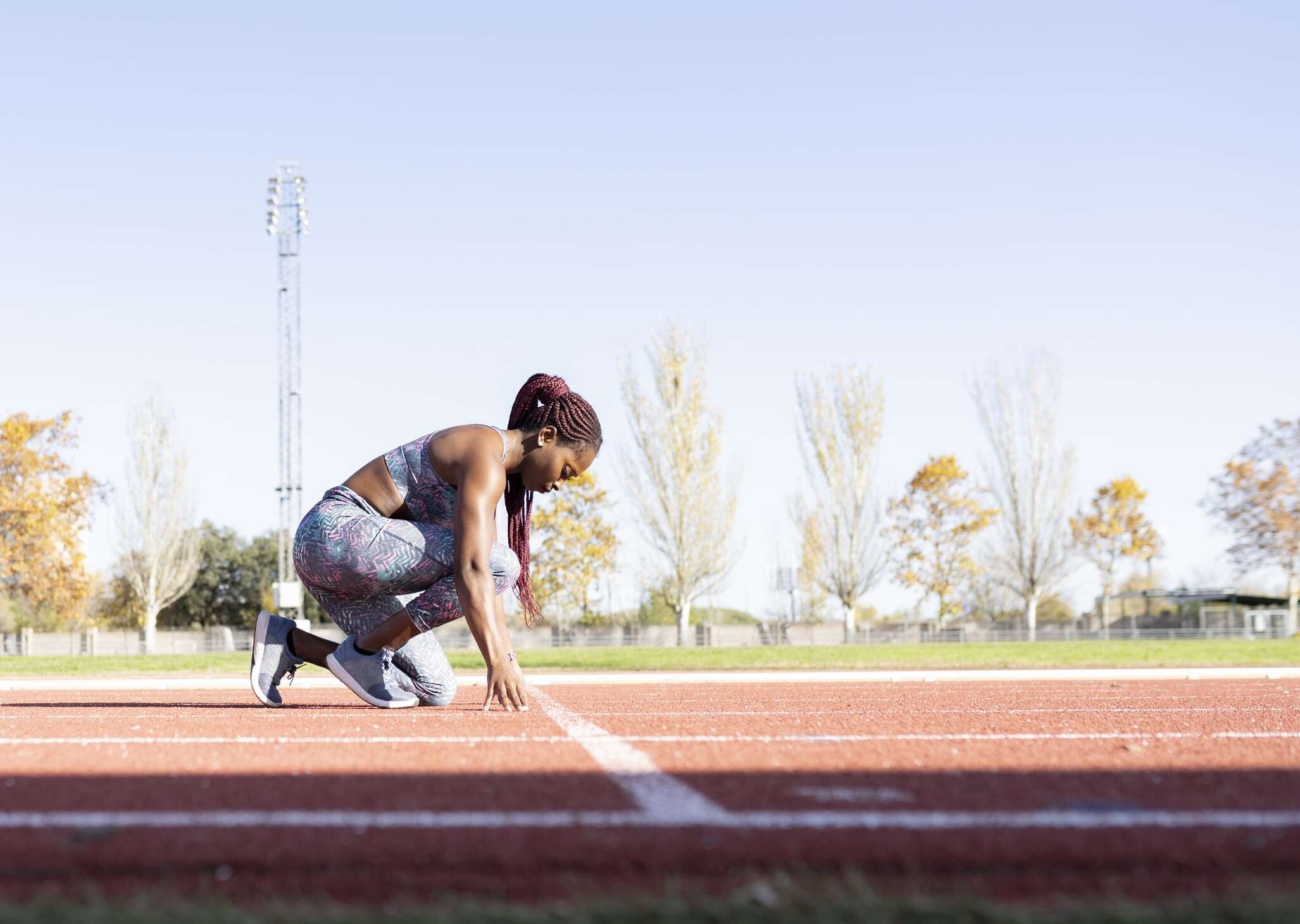
Workout:
Two reps of 800m with 30 seconds rest/400m with 30 seconds’ rest/400m, with 10 minutes’ rest between sets

Each rep should be done at a threshold pace, but not at all-out. If you are unsure what your threshold pace is, aim for 20 to 30 seconds per kilometre faster than your 5K pace.
For example: If you run a 25-minute 5K, the 800m rep should be done in 3:36 to 3:40, and the 400s should be done in 1:45 to 1:48.
You will find the 30 seconds’ rest will go by quickly. To keep yourself diligent, get ready to start the next rep after finishing the previous one. If you are doing the workout at a track, drop water at the 400m mark, so you’re able to get fluids into your body between reps.
Between sets, grab your water and walk a lap or two around the track to keep your heart rate up.
Keep track of your splits for each rep, and do the same for the second set. Add up all the times, then divide by two, which should give you an estimate of what you could run for a mile (give or take a few seconds).
Example: 3:36 + 1:45 + 1:45 = 426 seconds (a 7:06 mile)
The short rest will make this workout not the most pleasant, but one you can look back on with confidence and as a future reference.
(06/15/2022) ⚡AMPby Marley Dickinson
World Athletics launches Personal Best, a lifestyle channel for all runners
World Athletics has just launched Personal Best, an Instagram-based platform geared towards all runners, regardless of ability or passion.
The simple aim of Personal Best is to connect the global running community, getting more people to run more often.
Personal Best is dedicated to every runner, regardless of ability or passion. It will represent and connect runners from all over the world with the aim of building a diverse and relatable community and a supportive environment for everyone, for runners new and old.

Whether it’s a teammate, friend, family member or stranger, running brings people together. Personal Best will encourage and help everybody within the global running community to achieve their goals, however big or small.
The channel will share runner experiences from all walks of life, all over the world: the adventures, the challenges, the struggles, the communities and above all, the sheer joy of running.
(06/14/2022) ⚡AMPThree tips for more relaxed running, these simple tips will have you running with ease
We’ve all watched runners who seem to stride effortlessly even at top speeds, like Eliud Kipchoge, the GOAT of marathoning. Intentional practices, like the ones he uses, are not just for the pros. Try these simple tips to relax during your next run.
Mentally check your form
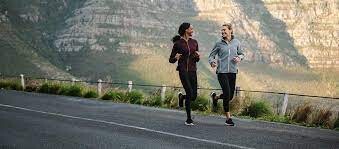
Make a practice of doing a body scan regularly during your training runs, checking your body for tension. Our form tends to start to fall apart when we tense up as we try to hit interval splits or get fatigued. Checking in both gives you a mental break from worrying about pace and can help you loosen up any tight spots. Starting with your head, run through key tension spots like your jaw, shoulders, and arms, and note where you feel any tightness or awkwardness. Check that your arms are swinging loosely. After a bit of practice, this will become a habit and you’ll find yourself naturally adjusting your runs for ease.
Relax your face (try smiling!)

Kipchoge is famous for smiling throughout his races. Research suggests that runners who smile while exercising improve their running economy, use less oxygen, and have a lower rate of perceived exertion. You may feel silly at first, but you’ll run more smoothly and maybe even manage to pull off that elusive great race photo. Try smiling at other people out exercising as you pass by.
Take a deep breath, shake it out, and reset
Whenever you note that you’ve accidentally tensed up, take a deep breath, release your shoulders, and give your arms a shake. Focus on your breath for a few moments, trying to breathe consistently rather than in short bursts, and from your belly. If you’re still finding that you’re consistently feeling tight and uncomfortable during runs, try incorporating a short (two minutes is enough) breathing practice before or after workouts, or just before bed, making your breaths full and long. Bonus: you’ll sleep better, which in turn will help you run with less effort.
(06/14/2022) ⚡AMPby Keeley Milne
The world's fastest man is once again putting on his football boots for a good cause
Usain Bolt is back to captain the Rest of the World XI against England in Soccer Aid.
The former Olympic sprinter is once again involved as skipper, having played in the past few matches. Fittingly, the match is taking place at London's Olympic Stadium - a football venue in its own right as the home of West Ham, but also the place where Bolt set the Olympic record on the way to defending his 100m crown in 2012.
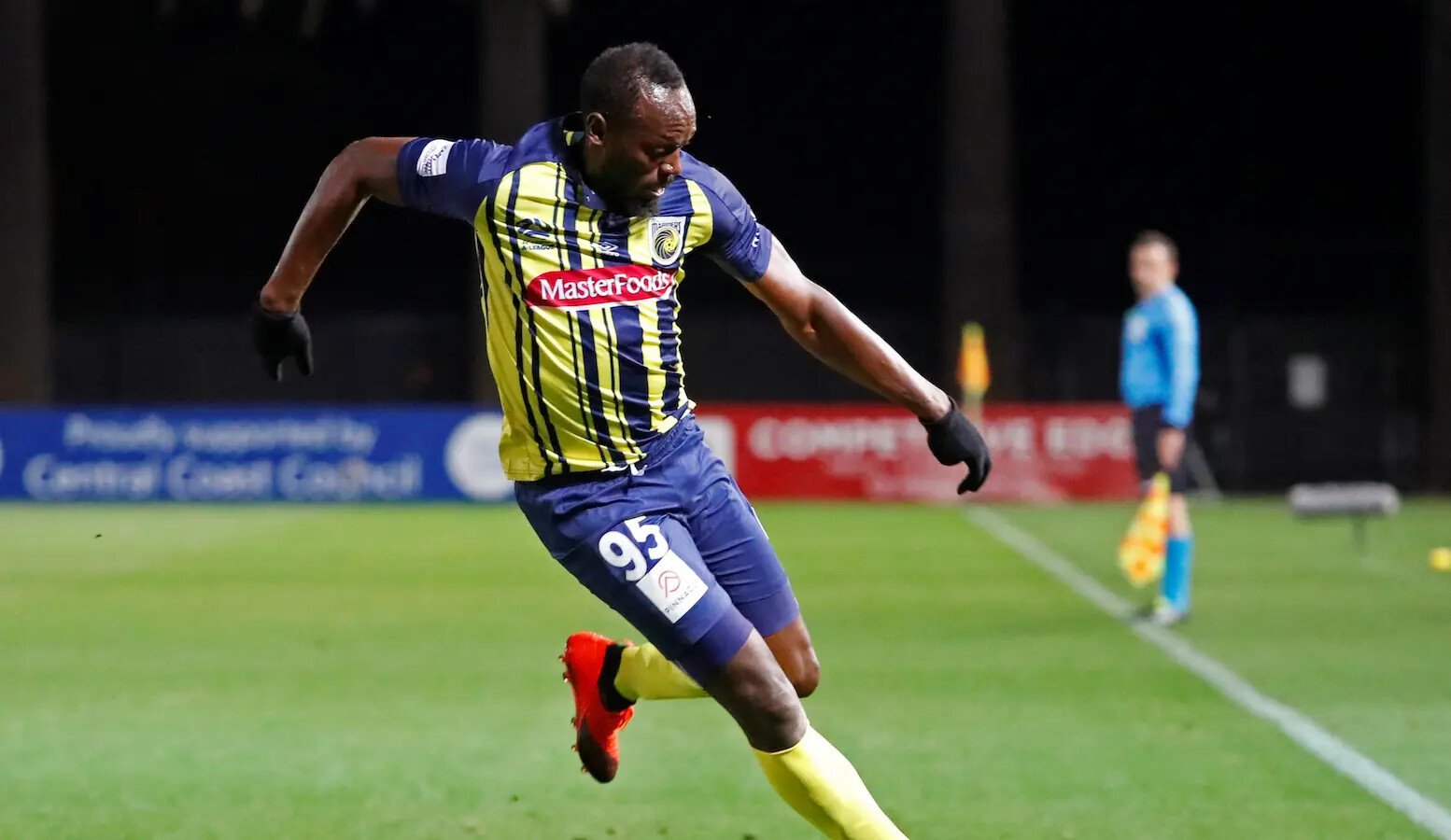
London 2012 was a highlight in a storied career that saw Bolt establish himself as the fastest man in the world and set records that have yet to be beat. The 9.63 seconds it took him to win gold in 2012 remains an Olympic record - beating the one he'd set in 2008 - but the overall world record was set by himself a few years before that.
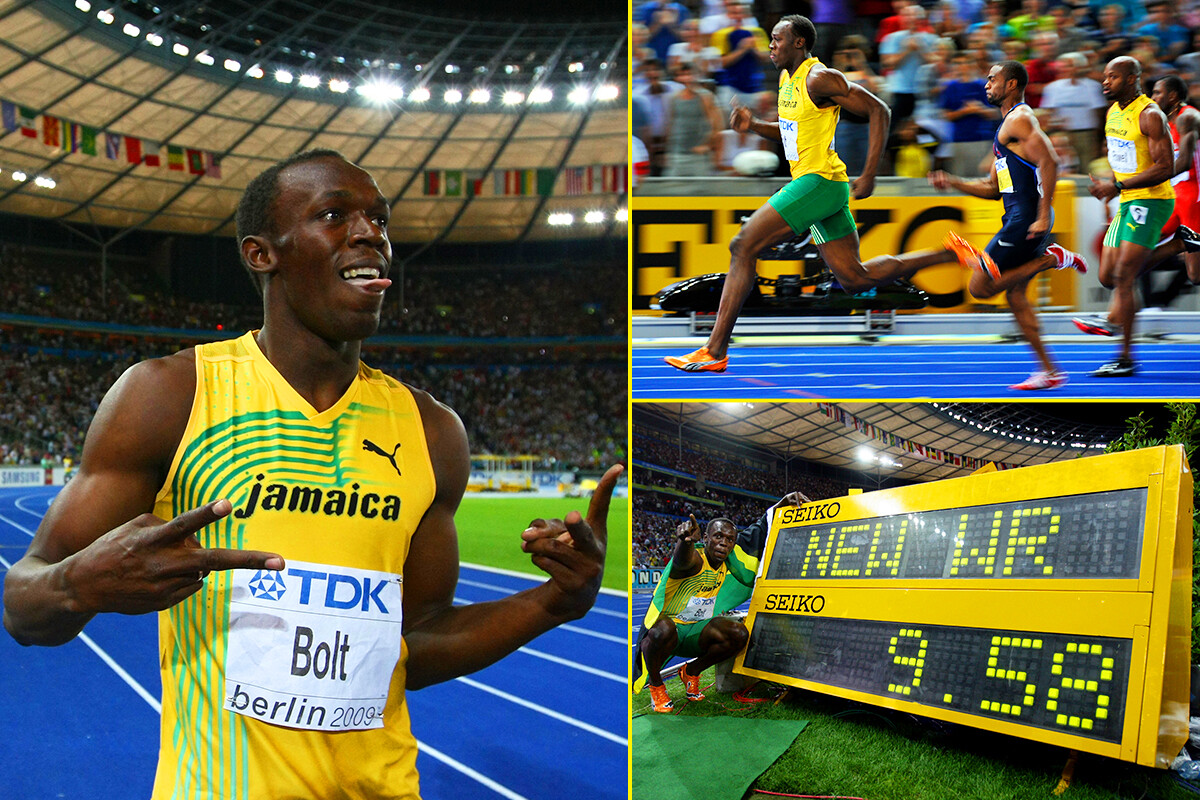
Bolt set the current 100m world record at the 2009 IAAF World Championships, clocking an incredible 9.58 seconds for the feat. His average ground speed was 37.58km/h (23.351 miles per hour), whilst reaching a top speed of 44.72km/h (27.788 miles per hour) in the 60-80m stretch – numbers fitting for the world’s fastest man.
He first held the 100m world record in 2008 at the Reebok Grand Prix in the Icahn Stadium in New York, clocking 9.72 seconds to beat fellow Jamaican Asafa Powell’s record of 9.74 seconds set at the IAAF Grand Prix in Rieti, Italy, a year before. He brought the record down further to 9.69 seconds at the 2008 Olympics in Beijing, before hitting his peak in 2009.
9.58 seconds remains the world record for the 100 metres and Bolt has commemorated that in past Soccer Aids by wearing the number - complete with decimal point - on the back of his shirt. For added measure, Bolt also holds the record for the 200 metres - running 19.19 seconds at the 2009 World Championships.
(06/13/2022) ⚡AMPThe Rome Diamond League did not disappoint, with several meet records shattered
The Rome Diamond League did not disappoint on Thursday afternoon. Several meet records were smashed, including Eliud Kipchoge’s 5,000m meet record of 12:46.53–by his compatriot, Nicholas Kimeli,who clocked a world-leading time of 12:46.33.
Kimeli’s time was the seventh-fastest ever over 5,000m, and only six seconds behind the Kenyan national record held by Daniel Komen at 12:39.74.

The 23-year-old Kenyan came into the race in great form, winning the TCS World 10K in Bengaluru, India, in mid-May in course record time and setting a Kenyan national record over 5K on the roads in April (12:55).
The men’s 5,000m was speedy from the start, with the pace set for 2:35/km at the front. Yomif Kejelcha of Ethiopia led the race until one lap to go, when Kimeli and his Kenyan compatriot, Jacob Krop, took over the race with 300m to go. Krop and Kimeli battled over the final 200m until Kimeli put a gap on Krop with less than 100m to go, setting a new personal best, meet record and world lead over 5,000m. Krop finished second in a personal best time of 12:46.79, while Canada’s Mohammed Ahmed (second photo) ran a season’s best time of 12:55.88 to finish fifth.
In the women’s 800m, Athing Mu made a statement, winning the race in a world-leading time of 1:57.01. Mu sat on the heels of the pacer for the first 400m, coming around in 56-high. Once the pacer fell off, the 20-year-old American phenom took over, winning the race by almost two seconds.
(06/13/2022) ⚡AMP
by Running Magazine
Delayed Onset Muscle Soreness: A Runner’s Friend or Foe?
Recovery from meniscal injuries can take between 4 – 24 weeks if you start effective treatment early and you manage it well.
Minor to moderate meniscal tears, both acute (from traumatic injuries) and degenerative (from wear and tear), can heal with conservative treatment.

The more severe your symptoms and having other injuries like anterior cruciate ligament injuries with your meniscal tear, will increase your healing time.
What are the treatment options for a meniscal tear?
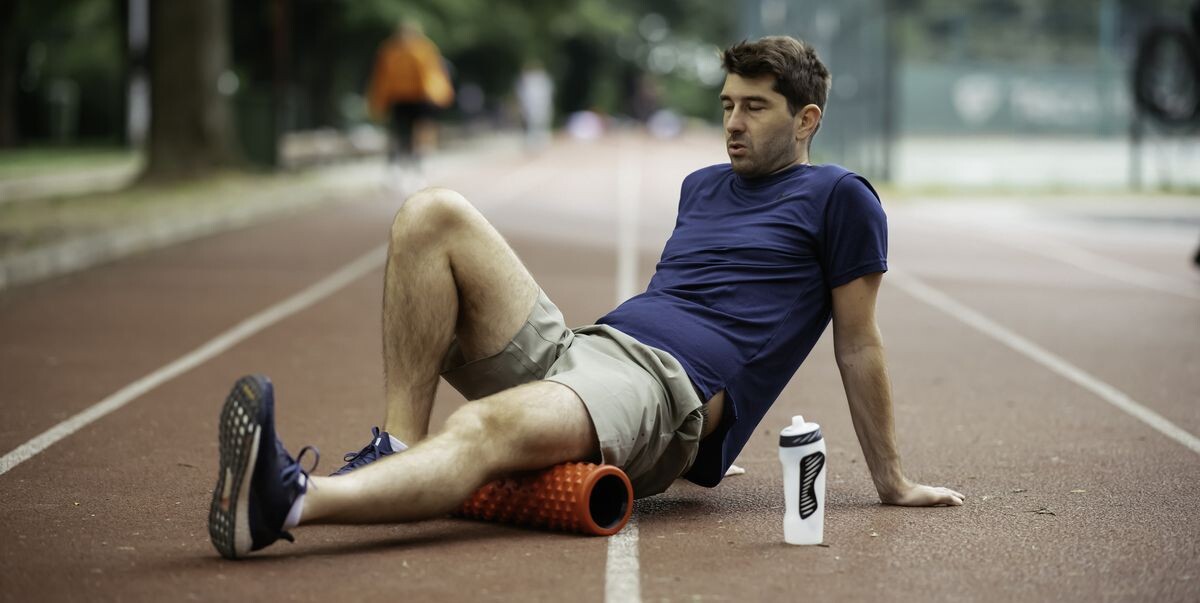
A conservative rehabilitation program for your knee that includes rest, ice, medication and a structured exercise program is often enough to heal a meniscal tear on its own.
If conservative treatment doesn’t improve your symptoms within three months, your tear may require surgical treatment.
Do all meniscal tears require surgery?
No, treatment of a meniscal tear depends on:
Symptoms
Age
Activity levels
Location and type
Age, symptoms, activity levels
Meniscal tears may cause mild to severe symptoms at first. For people over 40 years old, once the initial injury settles down, if your symptoms don’t interfere with daily activities, surgery is not recommended. Non-surgical treatment is preferred.
The younger you are, the less wear and tear there is in your knee joints, and the better your body heals from surgery. Surgery is a valid option if you’re young, have no other ligament injuries and your meniscal tear is from an acute injury.
Many of you have experienced extreme muscle soreness after pushing the pace during a race, running intervals or hills or trying a new weight lifting program. This painful condition is called Delayed Onset Muscle Soreness or DOMS.
The onset of DOMS after exercise is usually within 24 to 72 hours of completing a workout. Symptoms of DOMS include extreme muscle soreness and tenderness, mild swelling of muscle tissue and restricted range of motion.
What causes delayed onset muscle soreness?
While the research has not been conclusive on the causes of DOMS, there are two common theories. The first is based on an understanding of what delayed onset muscle soreness is — an accumulation of the lactic acid produced during exercise, which causes muscle pain. Lactic acid is a by-product of our cells that can exceed normal levels with strenuous exercise and create a painful acidic environment.
Most physiological studies do not support the lactic acid theory, however. This is because, after exercise, most of the excess lactic acid is flushed from your system within 30 minutes. Hence lactic acid should not cause muscle soreness one to two days after exercise. Additionally, similar blood levels of lactic acid in cyclists and swimmers do not produce the same symptoms that runners experience, further debunking the theory that lactic acid causes DOMS.
The more widely accepted cause for the symptoms of DOMS is that the muscle pain is due to extreme trauma to our muscle tissues. Running, at its essence, is controlled falling. We use our muscles to decelerate our joints as they absorb impact.
These types of muscular contractions are called eccentric contractions. Eccentric muscle contractions are performed with weight-bearing activities (walking, running, weightlifting). As the muscle fibers slow down and control the rapid deceleration of a runner’s body weight (especially with a new or harder than normal workout), they tear.
About 24 hours after the bout of exercise, the effects of inflammation appear as pain, swelling and stiffness. The inflammatory process basically cleans up damaged tissue and repairs and/or produces new tissue. The pain is caused by inflammatory enzymes and chemical by-products that sensitize pain receptors and cause cellular swelling. The cellular swelling can be extremely painful and can last about 72 hours.
The new muscle fibers that are produced are usually more adaptable to the stress and strain of running. In other words, it is out with the bad and in with the better. This is not news to many experienced runners. Tough runs and workouts make us stronger. So, for those who ask the question, “Is DOMS good?” the simple answer is yes, it can be.
Running, at its essence, is controlled falling. We use our muscles to decelerate our joints as they absorb impact.
Understanding DOMS: the role inflammation plays
Traditionally, inflammation has a bad reputation. Nonsteroidal anti-inflammatories (NSAIDS) are common medications used by runners to reduce post-run inflammation and pain. Some runners will even take NSAIDS prior to a run to prevent inflammation. However, studies have shown that not only are NSAIDS tough on your stomach and kidneys, but they also impair the normal healing process.
So, while popping an NSAID might give you temporary relief from the pain of DOMS, it is likely leading to weaker muscle fiber formation. In fact, it could be argued that controlled inflammation is a runner’s best friend. After an abnormally long or hard run, the body has a short window of time to take advantage of the inflammatory cycle’s process of muscle fiber rebuilding and remodeling. Rather than popping a pill to soothe sore muscles after exercise, consider a natural, proactive approach to relief and recovery.
DOMS recovery: how to get relief for sore muscles
Try these practices to optimize your body’s potential while your body recovers:
Ice Bath:
Soaking from the hips down in a cold stream, lake or in a tub full of ice for 15-20 minutes within 30 minutes of your run reduces the painful cellular swelling produced by inflammation without affecting the healing components of the inflammatory cycle. I have found that getting in the tub first and then adding the ice is the least painful method.
Active Rest:
Move! If you sit around during the healing process the remodeled muscle tissue will be stiff and shortened which over time leads to postural imbalance and injury. For example, prolonged sitting can result in tight hamstrings which could lead to a hamstring strain when you try to go for your first post-DOMS run. Walking, yoga class, cycling, elliptical trainer and pool running are all good options for exercise while recovering from DOMS. Try the Downward Dog stretch to address tightness in the hamstring, hip and calf muscles. See Fig.1 for instructions on this common yoga technique.
Stretching Lightly:
Stretching during the 24-72 period of DOMS is very different from normal stretching. The healing muscle fibers are very delicate. You do not want to overstretch and tear previously damaged muscle fibers. Take your stretches just to the threshold of discomfort and then back off a bit. Hold for up to 60 seconds. See Fig. 2-3 for instructions on how to stretch the quadriceps and hip flexor muscles.
Massage:
Seeing a massage therapist for a gentle massage, or utilizing self-massage using a foam roller, helps increase blood flow and flexibility of healing tissues. Avoid deep tissue massage for at least a week after the onset of DOMS to avoid further traumatizing healing muscles. See Fig. 4 for directions on using a foam roller on the outer leg and hip muscles.
The benefits of Delayed Onset Muscle Soreness
As a physical therapist, I work with patients to improve their strength and flexibility through various treatment approaches and prescribed exercise. am constantly trying to make changes to patients’ bodies by prescribing exercises to improve flexibility and strength. During the short period of DOMS, the body is primed for making these types of changes in a relatively short time.
I have described running as a sport that causes countless tissue tears and profound inflammation. So why should we run? Why would I recommend such a traumatic activity that can lead to such extreme muscle soreness?
Weekly, I have patients ask me if running is bad for them. Often, someone has told them not to run because it is too hard on their body. Knowing what causes DOMS, and that running is one type of workout that can lead to the condition, prompts people to question their decision to run. However, the human body is designed to adapt and grow stronger to the stresses we put on it. If we do not stress our tissues, they weaken and become prone to disease and injury.
So, I ask, “Why wouldn’t you run?”
(06/13/2022) ⚡AMPby Therapeutic Associates
Highlights from the 2022 Cheese Rolling Championships
After a two-year hiatus due to the pandemic, the Cooper’s Hill Cheese Rolling race was back in Gloucestershire, U.K. on Sunday morning. If you missed the highlights from the Super Bowl of downhill sprinting, we have you covered.
The event has been held on Cooper’s Hill since 1826. It involves competitors chasing a four-kilogram round of double Gloucester cheese down a 200m hill. The rolling cheese reaches speeds of 100 kilometres per hour. The first person to make it down the hill wins the huge piece of cheese.

Members of the local rugby team wait at the bottom as “catchers” to help slow people down. Emergency medical workers are nearby in case of serious injuries, which there are many.

This year, there were three races, a men’s race, a women’s race, and a safe children’s race, which is an uphill run. Wet weather made the conditions slippery underfoot as many tripped and tumbled downhill.
The women’s race
The race was won by first-timer, Abby Lampey, who travelled to Gloucestershire from North Carolina to take part in the festivities. Lampey can be seen in the video above, throwing herself down the hill from the start.
The men’s race
The renowned cheese chasing champion, Chris Anderson, 34, won his 23rd cheese race in 15 years in what he said was his final event since becoming a dad during the pandemic.
Anderson has suffered numerous injuries in the name of cheese domination over the years, including bruised kidneys, a concussion and a broken ankle. It was he who set the tone for the competition at his first race when he fell while running and found that purposeful falling was a more reliable way to win than running.
(06/12/2022) ⚡AMPby Running magazine
Ultrarunners stranded in Birdsville, Australia after river floods
Dozens of ultramarathon runners have been stranded in the Australian township of Birdsville, Queensland after the Diamantina River flooded road access to the area. The runners were participating in the Simpson Desert Ultra, an annual multi-distance ultra event.
Prior to race start, race directors issued an announcement that the river had reached a high point, and they anticipated the river dropping over the next few days. Runners entering Birdsville for the start of the race had to wade through floodwaters, helped by local police.

While the race was a success, the river continued to rise, and runners now find themselves stranded in Birdsville. They have few options aside from waiting for the Diamintina river to abate.
Birdsville has flooded numerous times in the past. Race officials provided reassurance regarding contingency measures to gain access prior to the race in their statement:
“We anticipate the river height will drop over the next couple of days. As a community we have a long list of contingencies in place if it doesn’t drop fast enough to allow vehicles access by mid week; these include planes, boats and a tow truck.”
Races camp spots between #Birdsville and the #DiamantinaRiver now underwater from flooding. #flashbackto2016 pic.twitter.com/KBBO253VvH
— Birdsville Races (@birdsvilleraces) April 6, 2018
(06/12/2022) ⚡AMPby Running Magazine
Can a Pair of Running Shorts Be Worth $200?
If within your first minute on the Satisfy product page you don’t do take a second look at the prices, kudos. You’re a less judgmental (or far wealthier) person than me.
“Who are these people?!” was my main thought the first few times I surveyed the site. My question was two-fold. First, who are the people paying $236 for a pair of trail shorts, or $215 for a tie dye short-sleeve shirt, or $322 for a pair of tights, or $65 for a bandana, or…you get the idea. Second, who are the people making this 70s-fonts-meet-space-age-fabrics gear splattered with phrases like “running cult member” and “run away?”

“I’m not obsessed with fashion,” Partouche says. “I’m obsessed with great products with a function.” Design, he says, “is always about solving problems—I want to run in the desert, I want to run in the mountains, what do I need? So we start with that story and we develop the product around the story.” Then, he continues, “we add cultural value, references that create a connection with the product, like a print, a tie dye, hand feel. It’s a balance of functionality and design. I like this image of a mix table, trying to push both knobs to the max without exploding the speaker. It’s a very romantic approach.” Indeed it is: “I want to squeeze in a few miles around the neighborhood before work” doesn’t strike quite the same chord.
Partouche’s vision of “cultural value” is both quite precise and hard to capture in a few words.
“My perception was not the spandex runner, it was running in the [19]60s, 70s,” he says. “No one else was really embracing this style of look and running. For me, running is like skateboarding. It’s a sport for rebels. I like this idea of bringing back running to its core values.”
Visually, think short shorts, bandanas, retro graphics, and occasional purposefully distressed tops. The latter come via Satisfy’s MothTech process, which incorporates small holes for ventilation. (Runner’s World did a collaboration with Satisfy last fall that incorporated a 70s-era version of the magazine’s name on MothTech tops.) A boxy, cold-weather top with elbow patches and a slight turtleneck I tested is unlikely to be mistaken for, say, Under Armour apparel. (My wife calls it my cosmonaut top.) Tops and bottoms come with the care tag on the outside of the garment, to eliminate the possibility of chafing. The tags can be detached, leaving a thin remainder strip visible on the front.
I shared the Satisfy site with a running friend who has taught design. They responded with a list of phrases like “if running clothes were a trucker hat” and “engineered authenticity.” They also wrote, “This branding strikes me as a winking parody of indifference, offering a uniform anyone can purchase that’s designed to look like you give no shits about fashion when training and you are a serious macho runner like the runners back in the day—but a big dumb logo patch that signals to your peers in the know that this is actually a running lifestyle brand.”
About those prices
Partouche says Satisfy’s potentially eye-popping prices can be explained by the company’s approach to fabrics and production. The brand’s technical fabrics might cost 20 euros per meter. “You can find some big brand shorts for [this price],” he says. “This is only for us the price of the fabric,” which he claims can be 20 times more expensive per meter than what’s used to make Nike shorts. “That’s why you can’t compare—it’s just not the same product,” Partouche says. When it doesn’t use technical fabrics, Satisfy uses natural ones such as merino wool and organic cotton, and recycled fabrics.
Gear made of fabrics sourced in Europe are also produced in Europe. “Seventy to 80 percent of our products are produced in Portugal, under very fair [labor] conditions,” Partouche says. “That’s one big difference.” The merino that Satisfy uses is woven in Japan, and then the gear is produced there to lessen its environmental impact.
Partouche says the brand’s approach to product lines is also inspired by good environmental practices. There’s an evergreen line that’s always in stock, and there are occasional drops, produced in limited quantities (about 20 percent of a typical evergreen production run). “The idea here it to sell out the drops and not overproduce,” Partouche says. “We don’t have this putting-products-on-sale approach, which makes the brand more sustainable.”
I told Partouche that I and many other runners are on board with paying more for high-quality gear that’s produced ethically and sustainably, but that I saw nothing on the Satisfy site that gives context to the prices.
“This is the most challenging part now, to explain better what we do,” he responded. “We are 70 percent online. When you go to a store and touch the fabric, you can understand. On the website, if you just see a black T-shirt, it’s hard to understand.”
One runner’s reaction
I also told Partouche that the Satisfy apparel I ran in was some of the best gear I’ve encountered since taking up running in 1979. And I meant it. The cosmonaut top ($201) was warm enough as a single layer down to about 20 degrees, yet also comfortable into the mid 40s. Its boxiness easily accommodated underlayers, but I never felt constrained when doing faster runs in it. The tights ($159) I tested were even better. They, too, worked for a surprisingly large temperature range, and were just the right mix of sleekness and give.
Of course, $200 tops and $160 tights better be excellent! Are they worth that much?
That depends on what you mean by “worth.” Anyone fortunate enough to have disposable income devotes some of that money to things others never would. I can’t believe how much my sisters spend on Major League Baseball tickets and Disney vacations. They would probably scoff at what I pay for a pound of coffee beans.
To continue the coffee analogy: It’s worth it to me to spend $20 for a pound of fair trade, organic, single-origin beans rather than $10 for a blend from Dunkin’. Beans that are $30 or more per pound are a different matter. I know the beans will be even better than what I usually buy, but not that much better. Maybe I’ll buy them as a gift or vacation splurge once or twice a year.
That’s where I’ve landed on Satisfy gear. Their merino wool socks are probably the most comfortable, best-functioning socks I’ve ever run in. Still, they cost $53 a pair. I can buy a pair of Darn Tough socks—also merino, also manufactured responsibly, and with a lifetime warranty—for around $25. For me, spending twice as much to get gear that’s perhaps 12 percent better isn’t worth it. I’m also not someone who likes slogans or big brand names on his clothes.
But that’s just me. Satisfy has an incredibly devoted Instagram following, and has now been in business long enough to counter kneejerk they’ll-never-make-it predictions.
“Our approach to product design and craft is simply different from the rest, and I think that’s what makes us stand out,” Partouche says. “Today, our challenge is getting our product in people’s hands, because I’m convinced that when someone feels the textures of our fabric technologies, sees all the details that we inject into our design, they understand why we’re priced at where we are.”
I mean, I know I’m just a middle-aged guy sitting at home in Maine. But is there really a massive Venn diagram overlap of adventure runner, disposable income, and punk/chillbro/psychedelic/hippie aesthetic? Did I miss where, per the Satisfy site, the best way to explain the recovery portion of a track workout is, “really take advantage of the 60 sec rest to get SO chill until the next rep”? I decided to find out.
Executive summary: The clothes are excellent, the prices aren’t necessarily outrageous once you consider all the factors, the brand’s founder is a passionate runner with an admirable DIY streak, and running is big enough to accommodate many approaches.
But I doubt I’ll ever buy a piece of Satisfy gear.
Birth of a brand
Satisfy is inseparable from its founder, Brice Partouche. Now 45, Partouche started running in his mid-30s and was immediately hooked. “I got high when I ran,” he says. “I was lucky enough to experience this at an early stage, which is why I kept going back to it.” His love for the life-changing magic of lacing up is palpable. He says things like, “I found running in my mid-30s, or running found me” and, “This is a dream of the brand—everyone should experience the high.”
What Partouche didn’t like about running was the clothing. “Most of the brands, the products are kind of cheap,” he says. “To me, the hand feel, the touch of the fabric is important.” He was also dissatisfied with the functionality of things like key pockets and phone storage in the gear he ran in; the distractions interrupted his sense of flow.
As a teen skateboarder, Partouche started a T-shirt brand. He later dropped out of medical school and founded a denim brand. A drummer, Partouche grew up listening to and playing punk rock. “These activities have a huge cultural value attached to them,” he says. “When I jumped into running, I couldn’t find any brand that supported this idea of running alone and running away from things.” Drawing on skateboarding’s and punk’s ethos, Partouche says, “If it doesn’t exist, you just do it yourself. I wanted to create product that will allow the high. I really believe that part of this could be achieved with the product you’re wearing.”
He spent several months developing prototypes. The first sales occurred in 2016. Headquartered in Paris, Satisfy now has 17 staff members. According to Partouche, North America makes up half of his market. (“France is 1 percent of the business,” he says a little ruefully.) Sales are almost entirely online, although you can find Satisfy gear in a few U.S. running shops like Renegade Running in Oakland, California, and The Loop in Austin, Texas. Partouche calls these “contemporary, new running stores with an experience.”
(06/11/2022) ⚡AMPby Runner’s World
Olympic marathon champion Peres Jepchirchir said she could target the London, Berlin or Chicago marathons for a world record attempt next year
The 28-year-old Kenyan set the sport ablaze when she won the New York City Marathon just 13 weeks after claiming gold in Tokyo, the first athlete to win the Olympic marathon and the five-borough race in the same year.
She picked up her second major title five months later in Boston in a thrilling sprint finish, confirming her among the most dominant marathon runners of all time.
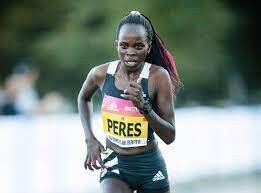
Jepchirchir, who wants to be the first woman to successfully defend her Olympic title in 2024, said she has even loftier goals in mind.
“I still have a mission to go – I still need to run to attempt records in marathon,” she told Reuters on Friday, a day ahead of competing in the 50th running of the New York Mini 10K.
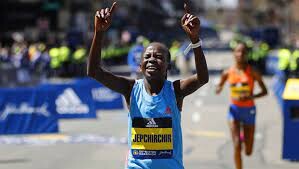
“London is a faster course, even Berlin, Chicago is a faster course… Those are the races that maybe I can attempt.”
Jepchirchir produced the fifth all-time fastest marathon by a woman in December 2020, winning the Valencia Marathon in 2:17:16, and believes she’s “not far” from breaking compatriot Brigid Kosgei’s record 2:14.04 set in 2019.
“I’m feeling good – I’m so glad, I’m so happy for my improvement in my career,” she said.
(06/11/2022) ⚡AMPby Pritha Sarkar
Porta-potties stolen at New Zealand marathon
On June 5, thousands of dollars in porta-potties were stolen from the inaugural Selwyn Marathon held in Christchurch, New Zealand. The race organizers reported several portable toilet rentals were stolen off the course after the race took place.
According to the local paper Star News, the toilets were all accounted for on the course during the race and seemed to be stolen after the race concluded. “Hosting races costs thousands and thousands of dollars,” says race director John Moore. “When you have to turn around and pay thousands of dollars for stolen equipment, it’s ridiculous.”

The grey porta-potties were stolen off Old Tai Tapu Road, located off the Akaroa Highway, just outside Christchurch. Race organizers have not located the porta-potties or any suspects.
“It’s straight-up theft,” Moore said to Star News. “Whether it is a contractor who wants a toilet in their yard or thinks oh they won’t miss it or think its a joke, but it’s not a joke.”
The marathon course was run on a two-loop course of 21.1 km, starting and finishing at the Selwyn Events Centre.
The portable toilets weren’t the only things stolen; four 30 km to 50 km speed signs, four stopsign paddles, as well as numerous kilometre markers and traffic cones also went missing. The total value of the missing gear reported to police is about $4,000.
(06/11/2022) ⚡AMPby Running Magazine
Strava Is Now More Trail Friendly. Here's How They Did It.
This week, Strava, the world's leading social platform for athletes sharing data and experiences, announced they will be adding 3D maps of completed activities, "Trail Run" as one of several new activity options, and other exciting updates that benefit dirt-loving mountain types.
Long overdue, right? We're so excited.
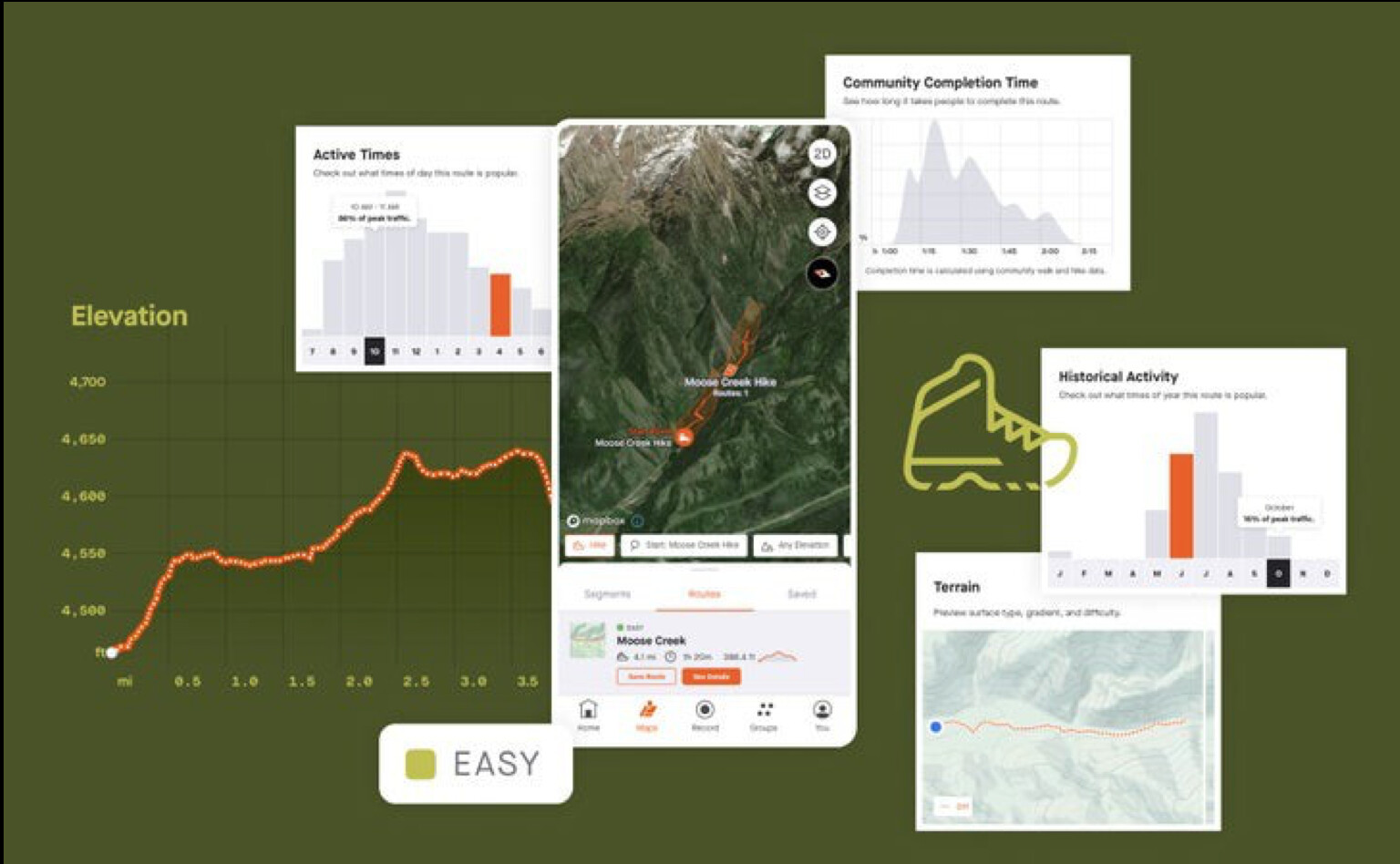
Strava announced new off-road interfaces to support "high-growth trail sports," which include trail running, mountain biking, and hiking, activities that are growing twice as fast as other Strava activities like road running and cycling.
"We have been seeing off-the-charts growth of trail sports over the past several years, outpacing even growth of road running and riding," said Michael Horvath, CEO and co-founder of Strava.
"Our teams are thrilled to be meeting athletes where they are with this release to fuel their joy of exploration." In addition to Trail Run as an Activity option, you will also now see other dirt-loving sports like Gravel Ride, Mountain Bike, and e-Mountain Bike.
Another development specifically geared toward trail and mountain runners is Strava's new offering of Trail Routes, which will highlight activity-specific trail networks and trailheads, with varying distances and elevations. Nuanced details for the routes will include difficulty ratings, Community Completion Times, and historical trends for best times of the year and time of day to run a specific route. Routes will now be available to download for offline use, too. And finally, for subscribers, Strava has introduced 3D maps for a more textured activity log.
With Strava's growth-7 billion activity uploads since its founding in 2009, 2.5 billion in the last 18 months-all of these upgrades offer a significant boost to trail-loving athletes everywhere as we seek to better explore, share activities, minimize trail impact, and build community.
(06/11/2022) ⚡AMPby Trail Runner Magazine
Runner's Guide To Vitamin D
It's is easy to assume you get enough vitamin D naturally-you eat chocolate ice cream like a champ and frolic in the mountains, spending significant time in the sunshine. But then a routine blood test shows you have low vitamin D.
You turn to Google and realize Rocky Road has zero percent of the recommended daily value of vitamin D. And dermatologist-approved sun protection like long-sleeved shirts and SPF-50 sunscreen limits your chance of absorbing it from sun exposure.

It's not unimportant. Research shows that vitamin D deficiency plays a role in stress injuries, and may contribute to decreased performance and impaired immune function.
The Science of Vitamin D
Vitamin D is a fat-soluble vitamin that can be obtained from food, supplements and sun exposure. The liver and kidneys help convert the vitamin to its active form, which is most known for its regulation of calcium and promotion of bone mineralization. However, vitamin D also influences cell growth and neuromuscular and immune function. It could even have some influence on cancer rates.
Medical experts differ in their recommendations for adequate vitamin D levels. The U.S. Endocrine Society considers insufficiency to be a blood level less than 30 ng/mL, while many sports-medicine doctors recommend that athletes have levels above 50 ng/mL. If you are concerned about your vitamin D level, ask your doctor to perform a blood test.
So how can Vitamin D aid in our running success?Bone Strength
As trail runners, we demand a lot from our bones. On a downhill, impact forces can increase by over 50 percent. Multiply that by the many miles of a long training run or race and you can understand the stress facing our feet, shins and femurs.
Several scientific studies have linked sub-par vitamin D levels and bone-stress injuries. One study published by the American College of Foot and Ankle Surgeons followed 53 patients with stress fractures from 2011 through 2014 and found that 83 percent of these patients had vitamin D levels below 40 ng/mL and 53 percent had levels below 30 ng/mL.
Athletic Performance
We all strive to run faster (or to have better adventures). Vitamin D could play a role in improving performance, though its adventure-boosting power is subject to debate. While vitamin D deficiency can cause muscle weakness and pain, experts in the field continue to debate the role of supplementation and athletic performance in individuals with levels greater than 30 ng/mL.Immune Function
While a well-timed snot rocket can be a source of laughs on a group training run, it is best when your runny nose is less active than your running legs. Several studies have found a link between vitamin D deficiency and autoimmune disorders such as multiple sclerosis, but the association between the vitamin and upper-respiratory infections is still equivocal.
The bottom line? Vitamin D clearly prevents bone-stress injuries. According to some debated studies (and anecdotes from runners), it could influence direct aspects of athletic performance as well. Trail runners should focus on a lifestyle that promotes healthy vitamin D levels for strong bones. And, if experts reach a consensus on the other benefits, it will be a nice bonus.
The recommended dietary allowance set by the Institute of Medicine (IOM) for vitamin D is 600 IU (15 micrograms) per day for individuals younger than 70 years old and 800 IU (20 micrograms) per day for individuals 70 and older. There is evidence that 600 to 800 IU per day may not be sufficient for optimal bone health in the athlete population. Some experts recommend that athletes obtain 2,000 to 5,000 IU a day from all vitamin D sources.
The IOM states that the upper limit of vitamin D intake is 4,000 IU (100 micrograms) per day, while the Endocrine Society states that the upper limit is 10,000 IU (250 micrograms) per day.
Chocolate Milk and Other Food Sources
There are very few food sources that contain natural vitamin D. Fatty fish such as salmon, swordfish, trout and mackerel contain it, as do egg yolks and mushrooms. Those on a budget may want to consider canned tuna.
In the American diet, the largest source of vitamin D comes from fortified foods like milk (including soy and almond milk), orange juice and many breakfast cereals.
Sun Exposure
Exposing your skin to the sun's UVB rays is considered one of the best ways to obtain natural vitamin D. It is generally agreed that 15 minutes of direct sun exposure for lighter-skinned individuals and 30 minutes for darker-skinned individuals can produce 1,000 IU of vitamin D.
However, several variables influence the amount of UVB rays that reach our skin, including the season, time of day, cloud cover and location.
Supplements
Vitamin D supplements come in two forms, vitamin D2 (ergocalciferol) and vitamin D3 (cholecalciferol). Research has shown that D3 is the more potent form and is better absorbed and utilized than D2. Supplements come in a variety of forms, including pills, liquid drops and chocolate chews.
Use caution with supplements, as vitamin D toxicity can cause decreased appetite, nausea, vomiting and frequent urination.
(06/11/2022) ⚡AMPby Trail Runner Magazine
2022 Lewa Safari Marathon to be held June 25
After running virtually in the last two years, the 2022 Lewa Safari Marathon will be held physically at the expansive Lewa Wildlife Conservancy June 25.
The Lewa Wildlife Conservancy, Tusk, Safaricom PLC and Huawei Technologies (Kenya) Co Ltd. announced on Tuesday during the launch.
For 23 years, the marathon held on Lewa Wildlife Conservancy, a UNESCO world heritage site and co-organised by wildlife conservation charity Tusk, has allowed participants from all over the globe to compete in an internationally acclaimed annual event whilst running through one of Africa’s most breath-taking wildlife conservancies.
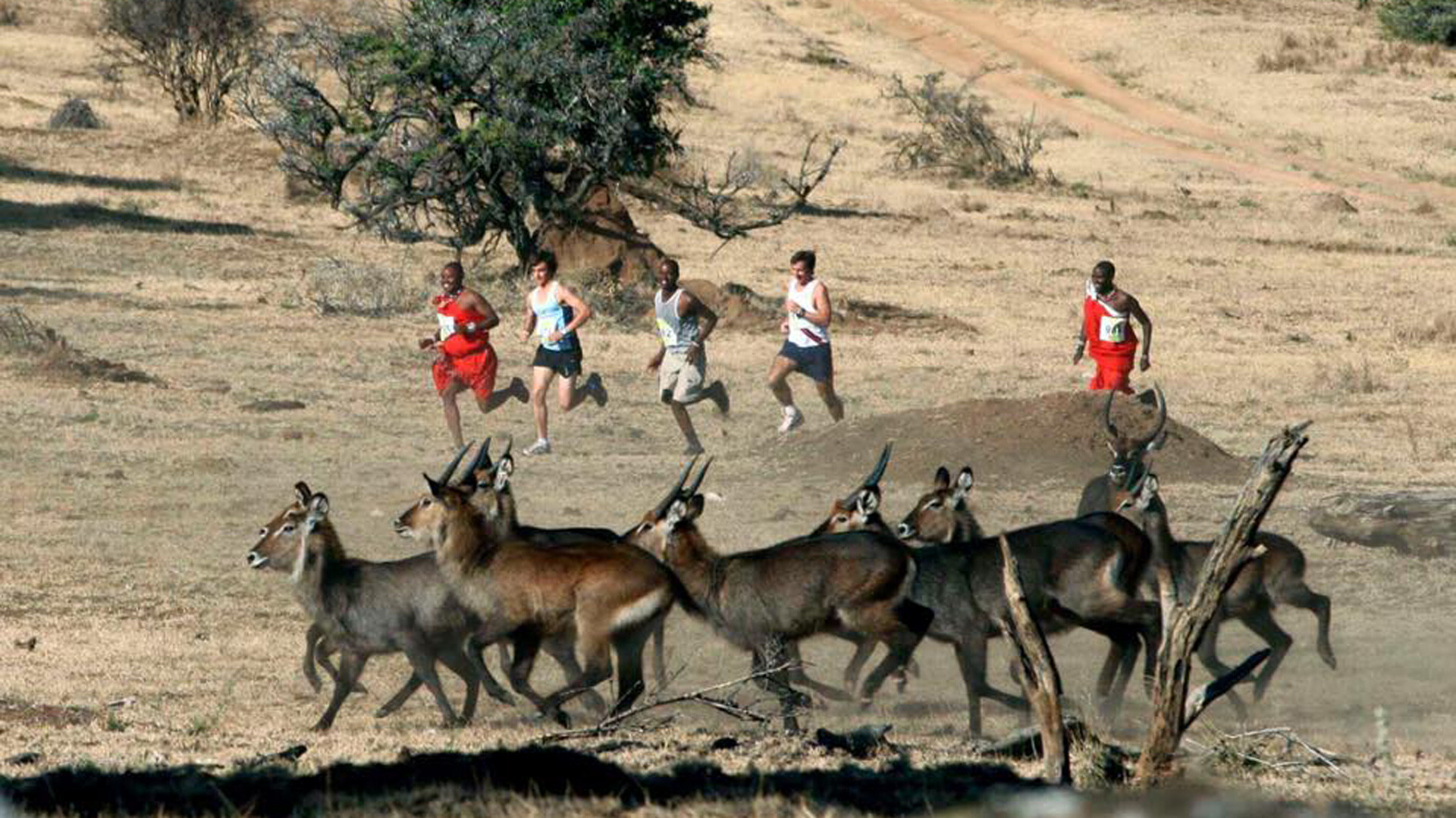
Regarded as one of the toughest marathons in the world, runners of all abilities have taken part – from elite professionals like Marathon World Record Holder Eliud Kipchoge to amateur runners and walkers.
The marathon has also been a vehicle for the advancement of education, healthcare and conservation efforts in Kenya, raising above Ksh982.3 million (USD 8,600,000) for these causes since the year 2000.
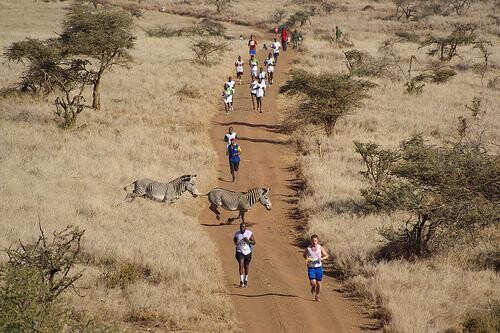
Speaking at the marathon launch, Mike Watson, CEO of the Lewa Wildlife Conservancy said: “While still providing an exciting and exhilarating marathon experience, the Lewa Safari Marathon 2022 aims to be the most environmentally friendly event Lewa has hosted to date.”
“This drive is inspired by the urgent need to reduce our carbon footprint, which aligns with our ethos and standards as we strive to be a model for biodiversity and ecosystem preservation.”
Charlie Mayhew, CEO of Tusk shared, “It’s a joy to be able to bring this one-of-a-kind event back to Kenya. The Lewa Safari Marathon has a 20-year legacy of drawing runners from around the world to raise significant funds for a wide range of conservation, education and community initiatives across Kenya.’
“We are immensely grateful to Safaricom and Huawei once again for their generous sponsorship of the marathon, as well as to Kenya Breweries Limited and Tetra Pak Ltd for their support.”
As lead co-sponsors, Safaricom and Huawei have continued to partner to support the marathon in its evolution. This year, other event sponsors will include Kenya Breweries Limited as well as Tetra Pak Ltd.
(06/10/2022) ⚡AMPSafaricom Lewa Marathon
The first and most distinctive is that it is run on a wildlife conservancy, which is also a UNESCO world heritage site. The Lewa Wildlife Conservancy is home to a number of endangered and threatened species- and also a catalyst for community development for its neighboring communities. For the past 17 years, funds raised from the marathon have gone...
more...Up to 6,000 runners from the Czech Republic and abroad are expected at the start of the Mattoni Olomouc Half Marathon
Sports fans and runners will enjoy Moravia. The biggest out-of-Prague race will take them to Smetanovy sady in Olomouc – a beautiful park that is always full of spectators.
The race will start on Saturday, June 18.
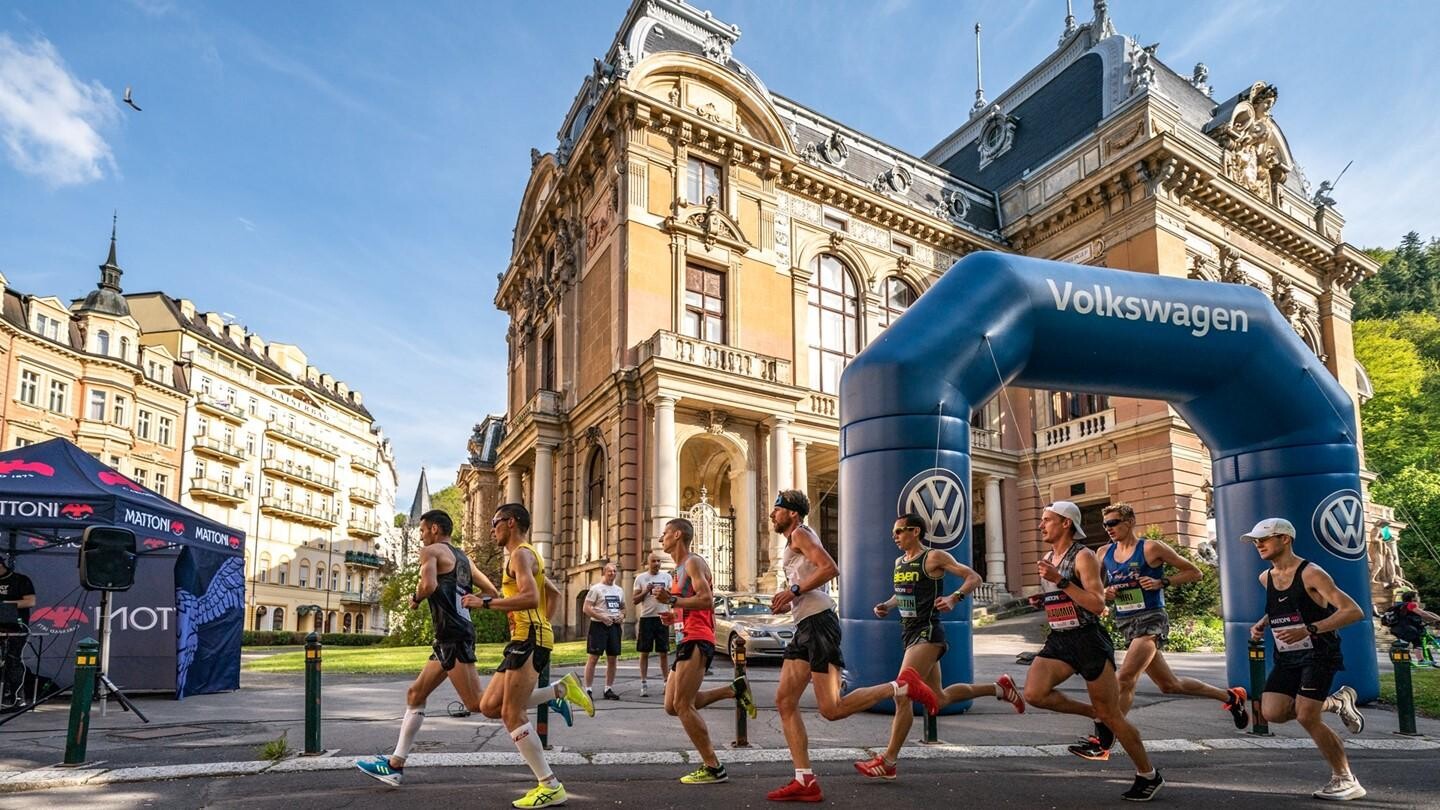
One of the most popular race starts at 7 p.m. from Horní náměstí. The event is a celebration of a healthy lifestyle and a great atmosphere.
“We are always happy to come back to Olomouc, which is part of the historical region of Czech Silesia. Olomouc has a reputation as a race where nothing is impossible and every year brings surprises, especially when it comes to situations where an almost unknown athlete beats far more famous running colleagues,” said Project manager Run Czech Igor Murko.

Mattoni Olomouc Half Marathon has a five-star European Athletics Certificate which guarantees high European standards and qualities. This is also the reason why the race was several times voted the favorite by the runners.
Up to 6,000 runners from the Czech Republic and abroad are expected at the start of the race.
The event offers more categories. In addition to the half marathon, a 2Run is prepared for runners who do not yet feel completely prepared for the whole race.
The relay race is an ideal alternative for team runners. Of course, the traditional dm family run which will start at 5 p.m, is prepared for all family members.
The undemanding 3,5 km long course in the center of Olomouc is really suitable for everybody.
(06/10/2022) ⚡AMPMattoni Olomouc Half Marathon
The annual Mattoni Olomouc Half Marathon takes place in the ancient capital of Moravia. More than 6,000 runners wend their way past Baroque architecture. An experience matched only by the warmth of the welcome runners receive here. Come to Olomouc and Enjoy the sensational atmosphere of running through a charming Baroque city in the heart of Moravia which is one...
more...Five tips for running during allergy season, Enjoy running this summer without sneezing
Temperatures are warming up, flowers are blooming, and allergy season is in full swing. If you suffer from seasonal allergies, you are familiar with the struggle of fitting in regular training while battling a stuffy nose and congested head. Try these suggestions to minimize your allergies and get you out the door in your shorts and running shoes.
Find the right time of day

Both pollen counts and air pollutant indices rise during the day and fall during the night. Running in the very early morning or later in the evening is the best way to avoid those pesky allergens. High pollen counts also trigger exercise-induced asthma, so avoiding those mid-day runs can be critical for easy breathing.
Save the intervals for allergy-free days
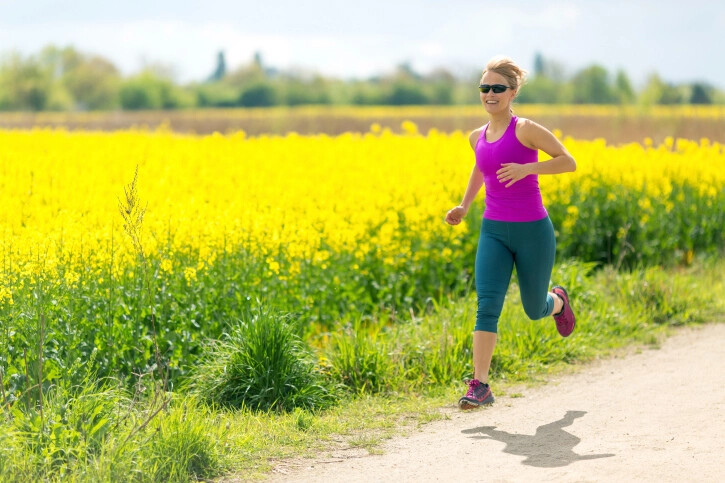
High-intensity workouts that involve breathing hard can exacerbate allergy symptoms. Save your speed workouts for the treadmill or indoor track during allergy season, or plan them for cooler or rainy days. Easy runs, or even a fast walk, will still enable you to get outside and move your body without triggering an allergy attack.
Keep an eye on the weather
Wind and dust will contribute to allergy symptoms; heat can also make them worse. Studies show thunderstorms also concentrate allergens in the air. Running immediately after a thunderstorm or rain is ideal when the air is clear. All runners know how hard it can be to predict the weather in North America but using the weather app and knowing what to avoid can be useful.
Take preventative measures
If you normally take an antihistamine to treat your allergies, taking it pre-run can be effective in keeping symptoms at ease. Similarly, if you have exercise-induced asthma and use an inhaler, check with your doctor to see if you are safe to use it before your workout.
Rinse pollen away
Taking a shower right after running can get rid of any lingering pollen on your hair and skin. Throwing your clothes into the laundry after a run will also keep them free from allergens. With a little extra effort, you should be able to enjoy the sunshine and warmer weather while keeping those sniffles at bay.
(06/10/2022) ⚡AMPby Keeley Milne
Three track Workouts to make you fast, switch up your road intervals with track workouts to improve your top-end speed
World-renowned coach Eric Orton says “I always tell my athletes, don’t confuse difficulty with failure.”
There’s no way around it; speed workouts can be a challenge for both the legs and the mind. Experts tell us that doing hard things is good for us, and if those “hard things” occur on the track, we will increase our racing speed and build mental resilience.

While most training runs are done at a recovery pace, it’s important to keep those fast-twitch muscles firing regularly. Here are three track workouts you can try out for speedwork. Depending on the distance you are training for, and the mileage you’re running, add or subtract intervals from your session.
The ladder workout
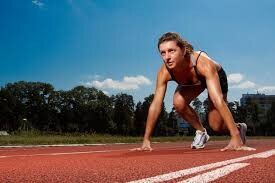
A ladder workout is a classic interval session that can be run on the track or the road. During the workout the intervals move up a ladder, increasing in distance or time with each one. After you’ve mastered the workout below, you can add a 1,600m interval at the top of your ladder, or slightly increase your speed for each rep (start at 5-10 seconds faster than 5K race pace).
Warm-up: 15 minutes easy, drills
Workout: At a 5K race pace, run 1 x 400 metres, 800m, 1,200m, 800m, 400m. Take 2-3 minutes rest between each interval, either jogging or walking slowly
Cool-down: 10 minutes easy
Mixed intervals
Warm-up: 15 minutes easy, drills
Workout: three reps of 400m at 10 to 15 seconds faster than 5K race pace, with two minutes rest between, one rep of 1,000m at 10 seconds faster than 5K race pace, with two minutes rest between, then four reps of 200m sprints with two minutes rest between each one
Cool-down: 10 minutes easy
Short and fast
Warm-up: 15 minutes easy, drills
Workout: 10 reps of 300m sprints, with 30 seconds rest between.
Cool-down: 10 minutes easy
Remember to follow your tough track session with an easy or recovery day, familiarize yourself with the rules of the track, and enjoy that post-hard-run glow.
(06/10/2022) ⚡AMPby Running Magazine
2022 Tacoma’s Sound to Narrows will celebrate 50 years
On Saturday, June 11, thousands of community members will turn out for the 50th annual Sound to Narrows run in Tacoma. This year’s event returns to Vassault Park after two years of being a virtual-only run and includes something for everyone, from the state’s oldest 12K run for all ages to a 20-yard diaper dash for kids.
“For 50 years, Sound to Narrows has been a treasured community event that MultiCare has been proud to support,” said Florence Chang, president of MultiCare. “Being able to celebrate this milestone anniversary with an in-person event makes this year extra special, and so many of us at MultiCare — including myself — are looking forward to being there on race day.”
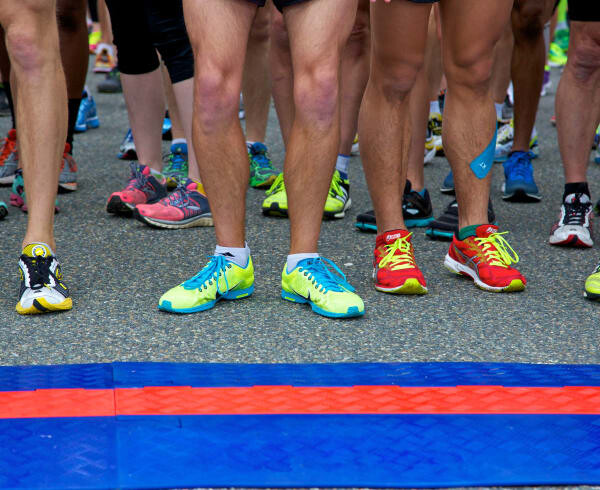
All proceeds from Sound to Narrows will benefit MultiCare Academy for Students in Healthcare (M.A.S.H.) Camp. Formerly known as Nurse Camp, this free, five-day camp introduces local high school students to careers in health care. Students join medical professionals from various disciplines for a first-hand look at the multifaceted world of health care.
Registration starts at $45 for adults and $10 for children participating in the in-person 12K or 5K, and includes a collectable 50th anniversary t-shirt, runner’s bib and Sound to Narrows medal. Entry for students participating in the Fit for Sound to Narrows 2K is $5. There will be a virtual option again this year, for those who want to participate but don’t feel ready for a large, in-person event. The registration fee for the virtual run is $30 and includes bib number, t-shirt and finisher medal.

Check-in starts at 6:30 a.m. at North Vassault and 37th Street in Tacoma, with rolling start times for each event beginning with the 12K walk at 7:30 a.m. The awards ceremony will take place at 9:45 a.m. Runners participating in the event virtually will not be eligible for awards.
Whether it’s the signature 12K route with challenging hills and spectacular water views or the fast and flatter 5k route, Sound to Narrows aims to make physical fitness inclusive for the greater Puget Sound community.
Sound to Narrows is sponsored by Pacific Source Health Plans, TRA Medical Imaging, Olympic Sports & Spine, Tacoma Rainiers, South Sound Running and Tacoma Public Utilities. For more information and to register, visit soundtonarrows.org.
(06/09/2022) ⚡AMPSound to Narrows
Washington State's Oldest 12k. The Sound Narrows is the South Sound's kick-off to summer. Choose from the state's oldest 12k, or our fast and challenging 5k routes. After your race, enjoy a slew of vendors, fun bands, and camaraderie with fellow participants. ...
more...46th annual Bellin Run brings back in-person event after 2 years of virtual races
After two years of being held virtually because of the COVID-19 pandemic, the 46th annual Bellin Run will return as an in-person event on Saturday while still offering a virtual option.
The 10-kilometer (6.2-mile) race, one of the largest in the nation, has been held on Green Bay's east side since 1977, attracting thousands of runners, walkers and wheelchair athletes each year.
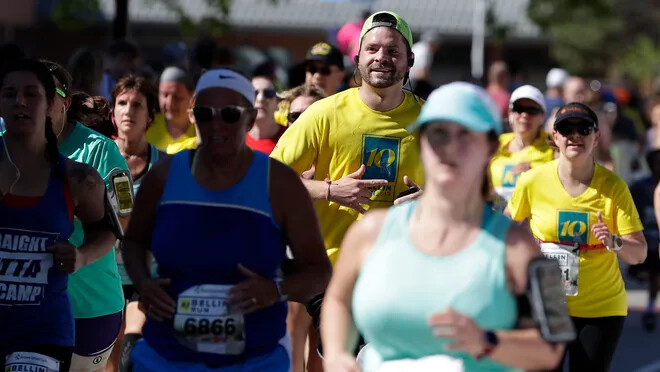
“The whole mission of this event is in alignment with Bellin Health’s mission of getting people healthy," said assistant race director Linda Maxwell. "We know that being active is very important in being healthy, and that people need goals. So that’s why we do this event.”
With this mission in mind and knowing the excitement and motivation that an in-person race day brings, the Bellin Run organizers found it important to get people back out and together.
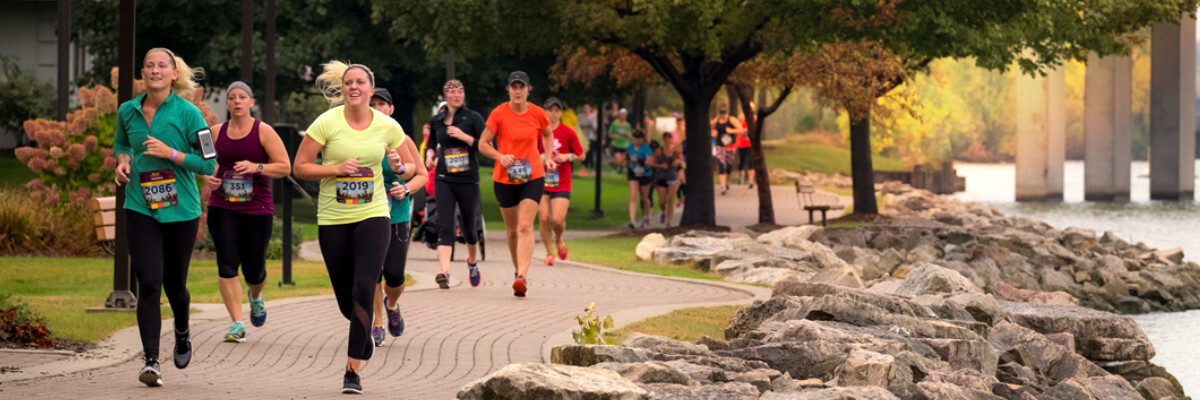
They still wanted to keep a virtual option, however, for people who may be out of town, busy during the race time, or not comfortable being in crowds yet.
In April 2020, the Bellin Run was converted to a virtual-only event amid the growing COVID-19 pandemic. Participants completed the race anytime and anywhere, submitting their results electronically. Despite hopes of returning to an in-person event in 2021, organizers determined that a virtual event was again the only safe option.
When the time came to decide the approach for this year's event, organizers were confident they could hold it safely in-person, especially because everything, including race packet pickup, takes place outside.
“Outdoor transmission continues to be extremely rare, and I feel great about where we are at as a community," said Dr. Bradley Burmeister, an emergency physician at Bellin Hospital. "I look forward to the return of the in-person Bellin Run and getting feet on the street in honor of heart health.”
As of Friday, the Brown County COVID-19 community level was low.
Around 6,000 participants have registered for this year's Bellin Run so far, 1,000 of whom are for the virtual option. Maxwell said they are expecting a couple thousand more registrations in the week leading up to the event.
These registration numbers are down from 2019, the last in-person race, which had more than 11,000 participants. According to Maxwell, this was expected, as people are out of their pre-pandemic habits and just starting to make their way back to the things they used to do.
This slow return to pre-pandemic habits is also reflected in volunteer registrations. More volunteers are still needed, especially on course corners to keep participants safe during the race.
(06/09/2022) ⚡AMPby Kelly Smiths
Bellin 10k Run
The Bellin Run, a 10K held annually in Green Bay, Wisconsin on the second Saturday in June, is one of the region’s premier sporting events and has grown to be one of the largest 10K races in the nation. The event was first held on June 12, 1977, and was known as the Bellin Heartwarming Run, to promote cardiovascular fitness....
more...What are the worst running habits?
In running, it’s easy to cut corners to get you closer to achieving your goal. Sometimes the stress of race day success can overwhelm you during training. Some habits are worse than others, but all bad habits can be a slippery slope to falling short of your objective. Here is our list of running habits you need to break.
Pushing too hard on recovery runs
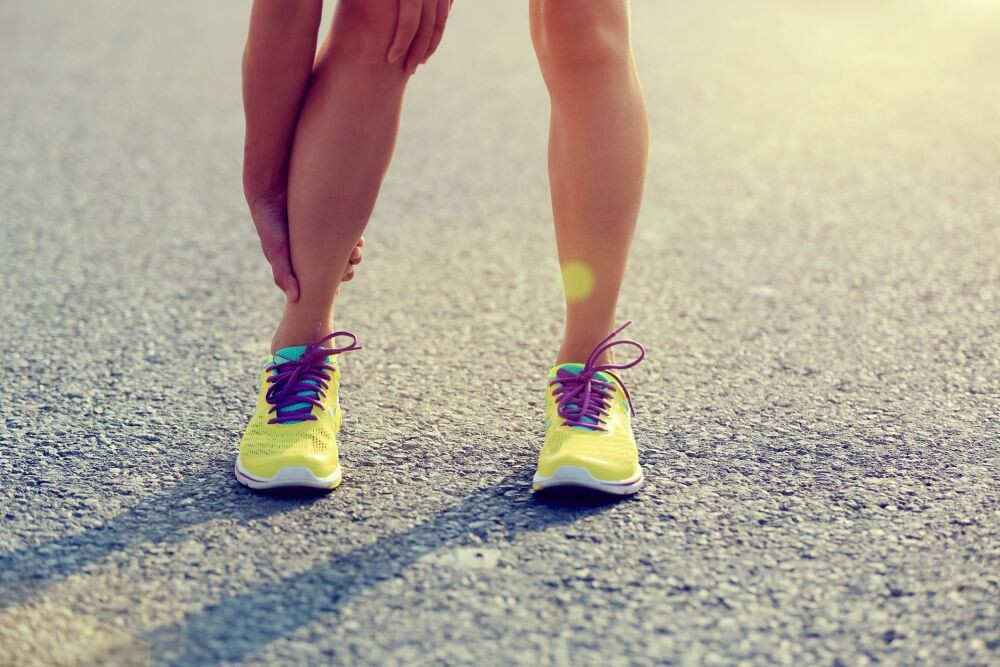
Your coach assigned a 40-minute recovery run and asked you to keep your heart rate under 140. Instead, you go out and see how much distance you can cover in 40 minutes. A recovery run shouldn’t be a time trial, and if you’re treating them this way, it can only lead to injury or fatigue.
Recovery runs are some of the most important days in your training schedule. They are there to allow your body to heal from harder days. Resist the urge to push the pace, as it will only damage your racing aspirations.
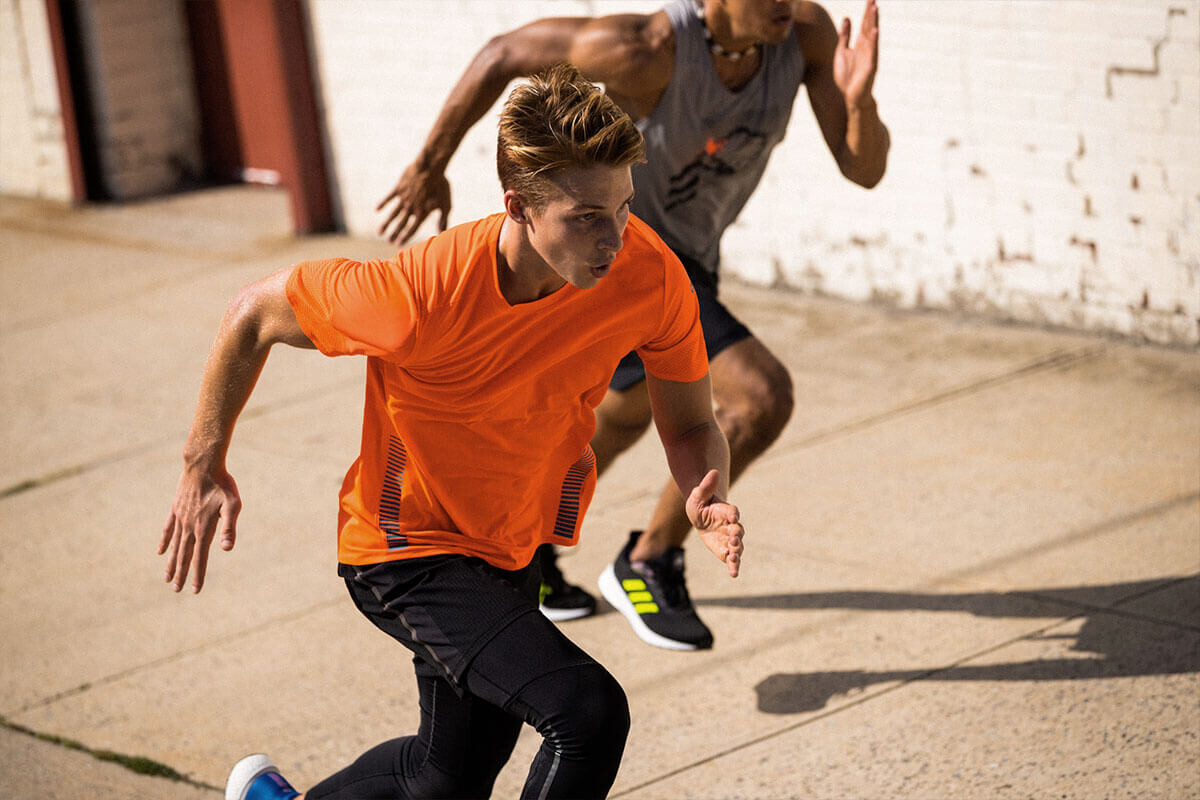
No warm-up, no activation
There have been a few scholarly publications on how a warm-up or static stretching may not be as beneficial as you think it is, but dynamic stretching has been proven as a great way to get your heart pumping before a run. Some examples of dynamic stretching are leg swings, butt kicks, high knees and arms swings. The purpose of these stretches is to replicate the running motion without the same intensity or stress to avoid injury.
Injured but still training (overtraining)
If you are suffering from any pain or discomfort, it’s better to rest than to make things worse. Missing one or two days of training may seem like the end of the world amidst a marathon build, but at the end of the day, it won’t do any harm to your training.
Cutting things short
Don’t take the easy way out in achieving your goal by cutting the course or cutting a workout short. You have to live with the repercussions knowing that you took the easy way out and some runners will judge you for it. The aged training philosophy of “you get out, what you put in” still has relevance in this sport.
Going out too fast
The most common bad habit in running is starting too fast and then tapering off. This is a mistake all runners have made from the professional to amateur level. Try to settle in the first few minutes of your race, then speed up if your body is feeling good later on. If you’ve got gas left in the tank near the end, push it!
Comparing yourself to others
No matter the setting, it’s easy to compare your training or speed to other runners on the same team or Strava. When the urge to compare grabs you, try and remember who you’re running for. The reason you run is for you, not for so and so.
(06/09/2022) ⚡AMPby Marley Dickinson
Meditation for runners
Sitting motionless in a room for an extended period of time might seem like an odd way to improve your running, but meditation is a tool used by some of the world’s best runners to take them to the next level.
Two-time Western States champion Timmy Olhsen uses meditation as a central tenant of his training. Two-time OCC champion Ruth Croft has gone on week-long silent meditation retreats.

Here are some ways to get started:
Why meditate?

There are a number of benefits for runners. Firstly, it can help you concentrate or to “stay present”. This is particularly useful if you have a specific split or pace in mind. Over the course of a 5km, 10km or even a marathon it can be easy for your mind to drift and for you to unwittingly slow down. But if you are “present”, you can focus on keeping your legs spinning.
Conversely, mediation can distract you. If you are battling through a low point on a 100km race, you can use meditation techniques honed at home to focus on your breathing rather than your ailing body. You can refocus to the moment and forget about what is to come and the negative thoughts circling in your head.
Meditation lowers anxiety in general. Being less stressed will help your training in general because you will find it easier to stick to a routine and waste less mental energy so you can push yourself during the session. It will also help you relax and sleep, so your body can recover in full.
Where to start?
It can be hard to know where to start. Do you just sit down with crossed legs and float away in your mind’s eye to distant peaks? There are loads of meditation apps for beginners and you can plug in and listen to instructions for short five-minute bursts and build from there.
(06/08/2022) ⚡AMPby Colorado Runner
2022 Valencia Marathon exhausts its 30,000 numbers six months before the event
The 42nd edition of the Trinidad Alfonso Valencia Marathon has exhausted its 30,000 bibs six months before the event, which will be held on December 4, according to the organization of the event in a statement this Wednesday.
It is the fourth consecutive time that the organization of the race, in charge of the SD Correcaminos and the Valencia City Council, exhausts the numbers to participate in the test. The first was in 2018, when 22,000 seats were put up for sale; the second in 2019, with 25,000, and the third in 2020, an edition that could not be carried out due to the pandemic, but which sold out three months after opening the 30,000 registrations for the race.

Of the 30,000 participants registered for this edition, 48 percent are foreigners, representing a total of 115 different nationalities. In addition, 28 percent are runners from the Valencian Community and 24 percent will arrive in Valencia from other Spanish regions.
In addition, 19 percent are women, which is why the number of female participation in the event continues to increase, both in percentage terms and globally, as the number of bib numbers available has also grown. Finally, more than 6,000 participants (21 percent) have chosen this test to debut at this distance.

“This year we are back with everything and it makes us very happy to be able to say that there are no bib numbers left, because that shows that the runners continue to trust us”, explained the president of SD Correcaminos, Paco Borao.
For runners who still wish to participate in the test, a waiting list has been opened to meet these requests, which will be covered as athletes already registered request a withdrawal due to injury or by making use of the return insurance if they contracted it in your registration.
(06/08/2022) ⚡AMPby George Williams
VALENCIA TRINIDAD ALFONSO
The Trinidad Alfonso EDP Valencia Marathon is held annually in the historic city of Valencia which, with its entirely flat circuit and perfect November temperature, averaging between 12-17 degrees, represents the ideal setting for hosting such a long-distance sporting challenge. This, coupled with the most incomparable of settings, makes the Valencia Marathon, Valencia, one of the most important events in...
more...A simple tempo workout to add to any routine
Does the perfect running workout exist? Regardless of your end goal, most training programs involve a combination of easy runs and a mixture of speed-work, hill intervals, or longer runs (and maybe all three). Workouts will vary from runner to runner and depend on goals, but most training plans involve tempo runs of some kind.
The optimal amount of tempo work is a hotly debated topic, but we do know incorporating some form of tempo workout into your routine is beneficial. Make sure to follow any tempo run or interval session with an easy or rest day.
Here’s a tempo workout to add to almost any repertoire. David Roche, co-author (alongside his wife Megan Roche) of The Happy Runner, calls this tempo workout a good “bread and butter” addition to any running regime. Roche, a renowned athlete and coach, touts the benefits of maintaining lifelong running goals and positivity.
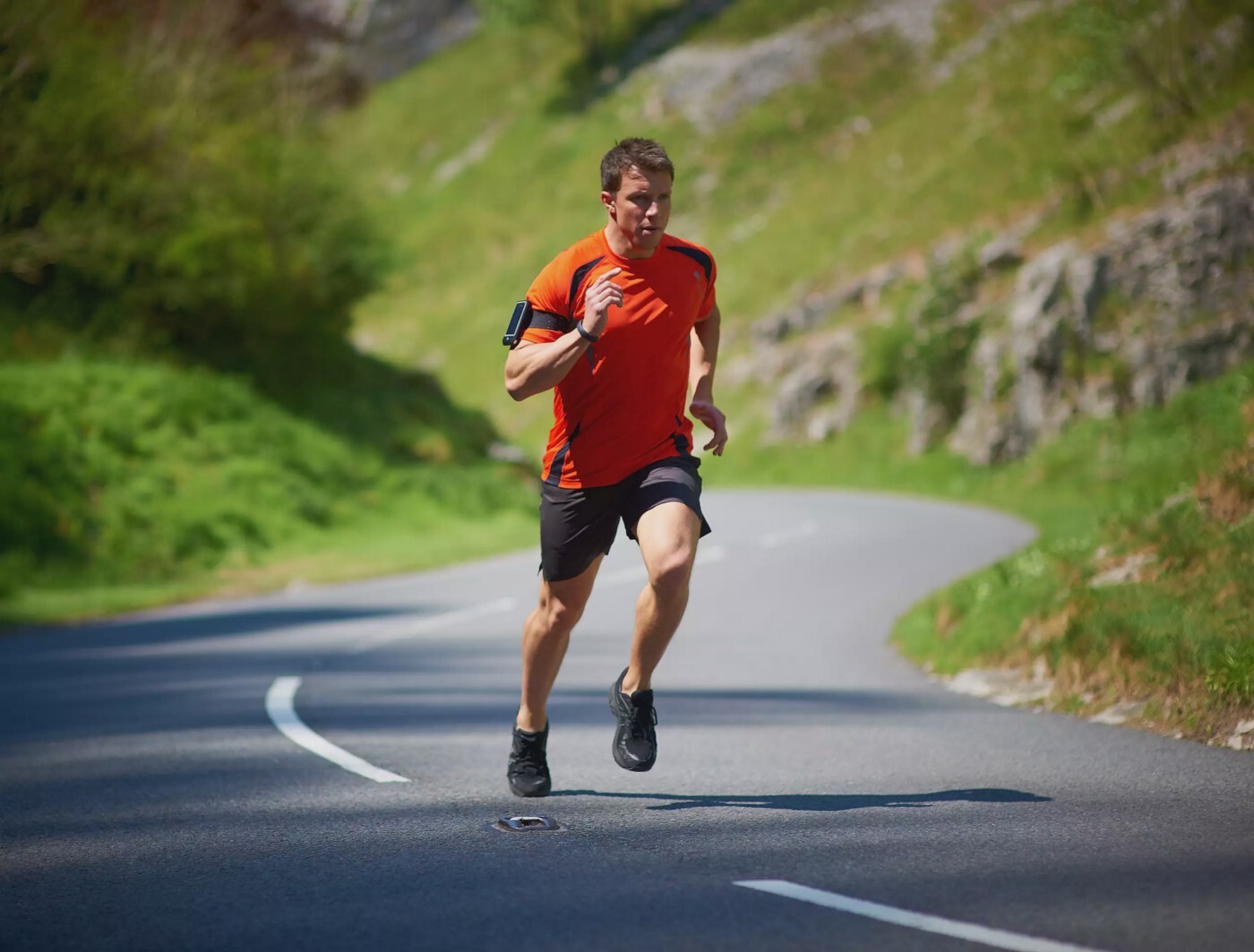
Warm-up
3-5 km easy, with drills like this warm-up demonstrated by Roche.
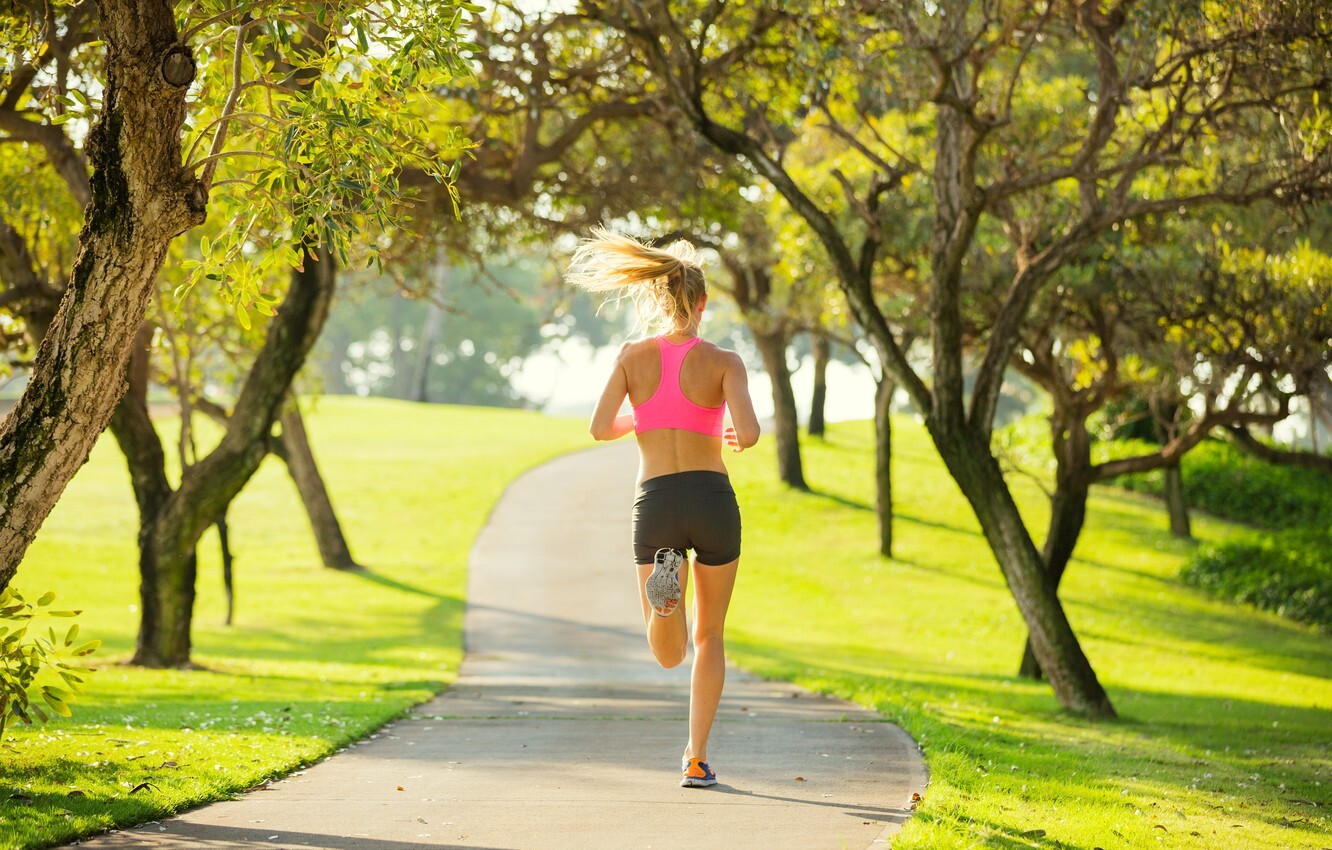
Workout
10 x 3 min at 10 km effort with 1 min easy recovery, running intervals as smoothly and consistently as possible.
Cool-down
3 km easy.
This tempo run can be done as a stand-alone, or with post-run strength exercises to finish off the legs.
A tempo pace should be challenging, but not so hard that you can’t speak. The intervals in this workout can be adjusted by upping the intensity to make a harder speed-day leg-burner, or done uphill if you’re preparing for a hilly race.
(06/08/2022) ⚡AMPby Keeley Milne


